Come on folks ... let's begin an 'Image of the Day' topic. I'll begin by posting an image of Pulsatilla vernalis.
Who will follow this up tomorrow?
PULSATILLA VERNALIS
Comments
Re: Image of the day
Many thanks Rick. The Spring Pasque Flower is one of my favorite plants and one of the absolute gems of the high altitude snow melt zones in the European Alps. Not difficult to germinate if the seed is fresh the resultant seedlings can be quite variable but usually worth persisting with until flowering. Please do not be tempted to pamper these seedlings in any way.
Re: Image of the day
It grows here in a state of virtual neglect out in the front yard - no special care or attention at all. Mine are white-flowered, re. the variability that was mentioned. Seed starting was straight-forward - easy, warm germinator.
Re: Image of the day
Great idea Cliff and to keep the ball rolling I offer this. Its Rhodothamnus chamaecistus, not in cultivation, but photographed in the mountains of western Slovenia. I just think it is beautiful.
Re: Image of the day
Another of my all time favorite plants, Malcolm and one that we are fortunate enough to see thriving in the Dolomites each year (and flowering, but not as well, in large pots in my garden).
Beautiful image of a super plant. Who will rise to the challenge tomorrow?
Re: Image of the day
Great idea Cliff and to keep the ball rolling I offer this. Its Rhodothamnus chamaecistus, not in cultivation, but photographed in the mountains of western Slovenia. I just think it is beautiful.
This plant is one of the real charmers of the Ericaceae.... my favourite plant family.... and your photo shows it in peak condition, Malcolm.
Still under snow here in Aberdeen, so such pictures are a treat!
Maggi Young
Re: Image of the day
And its intriguing because it's a limestone plant, unlike most of the Ericaceae!
Re: Image of the day
What a wonderful plant! I'd love to try one in Newfoundland...we are the king of ericaceous plants when it comes to natives...however, if Rhodothamnus needs lime it might not be happy here.
Re: Image of the day
I don't think its too fussy in cultivation, just in the wild, as I understand it.
Re: Image of the day
That Townsendia condensata is one of my favourite, the flower is 5cm in size, soft hairy leaves, fast grower in sunny very dry place, unfortunately monocarpic. I just like it - looks like a soft ball.
Re: Image of the day
is this photograph of wild plants, or are they ones you are growing in Poland? They are very nice - quite charming.
Re: Image of the day
I have seeds of this one to try this year...yes it's too bad they are so short-lived. makes for a lot of work to keep them going year to year.
Re: Image of the day
Townsendia grows rather easily in the sunniest part of our Arboretum Rock Garden. We've had no expreience with condensata at the Arboretum, though. I think hookeri or maybe montana. I don't know if any of our Minnesota Chapter members have tried T. condensata. We will certainly keep it in mind! Thanks for the photo.
Re: Image of the day
is this photograph of wild plants, or are they ones you are growing in Poland? They are very nice - quite charming.
This is photo from my garden, plants are located under roof overhangs by my house in pure granite gravel. In regular conditions in my garden it would rot off very quickly.
Re: Image of the day
I have seeds of this one to try this year...yes it's too bad they are so short-lived. makes for a lot of work to keep them going year to year.
It may be much easier to keep it going by immediate sowing. I've done it last year just after seed ripening and new seedlings shot after a couple of weeks in the same place. Now new plants are of 2cm size but probably 'll be flowering next year.
Re: Image of the day
Pretty plant from the Dolomites for today's image ... the gorgeous honey-scented Thlaspi rotundifolium.
THLASPI ROTUNDIFOLIUM
Re: Image of the day
Hello to all. Greetings from north central Tennessee. Pouring rain here today. Attached is one of my favorite Cornus shot at Cataract Falls, Avalon Peninsula, Newfoundland Summer 2007. Actually Todd it was the day my wife & I visited you in St. John's.
Great job with the website. I'm still learning how to use it ;D
Regards to all, Paul H. Schneider, Eastern Sun Studio & Gardens, Portland, TN
Re: Image of the day
Welcome to the forum, Paul!
As a kid who spent nearly every summer weekend in wild northern Minnesota near the Ontario border, I am very familiar with this species. Back then I dismissed it as "boring", since many other more "interesting" flora abounded in the area - pitcher plants, sundews, more than a dozen species of orchids, etc.
But I have now become rather fond of Cornus canadensis, and have seen it native in a few places in southern Minnesota, too.
Re: Image of the day
Cornus canadensis is perhaps THE most common woodland plant in Newfoundland...we also have Cornus suecica which is equally as nice.
Great looking Thlaspi Cliff!
Re: Image of the day
Welcome to the forum, Paul!
As a kid who spent nearly every summer weekend in wild northern Minnesota near the Ontario border, I am very familiar with this species. Back then I dismissed it as "boring", since many other more "interesting" flora abounded in the area - pitcher plants, sundews, more than a dozen species of orchids, etc.
But I have now become rather fond of Cornus canadensis, and have seen it native in a few places in southern Minnesota, too.
Thanks Rick, I grew up in northern NY near the Vermont border. We could find C. canadensis occasionally, usually in Vt. or NH. With clay soil & thuggish summer heat here in north central TN, it is one that I doubt would be very happy.
Re: Image of the day
Here is my contribution to plant of the day...Diapensia lapponica...creme de la creme of our native alpines but extremely difficult to grow in cultivation. We have a single plant in the Memorial University Botanical Garden alpine house that is now 3 years and going...every one we tried outside died within weeks. This picture is in the wild where they are actually reasonably common in Newfoundland.
Re: Image of the day
Gorgeous photos, all!
Very interesting, Todd. What do you suppose is the critical difference between the alpine house and outdoors in your location, as opposed to where the plant grows in nature?
Lori
Re: Image of the day
Outside I think it gets too hot where our BG is close to sea-level. The alpine house is lightly shaded so the heat is not nearly as intense. In the wild, Diapensia grows in open, windy areas that are often foggy thus intense heat is not a problem. St. John's is far from hot but relatively speaking we are hotter than where Diapensia would normally grow.
Re: Image of the day
An image from an Alpine Garden Society Show (at Blackpool, Lancashire, U.K. in March 2009) of a fine Saxifraga 'Lismore Carmine'.
SAXIFRAGA 'LISMORE CARMINE'
Re: Image of the day
This is one of the most popular of the cultivars which has appeared in the last 20 years and this is one of those depressingly beautiful specimens that some people manage to take to alpine plant shows!
Re: Image of the day
I thought I'd post this picture of Allium crenulatum. It's taken in the Olympic Mountains, Washington State, and I thought it was so attractive against the dark shale. I'll post another picture in the Bulbs section as well.
Re: Image of the day
Stunning Allium Malcolm...I have lots of Allium in the garden but I have not tried that species.
That is a wonderful saxifrage Cliff but growing in an alpine house seems like cheating. If it looked like that outdoors, then I'd be REALLY impressed.
Re: Image of the day
This picture is from a few years ago and the whole thing has now gone but for four or five years it was as good as this. So it can be good outside.
'Lismore Carmine' is halfway down on the left hand side and round the right hand side there is 'Lismore Pink' which I think is even more beautiful. They are both hybrids involving Saxifraga georgei and really want a slightly more moist atmosphere than is typical here. We're not fantastically cold, or fantastically hot (often at least) but we are often very dry which is usually the determining factor for what does well long term.
I would think Newfoundland might be ideal for this sort of saxifrage.
Re: Image of the day
Hi Todd and Malcolm,
I must begin by stating that the Sax' wasn't mine - simply another image captured at an AGS national show - but it may not have been grown in an alpine house - perhaps in a frame, perhaps simply covered with a sheet of glass to protect it at flowering time?
As Malcolm's image superbly illustrates these wonderful sax's can be grown and flowered extremely well outside (here in northern England anyway) and really, the use of an alpine house is little different to protecting the plant with glass. Temperatures in an unheated greenhouse (in the depths of winter anyway) are seldom much greater than outside.
Greatly looking forward to meeting you in May, Todd - will be in touch by personal mail as soon as all the details are to hand. If you could order a little sunshine in advance please? :D
Re: Image of the day
Those saxes from outside are impressive! Yes, we can do fairly well with Kabschias, but they still do best in troughs or tufa rather than in the open garden...frost heaving is terrible in this climate but tufa/trough plants don't seem to suffer.
Here is one of my troughs...albeit with not too many blooming at the time.
Re: Image of the day
What terrific-looking troughs (both Malcolm's and Todd's)! Seeing those, I'm compelled to renovate mine yet again...
To brighten this winter day a little, here is an alpine potentilla species from Kananaskis Prov. Park, eastern slope Rockies... (I have posted a photo of what I believe to be the same species in the ID forum, and I hope someone can identify it.)
Re: Image of the day
That's an exquisite Potentilla Lori.....there are not too many alpinish types in Alberta. Leaves remind me of nivea but the flowers are much larger than our local form of nivea.
Re: Image of the day
Yes, I love seeing them!
Well, even with not that many to choose from, I'm getting totally confused - the alpine potentillas with trifoliate leaves that occur here are P. hyparctica, P. nivea, P.ovina (3 to 5 leaflets), P. uniflora and P. villosa (according to Moss & Packer)... Help! ;D
(P.S. Oops, forgot P. hookeriana too, with 3-5 leaflets... ackk!)
Re: Image of the day
Hmmm, what to post, what to post...
Okay, here's Polemonium confertum, confined, sadly to a trough, and so far from its home in the Colorado Rockies.
I'd truly LOVE to see some pix of this growing in situ, to appreciate its full glory in a beautiful setting... Will any of the American alpine gardeners/hikers take up this challenge and show us some??? ;)
Re: Image of the day
What, no one to take up the challenge? How unfortunate...
Here is Anemone parviflora, one of the species that blooms just after the snow melt in the eastern slope Rockies.
Re: Image of the day
Polemonium are among my favourites but I can't seem to keep the alpine types going for more than a year or two. Must say I've never grown P. confertum.
Anemone parviflora is a common alpine along the limestone barrens of northern Newfoundland where they bloom from late June through July.
Re: Image of the day
Judging from the photo record, it looks like I probably got Polemonium confertum in 2007 (from Beaver Creek) so it will be interesting to see how much longer it lasts. I did notice last summer that there are little offsets coming up around it in the trough.
Re: Image of the day
Beautiful images folks ... can we encourage more members to post?
An outcrop in the Dolomites that would grace any garden.
Snowing lightly again here in Lancashire, England.
Re: Image of the day
Hi Lori,
The darker pink is just another colour form of Silene acaulis and the cream-yellow is a Saxifraga (probably) caesia.
Re: Image of the day
Cliff that image in the Dolomites is stunning. Trond, your Kenyan (?) image is otherworldly!
Re: Image of the day
Many thanks Todd - hopefully you might enjoy a few more images from these magnificent mountains on 5th May? :D
Armeria maritima alpina
Re: Image of the day
I haven't been to the Dolomites but I am dreaming of trek there some time.
And Todd, I forgot to say it is from Mt Kenya, Kenya.
I have never been so cold as when lying in a wet sleeping-bag high up in the mountain under the equatorial stars waiting for starting to walk early in the morning! But the vistas and the otherworldly (yes, exactly the right word!) plants made up for cold nights. (I am used to sleep outside in the winter here in Norway, but my sleeping-bag got soaking wet and took time to dry.)
Re: Image of the day
Image for today: Anemone narcissiflora in Maritime Alps - maybe it is not my favourite plant but in nature it looks fabulous in high alpine meadows - photo taken on 2000m on limestone ridge. It takes me back there to warm summer in our black-and-white too long winter. :)
Re: Image of the day
What a beautiful sight, Michal! Thanks for posting it.
Re: Image of the day
This Gladiolus we found growing in almost pure volcanic rock a few places on Mt Kenya. Don't know the species. Anybody who has suggestions?
Re: Image of the day
I love all these Kenyans! I don't have a copy of Goldblatt's Glads north of S Africa, but I have a hunch this would be in there: what a wonderful color! Sunbird pollinated, I suspect.
My image is closer to home: Paeonia cambessedessii blooming with Gentiana acaulis in my home rock garden. This plant is my pride and joy: obtained five or six years ago from Arrowhead Alpines: it flowers so early that the flowers last for several weeks. It's a little bit too big for a classic rock garden, perhaps. But I am really bad at rules.
I always arrange a little party at my house when these are in bloom...it's fun to hear the little yelps as people walk around the bend and see these...
Re: Image of the day
Panayoti, you're killing me with that peony!
Re: Image of the day
Magnificent combination, Panayoti ... thanks for posting.
Re: Image of the day
This Gladiolus we found growing in almost pure volcanic rock a few places on Mt Kenya. Don't know the species. Anybody who has suggestions?
Trond, I posted links to both of your photos to the Pacific Bulb Society group, and I have an answer for you, it is Gladiolus watsonioides. See the following two responses, there are some cultivation clues.
Response from John Grimshaw, Gloucestershire, UK:
This is Gladiolus watsonioides in its finest form, once known as G.
mackinderi. It is one of the outstanding plants of Mt Kenya.
I am currently selecting images for my talk 'Switchbacks Yes, Suburbs No:
Alpines in Tropical Africa' which I'll be presenting at the NARGS Western
Winter Study Weekend in Medford, Oregon, on Saturday March 6th - more
details available from:
http://www.nargs.org/images/stories/wwsw/west10home.html
Gladiolus watsonioides will be one of the plants I'll be speaking about.
Response from Ernie DeMarie, Tuckahoe NY:
It is Gladiolus watsonioides, which I remember well from some material a prof
brought back from a trip to Kenya and gave to me back when I was doing my thesis
work (on pelargonium species tissue culture) at Cornell. I grew it there and at
NYBG for many years, it never really goes dormant in the sense that it does not
like to go bone dry for long periods of time. It makes scads of cormlets and is
self fertile. In a cool greenhouse it tended to flower in summer. A very
pretty plant and not terribly difficult to grow.
Re: Image of the day
In keeping with the Gladiolus theme, here is G. saundersii growing at our BG in Newfoundland. It is proving very hardy and reliable, blooming in September-October.
Re: Image of the day
Aaaaah, Todd. You warm the cockles of my heart with the Gladiolus saundersii. It brings sweet memories of the Drakensberg back to me. I have seen this quite a few places in Lesotho, although my first encounter was in March of 1997 with Jim Archibald on that magnificent place, Joubert's Pass, in the Witteberg spur of the Drakensberg. We saw both G. saundersii andG. dalenii growing along the road. It was a particularly tall, stunning form of dalenii. , which we thought we found in seed as well: the seed all turned out to be saundersii when grown on. Oh well!
There are probably a few dozen wonderful Glads in the Drakensberg, but my favorite South African glad has to be G. alatus, that grows in vast colonies in the West Cape (probably not very frost hardy). It does have some look alike cousins that make it up to the colder karoo, so we can dream, perhaps, of one day taming this. Although it does run at the root (tut! tut!) This picture was taken on a field trip out of that enchanting town of Franschoek.
Re: Image of the day
This image is from the "cover" of the second issue of the online magazine International Rock Gardener....
main page here: http://www.srgc.org.uk/logs/index.php?log=international
Bringing rock gardeners from around the world together...... 8)
Cover photo is by Zdenek Zvolánek of Iris rosenbachiana f. nicolai ´Cormozak´ in his Czech garden.
Re: Image of the day
This image is from the "cover" of the second issue of the online magazine International Rock Gardener....
main page here: http://www.srgc.org.uk/logs/index.php?log=international
Bringing rock gardeners from around the world together...... 8)
Cover photo is by Zdenek Zvolánek of Iris rosenbachiana f. nicolai ´Cormozak´ in his Czech garden.
Ian and/or Maggi, that's a stunning Iris and a stunningly crisp photograph, indeed an image for the day... a welcome sight on this cold gloomy snowy-rainy day. :)
Re: Image of the day
cold gloom snowy-rainy day.
You having that kind of weather too, eh? Horrible, isn't it? Thank goodness for sunny flower pictures to transport us to a better place!
ZZ is still having too much winter, as well.... I think we're all a bit fed up of it in the Northern Hemisphere, right now!
Glad you like the photo... it enlarges well for the pdf., I posted a reduced version here.
PS: It's Maggi aboard at the moment, by the way....after midnight here and the Boss is fast asleep :)
Re: Image of the day
That is a fantastic a pic of a fantastic form! I have seed of Iris rosenbachiana. Let's hope for the best . . .
Mark, you are just way to creative with the avatar function here. I suppose I could at least get a crayon and color mine in. :)
Re: Image of the day
Mark, you are just way to creative with the avatar function here. I suppose I could at least get a crayon and color mine in. :)
Well, I cut my teeth doing avatar fun on the Scottish forum. What can I say, I'm unemployed, have lots of time on my hands during winter months, and I like to goof around and keep things lively, one of the fun aspects of being on a wiki-powered-blog-Forum such as this. On your avatar, I'd like to see Audrey II start moving! Here we have a plant "Image of the Day", but I keep pace with an Avatar of the Day as well.
Re: Image of the day
Omigod, Marko! Hope you didn't use that Galanthoavatar on the SRGC site: they'd all be wanting seed and adding it to their collections! ;D
Re: Image of the day
Well my avatar is a bit squished and I don't know why...where's Hugh?
That iris is to die for...but another that would not like the aquatic alpine conditions I have to contend with.
Re: Image of the day
This Gladiolus we found growing in almost pure volcanic rock a few places on Mt Kenya. Don't know the species. Anybody who has suggestions?
Trond, I posted links to both of your photos to the Pacific Bulb Society group, and I have an answer for you, it is Gladiolus watsonioides. See the following two responses, there are some cultivation clues.
Response from John Grimshaw, Gloucestershire, UK:
This is Gladiolus watsonioides in its finest form, once known as G.
mackinderi. It is one of the outstanding plants of Mt Kenya.I am currently selecting images for my talk 'Switchbacks Yes, Suburbs No:
Alpines in Tropical Africa' which I'll be presenting at the NARGS Western
Winter Study Weekend in Medford, Oregon, on Saturday March 6th - more
details available from:
http://www.nargs.org/images/stories/wwsw/west10home.html
Gladiolus watsonioides will be one of the plants I'll be speaking about.Response from Ernie DeMarie, Tuckahoe NY:
It is Gladiolus watsonioides, which I remember well from some material a prof
brought back from a trip to Kenya and gave to me back when I was doing my thesis
work (on pelargonium species tissue culture) at Cornell. I grew it there and at
NYBG for many years, it never really goes dormant in the sense that it does not
like to go bone dry for long periods of time. It makes scads of cormlets and is
self fertile. In a cool greenhouse it tended to flower in summer. A very
pretty plant and not terribly difficult to grow.
Hello folks, I am back! Been offline for a week (skiing cross country in the mountains).
Thanks Mark, I have registered the name! Watsonioides is an appropriate name, the glad reminded me of Watsionias i saw in South Africa.
Re: Image of the day
In case anyone is wondering, I just edited the colour of the text in the quote above, so that it was visible against the white background... my first official act as moderator. 8)
Re: Image of the day
Sounds like a wonderful trip, Trond. I assume it was back-country skiing, as opposed to track-set routes? I hope you were able to take some photos!
Here's a scenery-based photo for today... the subalpine-alpine meadows of Healy Pass in Banff National Park, which can filled with Erythronium grandiflorum around the July 1st weekend in a good bloom year.
Re: Image of the day
Sounds like a wonderful trip, Trond. I assume it was back-country skiing, as opposed to track-set routes? I hope you were able to take some photos!
Not back-country this time! We had to follow tracks as the snow was very unfirm. Even with skis you sank 1m deep due to no mild weather at all since the first snowfall. We have a small cabin at the timberline - it is not alpine, more an undulating plane with no high peaks, just piggybacks! Furthermore it was cold, about -20 oC and I did not bring my camera either! (My wife had hers.)
Here's how the landscape looks like 1100-1200m (last spring and last fall):
Re: Image of the day
I like your Banff picture, Lori! The Banff area seems to be worth making acquaintance with! And I should love to beheld Erythroniums in situ. I have some selections in my garden and they behave quite well.
Re: Image of the day
What a fascinating area, Trond! Would the word "tundra" be an apt description?
Re: Image of the day
What a fascinating area, Trond! Would the word "tundra" be an apt description?
Maybe it looks a little like tundra, but it is not. It is no permafrost and one of the reasons for few trees is that the area has been grazed for centuries (mountain dairy - a usage disappearing). The soil is shallow and acidic, consist of huge deposits of moraine or hard quartz type bedrock. The flora is relatively poor. Norway spruce (Picea abies), Scots pine (Pinus sylvestris) and Downy birch (Betula pubescens) make up the treecover. Common juniper (Juniperus communis) and dwarf birch (Betula nana) are the commonest shrubs in addition to a lot of different Ericaceaes and crowberry (Empetrum nigrum). You can find pockets with better soil and more interesting plants (at least for me) like orchids and wintergreens (Pyrolaceaes).
Re: Image of the day
What a beautiful bearberry in fall colour.
I guess the setting is not quite so wild as it looks, then (re. grazing). Mind you, there is also grazing in some of the foothills & mountain parks around here (e.g. Kananaskis Provincial Park)... land that is publicly held, but in which old grazing leases are still honoured. (This is of beef cattle, though, that summer in the highlands, relatively untended, not dairy cattle.) In your ski trip area, is it public land, on which farmers/ranchers hold grazing leases?
Re: Image of the day
The farmers down in the valleys have rights from "the dawn of time" to let their cattle and sheep graze in the mountain pastures in summertime. The cows were for milk to make cheese and butter. The farmers also have rights to wood and fish and game, however, the land is free to be walked in for everybody and you can buy licences for fishing and hunting. It is not very far from roads or cabins, unfortunately.
Re: Image of the day
It always amazes me that there is still so much open land in Europe. If Americans (from the U.S.) had populated Europe for the same amount of time, every little bit of land would be gobbled up.
Wonderful pitures, Trond.
Re: Image of the day
Undoubtedly true... and yet Europeans seem to come to the Canadian mountain parks, at least, to experience some vestige of wilderness - to see a place that is not colonized by villages, almost regardless of elevation, where not so many mountain passes have been traversed by roads, and where not so many of the valleys have had ski-lifts and chalets built... places that have not been so thoroughly used by people for so long. Perhaps that is merely my impression, from the (few) people we run into in the backcountry... I stand to be corrected, if so. :)
Re: Image of the day
It always amazes me that there is still so much open land in Europe. If Americans (from the U.S.) had populated Europe for the same amount of time, every little bit of land would be gobbled up.
??? I have ventured across the USA by car back and forth 3 times, and one thing that always amazed me, is the vast VAST areas of no habitation and development whatsoever. In the last decade and a half, my travels have been limited to coast to coast travels via airplane, but looking down upon the scenery from airplane heights still show vast areas of nothingness (in terms of development), or near nothingness. It amazes me that there is so much open land in the USA, but that's a good thing.
Since this is supposed to be the Image of the Day thread, let me post a few photos of a wonderful crocus from 2009, Crocus suaveolens.
Re: Image of the day
So, how much longer for those to start blooming again in your area? I'm sure I'll be green with envy to hear the answer!
Bulbocodium vernum is always my earliest way up here in the hinterlands, with March 20th being the earliest bloom; crocuses (I only have the commonly-available species/varieties) won't start until early April, at the earliest, all weather-dependent, of course.
Re: Image of the day
Along with everything else about it, I really like the short, stubbiness of your C. suaveolens, Mark. Does the trait continue as the foliage grows too? In other words, are the leaves shorter too, compared to other crocus?
Re: Image of the day
It always amazes me that there is still so much open land in Europe. If Americans (from the U.S.) had populated Europe for the same amount of time, every little bit of land would be gobbled up.
Wonderful pitures, Trond.
Thank you!
But for the open land in Europe - You can't draw conclusions about Europe from pics of Norway! Lots of Germans and Dutch people (and others) come here to escape crowdedness (and pick mushrooms).
Re: Image of the day
Well Mark, now I have to go out digging in the snow to look for my crocuses! Last year they were in full bloom at this time.
Re: Image of the day
So, how much longer for those to start blooming again in your area? I'm sure I'll be green with envy to hear the answer!
Bulbocodium vernum is always my earliest way up here in the hinterlands, with March 20th being the earliest bloom; crocuses (I only have the commonly-available species/varieties) won't start until early April, at the earliest, all weather-dependent, of course.
My photos are named with the image date, so last year was a lucky early spring and I took those photos on March 27, 2009, about 2 weeks earlier than normal, most years they flower early to mid April. The first crocus to bloom is always C. vitellinus, blooming with the snowdrops. My snowdrops, planted close to the sunny south side of my house, are in bloom now, and C. vitellinus has sprouted (no flowers yet), but most of the yard is entombed with a thick crust of icy snow; it is snowing again today. For a bit of sunshine, here is a photo of Crocus gargaricus, another early bloomer.
Re: Image of the day
The snow is receding, the crocus are poking up through the soil, and it will not be long before they're in flower. To help get us there, here is a photo from last march of Crocus angustifolius, with a fine stand of C. etruscus 'Rosalind' in the background.
Re: Image of the day
Do you keep record of all your plants, Mark? I have not names for all mine. I loose the labels and don't bother to make new ones.
I am waiting for my crocuses now, but this plant was in flower at Xmas times when it was covered in snow and has not been seen since!
Re: Image of the day
Do you keep record of all your plants, Mark? I have not names for all mine. I loose the labels and don't bother to make new ones.
I am waiting for my crocuses now, but this plant was in flower at Xmas times when it was covered in snow and has not been seen since!
Trond, I'm not very good with records, although I try to keep some, particularly on things I collect, like Epimedium. A couple rules help; I always place two plant labels when I plant, one in front and one in back of the plant, so if one label gets lost, there should be another. I also photograph plants and pull out the label and make a "personal information photo" with label in sight, to remind me just what plant I'll looking at (again, most important for collections of things). One thing I'm bad at, is renaming my digital photos... they often are just downloaded with default numerical names, so it can be tough later on to figure out what is what.
Your having a beautiful red Hellebore in bloom at xmas time tells me our winter is much harder, no Hellebore would dare show any activity here until March at the earliest. Just checked my earliest one, H. niger, but it is still half encased in ice, it'll be 2-3 weeks more before it is in bloom. Just checked my photo records from last year, and see H. niger was in good bloom on March 27th... two photos uploaded. The second photo has an arrow pointing to a seedling. In fact, they are beginning to seed around a lot, which I'm happy about.
Re: Image of the day
Mark, your H. niger looks healthy and floriferous!
I have two different clones, and one starts flowering in December, the other in March. On both he flowers are often a little hidden by the big leaves. I don't like to cut them off.
And I am not good at keeping records of my plants. Try to remember as much as possible but cultivar names .... not a chance!
Re: Image of the day
It looked as though there's nothing listed for today, so I propose Clausia aprica as plant of the day: I grew these from seed from Alexandra Bertukenko nearly ten years ago. At first they spread like wildfire and I feared this would be the new pest...but then one day they were suddenly all gone and I am yearning to have them in my garden again. Very fragrant and it bloomed for quite a long time. Anybody else had consistent luck with this striking Central Asian?
Re: Image of the day
Hedysarum hedysaroides nestles at the base of the imposing Cinque Torre in the Italian Dolomites.
Re: Image of the day
It looked as though there's nothing listed for today, so I propose Clausia aprica as plant of the day: I grew these from seed from Alexandra Bertukenko nearly ten years ago. At first they spread like wildfire and I feared this would be the new pest...but then one day they were suddenly all gone and I am yearning to have them in my garden again. Very fragrant and it bloomed for quite a long time. Anybody else had consistent luck with this striking Central Asian?
Hmmm, that's a fine looking plant, like an exceptional erysimum. I once ordered from Bertukenko, all kinds of wonderful sounding stuff, but the seed arrived in the days of my being impossibly tied down from work and with a very long 3-hr daily commute, and did not have much resulting from the expenditure. I still have one Euonymus from her collection in a pot, a most slow growing thing so far.
So Panayoti, what do you think is the clausia of your plant's demise... er, I mean cause.
Re: Image of the day
I get the biggest kick outa your avatars, Mark! Keep it up...
Now back to Clausia etc.: I know it looks superficially like a wallflower, but I think it's more closely allied to Parrya etc. I posted about it hoping someone else could elucidate my dilemma.
I have had the "explosive invasiveness followed by untimely demise" syndrome happen repeatedly to me in various gardens. I recall how Viola koreana looked as though it would swamp the Botanic Gardens and then disappear. The same happened with Silene keiskei, Viola cornuta, Geranium sessiliflorum var. nigricans and lots of other items: often when the garden is freshly tilled, some plant will find the condition perfect, but as the soil settles down and other plants fit in, some aspect of the soil texture or chemistry suddenly makes the seemingly invasive plant settle down to a dull roar, or even become hard to grow. I have wondered if it wasn't possibly due to a virus infecting these plants. I've observed the same phenomenon with some of the supposedly invasive weeds that get native plant people so worked up (I believe there are plants that are truly weedy, but instances like this make me angry at their extreme reactionary point of view): thirty years ago I remember seeing vast swaths of our Front Range foothills turned a brilliant yellow by Linaria dalmatica: I panicked. A few years later, ask I hiked the same areas, I noticed the Linaria was completely gone. One cannot generalize on one year's experience, obviously!
Re: Image of the day
Assuming it is acceptable via the "fair use" provision of material posted on the internet, today's Image of the Day is Townsendia aprica, a rare endemic of Utah. To cover the bases, in addition to the photo itself, I include the link to the photo on the U.S. Fish & Wildlife web site.
Every now and then one comes across a quintessential image that embodies a genus, this is certainly it. In this view, the flower color is light peach pink, but the flowers can be yellow, joining with Townsendia jonesii var. lutea as the only two Townsendia that have yellow flowers.
http://www.fs.fed.us/wildflowers/rareplants/profiles/tep/townsendia_apri...
Re: Image of the day
I get the biggest kick outa your avatars, Mark! Keep it up...
Now back to Clausia etc.: I know it looks superficially like a wallflower, but I think it's more closely allied to Parrya etc. I posted about it hoping someone else could elucidate my dilemma.
I have had the "explosive invasiveness followed by untimely demise" syndrome happen repeatedly to me in various gardens. I recall how Viola koreana looked as though it would swamp the Botanic Gardens and then disappear. The same happened with Silene keiskei, Viola cornuta, Geranium sessiliflorum var. nigricans and lots of other items: often when the garden is freshly tilled, some plant will find the condition perfect, but as the soil settles down and other plants fit in, some aspect of the soil texture or chemistry suddenly makes the seemingly invasive plant settle down to a dull roar, or even become hard to grow. I have wondered if it wasn't possibly due to a virus infecting these plants. I've observed the same phenomenon with some of the supposedly invasive weeds that get native plant people so worked up (I believe there are plants that are truly weedy, but instances like this make me angry at their extreme reactionary point of view): thirty years ago I remember seeing vast swaths of our Front Range foothills turned a brilliant yellow by Linaria dalmatica: I panicked. A few years later, ask I hiked the same areas, I noticed the Linaria was completely gone. One cannot generalize on one year's experience, obviously!
Can't it be that the plants use up a necessary nutrient or produce a toxin killing itself?
Re: Image of the day
It is a grey day (I have been up for some hours but you folks are probably still sleeping...) so I look through my pictures of spring flowering bulbs (waiting for the snow to recede). 'Katherine Hodgkin' (or is it Katharine?) is one of the best early irises to grow here and it incrises well and take wet winters with no problems. However early slugs can devour the flowers.
Re: Image of the day
AAAaaah! 'Katherine Hodgkin': One of my favorites too. It thrives for us, and normally would be in bloom now, but we are weeks behind this spring. I have been amazed the Dutch have managed to mass produce this that it's for sale cheaply in Garden Centers all over Denver in the Fall! They must produce hundreds of thousands of these. And I remember when it was a very expensive bulb...
I think your suggestion that the demise of exploding populations of would be invasives in our garden is due to using up nutrients is a real possibility. Probably likelier than a quick virus or other disease...how to test it?
Back to the Hodgkins: I remember Jim Archibald speaking fondly of them as growers and collectors. I was surprised to read about them recently in one of Bruce Chatwin's book of essays: their son is a famous contemporary English painter, Howard Hodgkin. http://www.tate.org.uk/servlet/ArtistWorks?cgroupid=999999961&artistid=1...
They are also related to the scientist who discovered Hodgkin's Lymphoma. Fascinating how things tie together!
Re: Image of the day
I have been amazed the Dutch have managed to mass produce this that it's for sale cheaply in Garden Centers all over Denver in the Fall! They must produce hundreds of thousands of these. And I remember when it was a very expensive bulb...
Word of caution on any of the mass produced bulbs, they can be virused. I bought a 25-count bag at Home Depot (chain of super-sized home & garden building supply stores) for a ridiculous low price, as I recall about $6 or $7 dollars. Here are two photos, one in 2008, the other in 2009. Virused plants show up having the blotchy blue streaks, most evident at the top of the standards. Do I hand dig and remove the ones that show the virus, or dig them all out? Some of the reticulate Iris are just showing their noses poking through the soil today.
Trond, in terms of the correct name on this cultivar, I have seen it as Katherine (least often), Katharine (very often), and Kathryn (also very often). You are correct, I believe it is supposed to be 'Katharine Hodgkin'. I tried to google and find links to lists of registered Iris names, but in the few minutes I looked did not find it.
Re: Image of the day
Not quite sure which of your two pictures mean to show the virused plants: they both look mighty good to me!
I know the traditional clone of Iris bucharica we grow is probably virused (in junos they show up as yellowish mosaic like squares on the leaves (hence, perhaps, "mosaic" virus) I've been told it's tobacco mosaic virus, vectored by smokers fingers as well as aphids). I think that they can recover (just as humans recover from viruses)--at least in our climate the virus is less evident than it used to be and I did not remove them. I know that sounds blasphemous...but..but...but. If we did everything we were told to do we would be saints and our gardens would probably be empty...
Re: Image of the day
Not quite sure which of your two pictures mean to show the virused plants: they both look mighty good to me!
I know the traditional clone of Iris bucharica we grow is probably virused (in junos they show up as yellowish mosaic like squares on the leaves (hence, perhaps, "mosaic" virus) I've been told it's tobacco mosaic virus, vectored by smokers fingers as well as aphids). I think that they can recover (just as humans recover from viruses)--at least in our climate the virus is less evident than it used to be and I did not remove them. I know that sounds blasphemous...but..but...but. If we did everything we were told to do we would be saints and our gardens would probably be empty...
When I uploaded the 2008 photo on SRGC, it generated some shreiks of "Virus". In fact, it is common on the active Crocus message threads on SRGC for virus warnings to be declared. Janis Ruksans, having extensive experience with mass producing plants, seems particularly alert to the possibility of virus in the images posted by forum members. It seems that many of the Dutch grown bulbs are indeed virused, and that some varieties of Crocus chrysanthus for example, have been lost or nearly lost due to virus. It might have more to do with monocultures and mass producing on a large scale. I was warned to destroy the virused Iris 'Katharine Hodgkin' before it infects and destroys all my reticulata Iris.
I re-uploaded the 2008 and 2009 photo (this is the same patch), notice in 2008 there is more of the tell-tale dark blue irregular blotching and streaking, whereas in 2009 there is less. In the photos, I added red "vectors" to show where the naughty patches are :o
Re: Image of the day
I have looked at my picture of Katharine H. but can't see signs of virus. The photo is not the best, though, I can remember that I was a couple of days late - they had been at their zenith.
Re: Image of the day
My Katherine appears virus-free as well. I am surprised it does as well as it does in Newfoundland considering our rainfall (we just had 118 mm in 24 hours!)
Re: Image of the day
Amazing that the first flower of the season is open in my garden. Erica carnea 'Bell's Extra Special'. It bloomed under the snow as the snow just melted from it 5 days ago and today is the first chance I got to look at the spot of pink in the yard. None of the other Erica even show colour. I guess in warmer climes this one would bloom in December-January. Meanwhile, a few crocus are just poking through the ground. I did see crocus and galanthus in bloom in parts of the city up against the south side of houses. Spring can't be far off!
Re: Image of the day
Enough Virus Talk! Your 'Katharine Hodgkin' look pretty nifty to me, Mark. But I suppose discretion is the better part of valor.
I don't think an image has been posted for today: I propose Tradescantia tharpii, surely the most magnificent dayflower I know of. It grows in rocky glades in Kansas, Missouri and perhaps neighboring states as well. It is quite local in nature, apparently (and I think variable). Bluebird nursery wholesales this plant, and their form is outstanding: virtually stemless. and very hairy. It blooms for a long time. Flower color is either pink or lavender blue. It is easy to grow and has not shown signs of weediness (unlime most any other dayflower)...
Re: Image of the day
Amazing that the first flower of the season is open in my garden. Erica carnea 'Bell's Extra Special'. It bloomed under the snow as the snow just melted from it 5 days ago and today is the first chance I got to look at the spot of pink in the yard. None of the other Erica even show colour. I guess in warmer climes this one would bloom in December-January. Meanwhile, a few crocus are just poking through the ground. I did see crocus and galanthus in bloom in parts of the city up against the south side of houses. Spring can't be far off!
Todd, it's a beautiful and bright heather, and the burnished orangy foliage adds to the bright effect. I am the kiss-of-death with heathers, I go to a NARGS meeting and see a presentation on them (with plants available for purchase), I get excited and buy a bunch, but at home the plants sulk and die with surprising speed waiting for me to construct a heath bed someplace... pathetic. But I'm keeping it on my "ToDo" list, to one day grow heaths and heathers and create a pathwork quilt of bright foliage and flowers.
Re: Image of the day
Enough Virus Talk! Your 'Katharine Hodgkin' look pretty nifty to me, Mark. But I suppose discretion is the better part of valor.
I don't think an image has been posted for today: I propose Tradescantia tharpii, surely the most magnificent dayflower I know of. It grows in rocky glades in Kansas, Missouri and perhaps neighboring states as well. It is quite local in nature, apparently (and I think variable). Bluebird nursery wholesales this plant, and their form is outstanding: virtually stemless. and very hairy. It blooms for a long time. Flower color is either pink or lavender blue. It is easy to grow and has not shown signs of weediness (unlime most any other dayflower)...
Panayoti, if you keep slinging this native plant eye-candy at us, we're all going to catch the plant-obsession VIRUS (if we don't already have it). I want 2, 3 or 10 of those tharpii thingies please. There was a period when I was investigating some of the native midwestern Tradescantia, not sure how I missed T. tharpii, it's a furry must-have beauty. OHHH, I see it is available on the 2009-2010 NARGS Surplus Seedex, so in goes my order tomorrow ;D ;D ;D
Re: Image of the day
I bought this as Tradscantia tharpii. Obviously not. Compared to regular hybrids like Purple Profusion (T. x andersoniana) which I grow, flowers are the same size, height half to two-thirds of PP,and leaf length half of PP. Stems thicker, and very succulent. Any ID guesses?
The last pic shows true color.
P.S. Purple Profusion really does have purple shoots in the early spring, but the color does last long. I received it from the cultivar's originator.
Re: Image of the day
Dang! I sent in my suplus seed order yesterday!
Re: Image of the day
I know that feeling so well. I'm hoping that my surplus seed request manages to secure Trifolium macrocephalum which Mark posted great pictures of in the "Trifolium" board. Plus all the other goodies that I didn't get round to last time - like Allium flavum ssp. tauricum - this time from Mark's "Allium Central" website.
Re: Image of the day
I know that feeling so well. I'm hoping that my surplus seed request manages to secure Trifolium macrocephalum which Mark posted great pictures of in the "Trifolium" board. Plus all the other goodies that I didn't get round to last time - like Allium flavum ssp. tauricum - this time from Mark's "Allium Central" website.
My Surplus Seed Order is being sent in today... Malcolm, I hope you didn't snag the last bit of Trifolium macrocephalum, I put it on my list too! And if you don't get any A. flavum ssp. tauricum, let me know, I can send some... you need to have little orange, red, and pastel sunset shade onions in your garden.
Re: Image of the day
I hope we both get it - otherwise I hope there's enough in the packet to split it.
And you're quite right about what I hope I'm going to get with the Allium - it just looks so good -wonderful and so summery in the color mix and the mix of sizes.
Re: Image of the day
I had ordered T. macrocephalum as well. Us three (maybe more?) will have to post if we get them and have enough to share.
Re: Image of the day
Don't forget, all you working guys, Lori reminded us that Trifolium macrocephalum is available from Alplains, along with some other choice alpine Trifolium, http://www.alplains.com/
Image of the day: Crocus biflorus ssp. isauricus, started blooming yesterday, beating its earliest flowering by 2 weeks! It is a wee thing, very cute... so cute that I'm showing several photos. The sun was strong yesterday, with the glare it was hard not to get washed out photos, but you'll get the idea.
Re: Image of the day
Very lovely, Mark! I have some biflorus in my garden too and other species as well but they are still covered by 40cm of snow. Some should have flowered by now.
Re: Image of the day
Very lovely, Mark! I have some biflorus in my garden too and other species as well but they are still covered by 40cm of snow. Some should have flowered by now.
Yours will be up soon enough I'm sure. What surprised me, is that the ground is still quite frozen in most of the yard and garden, so walking around looking things over this past weekend, the two days unusually warm and sunny, I did not spot any crocus near flowering except Crocus vitellinus, normally always the first to bloom. Then suddenly these were in bloom yesterday, popping out of the bare ground like magic :D
Re: Image of the day
If I'm lucky, I might have my first crocus open by April 1...rare for them to be open earlier. That is a lovely C. biflorus selection. I have C. biflorus var. tauri.
Re: Image of the day
wonderful crocus, Mark. Love the markings on the perianth tubes and the backs of the sepals too.
Re: Image of the day
Photo of the day: Rhodiola rosea. Here is one that enjoys a distribution throughout the northern hemisphere. Locally, they grow within the kiss of the sea and as you can see, don't require much soil to thrive!
Re: Image of the day
Superb rhodiola, Todd ... and a lovely photograph.
Re: Image of the day
Todd, I have seen many "rosenrot" (Rhodiola rosea) in Norway. They grow from sea level to the highest mountains. But I have never seen an individual like this!
Re: Image of the day
If I'm lucky, I might have my first crocus open by April 1...rare for them to be open earlier. That is a lovely C. biflorus selection. I have C. biflorus var. tauri.
You know, Todd, you live in VINLAND and I thought the climate was mild there?
Re: Image of the day
Rhodiola rosea is extremely common everywhere in the Altai mountains I traveled last summer in both Kazakhstan and Mongolia. I took a lot of pictures of it, although the one I am appending is rather typical. I found some monstruouse forms and quite a few other Rhodiola spp. on the trip as well, which I wrote about in Ray Stephenson's terrific Sedum Society Newsletter (first half of my piece is in January 2010, number 92; the second half is out in the next issue).
This is being harvested in Russia in large quantities because of its supposed medicinal properties: There's actually a huge literature on its healing and vitality-enhancing properties, and there is quite an industry promoting and selling it (I'm a bit concerned about overcollection over time). Not quite as serious a problem as Rhinocerus horn or Tiger bones, but worrisome.
Re: Image of the day
Just noticed we're a day or two behind on Booker's little project here, so in honor of my son's eighteenth birthday (yes, it is today!) I shall post what I think is the most beautiful and wonderful of all Rhodiolas: actually, there are quite a few gems in the genus, but this one is one I actually grew for many years (as Rhodiola kirilowii--a different species actually). This apparently should be called Rhodiola linearifolia, and I found it in a lush meadow just below treeline in the Tien Shan, just above Almaty (one of the most magnificent days in my life, which I am writing up for the NARGS bulletin)...This grows in somewhat drier spots than most of the R. rosea I have observed. Not for those who don't love orange!
Re: Image of the day
Just found my monstruose image of Rhodiola rosea from Mongolia.
It's really kinda ugly!
Re: Image of the day
Amazing how well distributed Rhodiola rosea is.....never thought about them being in the Altai!
[/quote]You know, Todd, you live in VINLAND and I thought the climate was mild there?
[/quote]
Who told you we were mild? Were you reading the Viking Sagas? Lies, all lies! LOL! We are not nearly as mild as you my friend. We have the cold Labrador Current while you get the Gulf Stream.
Re: Image of the day
Wonderful Rhodiola everyone, enjoyed seeing the variation of R. rosea.
A reprise on a former "Image of the Day"; I had more flowers on Crocus biflorus ssp. isauricus open, but one is different, it has 10 petals! I am told that this can sometimes happen, and that in subsequent years the flowers will go back to normal, although there are a couple stable multipetalous forms in cultivation.
Here are two photos of my decempetalous form (in the lower right in each photo).
Re: Image of the day
Wow! Love that waterlily flowered crocus Mark...
Not to mention that lovely form of Crocus biflorus..my crocuses are starting to kick in in earnest. Looks to be a good year for bulbs. Waiting for it to warm up enough to go out and make a big dent in spring cleanup today (gorgeous sunny weather).
Re: Image of the day
Wonderful Rhodiola everyone, enjoyed seeing the variation of R. rosea.
A reprise on a former "Image of the Day"; I had more flowers on Crocus biflorus ssp. isauricus open, but one is different, it has 10 petals! I am told that this can sometimes happen, and that in subsequent years the flowers will go back to normal, although there are a couple stable multipetalous forms in cultivation.
Here are two photos of my decempetalous form (in the lower right in each photo).
Mark, You must keep an eye on this one! Maybe it is stable. I have had crocuses with 7 tepals but none like this regular pentameric one.
Re: Image of the day
That is one stunning crocus!
We finally hit 40 F today...warmest day for 2010. Still lots of snow in the garden but in the few melted areas, I see a couple of crocus and daffs just poking up.
Re: Image of the day
We had 40F last week but today we have had 35F snow and sun alternating. However I observed the first crocuses (C. tommasinianus I think or a hybrid) in my garden! While I were looking a hawk took one of the blackbirds too!
Re: Image of the day
It is a beaut! I had a yellow crocus - one of the common commercially available sorts - produce a flower with extra petals (not sure if it was truly double) one year, but it seemed to be a one-time thing.
Here's a photo for today. Minuartia austromontana is quite common on dry alpine slopes here, but is probably not one that attracts much attention... The effect it makes, even though it lacks or has only rudimentary petals, is really quite interesting.
Here's a close-up, too, to show the sepals and few, rudimentary petals.
Re: Image of the day
That Minuartia is a new one for me: I don't think we have it in our austro montanas...
The various Arenarias and Minuartia are really a terrific lot, and generally good performers in the garden. I notice more and more accruing over the years in my garden. I must photograph some this coming year!
Re: Image of the day
I puzzled over the identity of that one for a very long time... I think I finally pinned it down, but if anyone has a different opinion, please let me know!
The various Arenarias and Minuartia are really a terrific lot, and generally good performers in the garden. I notice more and more accruing over the years in my garden. I must photograph some this coming year!
I, for one, am certainly looking forward to seeing them!
Re: Image of the day
In Norway the wild Minuartia are small but can be showy if you use a magnifying glass. Some of the Arenarias are better when you find them in the high mountains along glaciers etc.
The genus I choose today is not very common in Norway, but this species I found in Turkey last summer at about 3000m on the rim of Nemrut Volcano where it was very common. Do anybody grow Orobanche in their garden?
Re: Image of the day
Must say I've not grown any Minuartia although we have a couple of descent species in Newfoundland.
Trond, being parasitic, I expect Orobanche are next to impossible in cultivation....you'd need the host species for starters!
Re: Image of the day
The genus I choose today is not very common in Norway, but this species I found in Turkey last summer at about 3000m on the rim of Nemrut Volcano where it was very common. Do anybody grow Orobanche in their garden?
That looks like an Orangebanche to me ;D ;D ;D I find these things interesting wherever you find them. I wonder what it parasitizes?
Re: Image of the day
I don't grow any Orobanche but I had one arise spontaneously in the front yard one year - not so spectacularly-coloured as yours but I found it very interesting nonetheless! I'll have to look back through my old photos and figure out the species (of the 3 that occur here).
Re: Image of the day
Trond, being parasitic, I expect Orobanche are next to impossible in cultivation....you'd need the host species for starters!
Yes, I know! But people seems to try to grow anything, so why not this?
I have tried to infest my ivy with ivy broomrape but no luck yet. (That is I haven't seen anything.)
Re: Image of the day
I thought I had responded to this post on Orobanche, but apparently haven't as I read over it. I think I was trolling my thousands of digital pictures trying to find the picture of it, but indeed, Orobanche can be grown and I have grown them very well on several occasions. I believe the species I grew was our local one (fasciculata?) which resembles O. uniflora in its white phase--very small, looking like a miniature Indian pipe. I found some in seed once and collected it, and then I scattered it on the Pawnee Buttes trough at Denver Botanic Gardens (I collected it in a prairie, and this was a prairie trough, I figured it might like it). You can imagine my chagrin a year or two later when a hundred or more stems of the Orobanche popped up all over the trough---I think quite a bit of the seed germinated. The gardener in charge of the garden freaked out, not knowing what I had done. I explained it was not a bad thing, but he wasn't convinced. I have been guilty of this sort of "seed scattering" strategy throughout the gardens over the years, so that now that anything anomalous occurs everyone blames me. Scattering seed of challenging plants is usually the best way to grow them: that's how I first grew Dactylorhiza as well. Fritz Kummert showed a spectacular slide of Phelypaea coccinea, possibly the most spectacular temperate Orobanch, although I have seen a very showy scarlet Orobanche in South Africa as well (and a spectacular bright purple one in Kazakhstan last summer: I shall have to dig into my files and dig these up!) . My trough orobanches lasted two or three years and petered out (they were parasitic on Artemisia frigida, I believe: the artemisia persists). I grew them in the ground as well, where they lasted a bit longer.
Re: Image of the day
Fascinating comments on Orobanche and such, will return to this subject, but first, a couple new images of the day:
After 3 days of gale force winds and 10" of rain, yesterday the sun came out, and so did a number of Crocus chysanthus hybrid seedlings in their 4th year from seed. Interesting too, that the chrysanthus hybrids are blooming 2 weeks earlier than in any of the past 10 years, but even with the early date, bees were busy visiting the blooms. The first two photos show a purplish-beige and yellow combination (showing genes from C. chysanthus 'Advance'), the last photo showing the same plant but with flowers more closed rendering a cream-beige appearance.
Re: Image of the day
Is this a deliberate cross you have made or just Mother Nature? My crocuses self sow but I have never collected seed. I let them spread in the lawn.
Re: Image of the day
Is this a deliberate cross you have made or just Mother Nature? My crocuses self sow but I have never collected seed. I let them spread in the lawn.
Mosty Mother nature, but I assist with the effort (pollen painting, seed harvesting then scratching in the seed in situ). Mother Nature and I, we're a team :D
Re: Image of the day
Tis crocus season here. One of my very favorite croci is C. gargaricus, a Turkish delight. It is amusing how the little golden "lipstick" spears show brilliant color as they emerge directly from the soil. The small golden orange goblets are among the brightest of all crocus species. Update photo,2 days after the first photo.
Re: Image of the day
My want list just keeps getting longer and longer...
Re: Image of the day
Iris tigridia (I hope I have the name right) is usually the first of the rhizomatous irises to bloom for me, and I notice it was up (glorious weather in the 70's last two days: now several inches of snow are expected today and tomorrow--otherwise it might even have popped). I obtained it from one of the Czechs (Jurasek?) years ago and have grown it under this name: can anyone verify it? It looked a bit like the Iris potaninii I saw last summer in Mongolia, and doubtless they are allied in the same section (Pseudoregelia, I believe). It has a bit of a resemblance to humilis and manchurica for that matter: these little Central Asian miniatures are all lovely: I wish I had lots of collections of all of them to really have a sense of their range of variation (and relationship to one another)!
"Iris tigridia" is sold by Beaver Creek (otherwise perfect in their names), but I am reasonably sure their plant is actually I. bloudowii: will show pix of that when it blooms again in a few weeks: it is more closely allied to humilis: I saw it last summer in Kazakhstan. It grows in more alpine, wetter habitats.
(image renamed to indicate possible identity correction - MMcD)
Re: Image of the day
Wetter habitats! I'll have to see if they still offer it...I am planning an order with Beaver Creek shortly.
Re: Image of the day
Iris tigridia (I hope I have the name right) is usually the first of the rhizomatous irises to bloom for me, and I notice it was up (glorious weather in the 70's last two days: now several inches of snow are expected today and tomorrow--otherwise it might even have popped). I obtained it from one of the Czechs (Jurasek?) years ago and have grown it under this name: can anyone verify it? It looked a bit like the Iris potaninii I saw last summer in Mongolia, and doubtless they are allied in the same section (Pseudoregelia, I believe). It has a bit of a resemblance to humilis and manchurica for that matter: these little Central Asian miniatures are all lovely: I wish I had lots of collections of all of them to really have a sense of their range of variation (and relationship to one another)!
"Iris tigridia" is sold by Beaver Creek (otherwise perfect in their names), but I am reasonably sure their plant is actually I. bloudowii: will show pix of that when it blooms again in a few weeks: it is more closely allied to humilis: I saw it last summer in Kazakhstan. It grows in more alpine, wetter habitats.
(image renamed to indicate possible identity correction - MMcD)
Panayoti, I think you nailed it, looking through Jim Waddick and Zhao Yu-tang's Iris of China, I would agree this lovely Iris comes closer to Iris bloudowii; the disposition of the flower components, particularly the sudden erect bifid style-arms at the apex, fit the description, and of course, the yellow flower color. I renamed the uploaded photo accordingly. Iris tigidia is described as having violet flowers. We need to get Iris-maestro Jim Waddick over here onto the NARGS Forum!!!
Re: Image of the day
Helleborus niger is soooo sloooooowwww, taking years to bulk up, but so worth it. In summer I scratch in the seed that reliable sets, and now have many seedlings growing close by. This species is much lower growing than many Helleborus species, and hardier too, thus an excellent one for shade to partially shaded rock garden situations. The deep green foliage always looks great. The winter-burned leaves evident in the photo are of a nearby Epimedium which needs to have its leaves cut off before the spring flush.
Re: Image of the day
We've had H. niger blooming here and there for several months now, and holding up quite well. I clicked on your picture, and your's doesn't quite look like any of ours (and each one I grow or the dozen or so at Denver Botanic Gardens each has its own character). Yes, H. niger is the queen of Hellebores and certainly one of the most essential garden plants. It's starting to self sow a bit much for me and I hate digging up the seedlings, even if they do go to good homes! You never know if a slightly pinker or slightly larger flowered one might not be among them. Our Lenten roses are now kicked in, and Helleborus thibetanus is almost over. We finally have Helleborus versicarius: there's a picture of it at the bottom of Mike Kintgen's recent blog: http://www.botanicgardensblog.com/2010/03/16/whats-happening-in-the-rock...
Our sun is so intense that there are daffodils blooming on south walls all over town, while the crocuses in shady parts of the garden have yet to open. Tulipa biflora is blooming its head off at the Gardens (the white Iranian form). Spring is defnitely sprung!
Re: Image of the day
Our sun is so intense that there are daffodils blooming on south walls all over town, while the crocuses in shady parts of the garden have yet to open. Tulipa biflora is blooming its head off at the Gardens (the white Iranian form). Spring is definitely sprung!
That's the difference between your climate and mine! Although the spring is definitely sprung here too, the sun is low in the sky and not intense at all. Today we reached the 10C mark for the first time this year :) But H.niger and others of the genus are in flower and a lot of others too.
Re: Image of the day
No garden plant today but a wild plant I found two or three years ago. First find ever in Norway! It is more common further south and I think it also are found in North America. Summer-flowering.
Re: Image of the day
No garden plant today but a wild plant I found two or three years ago. First find ever in Norway! It is more common further south and I think it also are found in North America. Summer-flowering.
A pretty plant. The extent of its distribution seems vaguely reported.
Limonium vulgare, Mediterranean Sea lavender, found in 2 Canadian provinces
http://plants.usda.gov/java/profile?symbol=LIVU3
...although disputed in the new online Flora of North America
http://www.efloras.org/florataxon.aspx?flora_id=1&taxon_id=118606
Distribution of L. vulgare is generally attributed to Western Europe and North Africa, although I found Russian web sites that report the species is there too.
Nice photos of L. vulgare here:
http://molbiol.ru/forums/uploads/a001/b007/post-12150-1159887673.jpg
http://farm1.static.flickr.com/71/195433996_cd13683c83.jpg?v=0
http://www.zoonar.de/img/www_repository2/f4/d9/58/10_6c96f6f4d8846382bd0...
I have tried small rock garden species like bellidifolium and minutum in the past, but none lived long here :(
Re: Image of the day
More open-pollinated Crocus chrysanthus hybrids, I do like these very much (so do the bees, and in this case, a fly).
Re: Image of the day
Seeing the suggestion that Limonium vulgare occurs in Saskatchewan and Ontario (a very peculiar and nontypical distribution for Canadian species), I was surprised and had to take a closer look... It's actually introduced. It's described as a "waif" - "an ephemeral introduction, not persistently naturalized".
I think this (status: introduced) would explain the apparent "dispute" with eFlora of NA.
OK, I can rest easy again... LOL!
Re: Image of the day
Updated Image of the Day: this year perhaps due to some combination of weather conditions, Helleborus niger is changing to a strong pink color, more so than in previous years. Here's the photo link taken just 4 days ago, and two photos taken recently.
http://nargs.org/smf/index.php?topic=24.msg1123#msg1123
Re: Image of the day
Mark, your H. niger seem still to be in good shape! Mine are at their final stage. But others, among them several H. orientalis seedlings, are coming in full stride now.
I would have liked to be able to stay home these days enjoying the garden. With no freezing temperatures for the last three weeks, even at night, plants develop fast. The maximum yesterday was 13C and the night temperature 10C. Alas, tomorrow we head for the mountains and snow for a week!
Re: Image of the day
Today's Image of the Day highlights an excellent dwarf Tulipa species, T. vvedenskyi, worth growing just for the fantastic squiggly serpentine silver foliage, but the flowers are red hot as well. It is shown here growing on one of Phil Pearson's high-fire clay pots (Phil is proprietor of Grand Ridge Nursery in Issaquah, Washington), this pot still intact and unbroken after being exposed outside for 25 years. This Tulipa was planted out in the garden a few years ago, always appearing each spring although some years it doesn't flower.
Curiously, last May 2009, I spotted a bright red flower about 100' downhill and away from my solitary planting of T. vvedenskyii, and to my surprise, it looks like a vvedenskyi hybrid seedling :o
Re: Image of the day
Very cool! I ha some seedlings germinated last season of these. I hope they are cold hardy enough.
For our American inquisitive minds, regarding the pronunciation of the "vv" in the epithet, if the slavic language from which it comes is like Slovenian (also a slavic language), I can offer this morsal: when a "v" is followed by a consonant (and there is seemingly no vowel in the syllable to pronounce) then the "v" is pronounced "oo" as in moon.
Re: Image of the day
Very cool! I ha some seedlings germinated last season of these. I hope they are cold hardy enough.
For our American inquisitive minds, regarding the pronunciation of the "vv" in the epithet, if the slavic language from which it comes is like Slovenian (also a slavic language), I can offer this morsal: when a "v" is followed by a consonant (and there is seemingly no vowel in the syllable to pronounce) then the "v" is pronounced "oo" as in moon.
Rick, so how would you phoeneticize "Vvendeskyi". I tried looking at some web pages on Russian alphabet to English equivalencies, assuming that A.I. Vvedenskii, contributing author to Flora of the USSR, is indeed Russian (for which this Tulipa is named), but found it too confusing.
Re: Image of the day
Um . . . it's pronounce just like the original name would be, with an "i" on the end. (How's that for a cop out.) Actually, it is one of the few steadfast rules in botanical latin - if the botanical latin is a latinized version of a name of a person or place, then the pronunciation of said name is preserved.
But I would think the "vv" would be
oo - w...
The second "v" would be a "w" in American English.
Re: Image of the day
Does anyone know anyone of Russian descent? When I first saw this spelled, I thought is was a 'w', not two 'v's. I have the species, purchased from Ruksans....no sign of it yet.
Mark, that niger is wonderful...mine never turns pink.
Re: Image of the day
Um . . . it's pronounce just like the original name would be, with an "i" on the end. (How's that for a cop out.) Actually, it is one of the few steadfast rules in botanical latin - if the botanical latin is a latinized version of a name of a person or place, then the pronunciation of said name is preserved.
But I would think the "vv" would be
oo - w...
The second "v" would be a "w" in American English.
That was the part I don't know about, how to begin pronouncing Mr. Vvedenskii's name; so based on what you suggest, it would be pronounced
oo-wed-den'-ski ? Thanks for the "vv" or vee-vee tip :)
Re: Image of the day
Mark, that niger is wonderful...mine never turns pink.
Just took a quick stroll in the garden with umbrella in the pouring wind-driven rain, and the Helleborus niger is darker pink still... will try and get a final pic. I typically get a lot of seed from this plant, I'm happy to share seed, although not sure if the pink coloration will hold true in seedlings or not.
Re: Image of the day
I'd like to try some fresh seed, Mark. Hopefully, one of us will remember when the time comes . . .
I do have a fellow employee, Lena, who is a Ukrainian immigrant. (That's pronounced Lee'-a-nah, from Olena, and not Scandinavian.) Of course, she speaks fluent Russian too. Tomorrow I think my shift will overlap with hers and I'll ask. I am constantly asking here language related questions. There are so many similar words in Slovenian, Russian and Ukrainian, but most have a slightly different slant to the meaning. Very interesting, at least to me.
Re: Image of the day
Nice tulips, Mark. I have not dared to try this one and that's not because of the name! (Aren't the es pronounced ye by the way?) Few tulip species like my wet climate and I don't like to grow in pots.
Regarding the red niger, isn't the red color a sign of it been pollinated and age? Many Ranunculaceae have this trait.
Re: Image of the day
Regarding the red niger, isn't the red color a sign of it been pollinated and age? Many Ranunculaceae have this trait.
True enough Trond, but while it always takes on a pink color at late anthesis, never has it shown such deep color as this year. Here's one more photo of my Helleborus niger, taken in the pouring rain and gale force winds yesterday... sorry it's a bit out of focus (the plant would not sit still).
Re: Image of the day
You are right, Mark! The color is extraordinary. Looks more like a lenten rose in color. I have seen similar color change in some windflower (Anemone nemorosa) here. Some years they achieve deep red flowers (or what you will call the color) other years not so. If I move them often the color fails to develop altogether!
Re: Image of the day
Mine might turn a slight pink but that one is stunning!
Checked out the bulb frame at the Botanical garden today....Scilla miczenkoana in full bloom. Mine outdoors is nearly open too....maybe by early next week it will be open along with some crocus if we get the 4 days of 8-10 C they are forecasting.
Re: Image of the day
A simple Scilla sibirica looking especially dapper. March has been so unseasonably warm and dry here . . .
Re: Image of the day
Mine might turn a slight pink but that one is stunning!
Checked out the bulb frame at the Botanical garden today....Scilla miczenkoana in full bloom. Mine outdoors is nearly open too....maybe by early next week it will be open along with some crocus if we get the 4 days of 8-10 C they are forecasting.
That's a beautiful Scilla, good winning proportion of flower and scape to the short spreading foliage. I'll have to be on the lookout for that one. I'm a sucker for that milky blue color too :o
Re: Image of the day
A daily-double, the final fling on Crocus malyi 'Sveti Roc' and the first bloom on the tiny dwarf tulip, Tulipa bifloriformis... even the crocus blooms are bigger, but it such a sweet little thing isn't it? This Tulipa species, and the rather similar T. turkestanica, are confusing... but typically the dark-anthered ones are attributed to T. bifloriformis. It's a good doer, and can easily be raised from seed, scratched in around the mother plant, seedlings flowering in 4 years.
Re: Image of the day
I think I have some plants of that tulip - if they are still alive. Tulip species almost never live long by me except some T. sylvatica. I have never observed seedlings either.
But I have to try that crocus, Mark!
Re: Image of the day
I think I have some plants of that tulip - if they are still alive. Tulip species almost never live long by me except some T. sylvatica. I have never observed seedlings either.
But I have to try that crocus, Mark!
Crocus malyi make loads of seed, which germinates like grass when sown outside. Happy to send seed later this summer when ripe.
Re: Image of the day
Crocus malyi make loads of seed, which germinates like grass when sown outside. Happy to send seed later this summer when ripe.
Thanks, Mark. I thought of buying corms from Janis Ruksans, but seed is better! You usually get more plants.
Re: Image of the day
A beautiful Sebaea thomasii that won the Farrer Medal (for best plant in the show) at Cleveland national Alpine Garden Society Show in northern England yesterday (3rd April). This was exhibitor; Tom Green's first Farrer Medal at any show.
CLEVELAND SHOW 2010
TOM GREEN - FARRER MEDAL WINNER
SEBAEA THOMASII - FARRER MEDAL WINNING EXHIBIT
VIEW OF ONE THE COLOURFUL SHOW BENCHES
Re: Image of the day
Maybe its sour grapes but I find these UK shows 'over the top'...spectacular plants but too primped and coddled. Lets see how well that Sebaea would do outside!
Re: Image of the day
No doubt the plants shown are spectacular specimens, but these types of high-end plant competitions don't resonate with most North American rock gardeners as they don't have similar opportunity for plant shows, they don't really exist in the fashion as they do in the UK. Local NARGS Chapters might have "plant shows", but these are very casual affairs, more for show-and-tell than a true competition. I will also generalize that most North American rock gardeners are primarily outside gardeners, preferring to see what survives the open ground than coddling plants in greenhouses.
That said, I will still oggle (for hours) the delectable views of immaculately grown domes of Dionysia and other tasty treats that I see in the SRCG and UK plant show reports. In fact, in your last photo, I spy Hepatica 'Millstream Merlin' winning 3rd place. Since this was one of Linc Foster's best Hepatica hybrids, I would love to try growing it outdoors in my garden just about 120 miles northeast of the Millstream garden in Connecticut, so surely it should fair well here. I would like the chance to photograph it in a garden setting, with leaves intact, not decorated with a sphagnum collar.
Re: Image of the day
Maybe its sour grapes but I find these UK shows 'over the top'...spectacular plants but too primped and coddled. Lets see how well that Sebaea would do outside!
Oh, Rick, as you wrote that the chances are that any UK exhibitor reading it would choke on their coffee! ;D ;D
Yes, it is true that a lot of the plants seen at alpine and rock garden club shows in the UK are bigger and blousier than any of their kind you will see in the wild.... and this in spite of much muttering a mong the judges about plants needing to be "in character" ... what a joke... the truth is no -one would be given a prize for a plant that truly reflected that species grown in nature: wind-blown, chewed by insects and grazing animals, one-sided from exposure.... no, a truly "natural" plant would win nothing!
But:it must be remembered that all these plants are native to some country, somewhere, where they certainly do grow in natural conditions !
The constraints of keeping them alive at all in the false conditions of cultivation (even if under glass because there is no way the plant could survive outdoors conditions in a country alien to its origin) often mean that it is a real triumph to keep the plant alive at all, let alone grow it to the magnificently robust proportions of the average show winner!
Yes, the shows are mostly about "theatre" and often times the big show winners are grown under glass (though in the UK, that is a sensible move for many plants.... if only for the survival of the rain soaked gardener!) but the sight of a show hall bursting with the glamour and colour of these spectacular exhibits is something to cheer the dullest day and saddest of hearts......and is a great day out to meet friends.
Be generous, cut us poor Brits some slack! ;)
Re: Image of the day
Don't get me wrong...the UK growers are obviously passionate about their alpines and you growers can grow them to perfection to say the least. Still, to see them in the wild looking that good (they rarely do) or better still in a garden (even more rarely) seems more awe-inspiring, at least to my eyes.
Meanwhile, you Brits are on to something.....I think we growers in Newfoundland need to grow under glass as well....we get just as much if not more rain than the UK! Ah, so many drylanders I'd like to grow. I have to be content with growing some of these in the alpine house at work...maybe I should build an alpine house in my back yard!
Re: Image of the day
It is nice to stir the tea leaves occasionally and see what brews! I would be amazed if anyone in the U.K. can grow Dionysias or Androsaces to this show standard without resorting to cover from our heavy and regular precipitation? Most of the keen growers don't need or use heat (an occasional spell in a fridge is a more likely scenario for most of these plants) and the best exhibits usually spend as much time without any form of protection as they do under glass. I am not really partial to cut flowers at alpine events, but these tiny flower arrangements still attract my camera lens at every show. I agree with Todd that it is magnificent to see a beautiful alpine plant growing in it's natural habitat in a magical mountain setting, but surely growing a plant in a pot is little different to growing it in a garden - they are both created habitats and of equal merit?
The tea is still brewing ... just awaiting another stir ...?
Re: Image of the day
It is nice to stir the tea leaves occasionally and see what brews! I would be amazed if anyone in the U.K. can grow Dionysias or Androsaces to this show standard without resorting to cover from our heavy and regular precipitation? Most of the keen growers don't need or use heat (an occasional spell in a fridge is a more likely scenario for most of these plants) and the best exhibits usually spend as much time without any form of protection as they do under glass. I am not really partial to cut flowers at alpine events, but these tiny flower arrangements still attract my camera lens at every show. I agree with Todd that it is magnificent to see a beautiful alpine plant growing in it's natural habitat in a magical mountain setting, but surely growing a plant in a pot is little different to growing it in a garden - they are both created habitats and of equal merit?
The tea is still brewing ... just awaiting another stir ...?
As a tea lover (only strong English or Irish tea, or selected varietal green teas please), I'll stir the tea leaves a bit. There was an interesting discussion and series of photos on the SRGC "Hepatica" thread, with the focus almost entirely on flowers, and the fact that most often when displayed at plant shows in the UK the leaves are cut off, whereas in Japanese plant shows, they always have the leaves on. I asked to see the leaves, and in some of them the leaves are beautiful indeed, like mottled leather. One could argue endlessly about evergreen-leaved plants, like Asarum or Hepatica, whether to cut off the old leaves or not... so I'm not going there.
Instead, I will talk about a UK plant show "norm" of cutting off all leaves of certain plants, like some of the western American Allium such as A. falcifolium, leaving behind a wholly unnatural lollipop effect. Now, it is true that some allium species tend to have foliage "going over" as the plants flower... that is how they grow and flower in nature. It is also true, that if one were to look at plant photos as they occur in nature (CalPhotos is a good source), viewing western American Allium, sometimes the leaves are completely toasted by flowering time, other times they are beginning to dry, or the leaves can be in perfectly good shape... so they run the gamut of possibility. The trick for people who grow such plants (this is where the skill factor comes in), is to give sufficient moisture in spring to maintain the foliage while the plants flower and not have the foliage die back too soon.
I upload a photo of Allium falcifolium (on the left) which has foliage still green at flowering, overshadowed by Allium platycaule at center stage, with dramatic falcate leaves... just starting to show dry tips. To cut off the bold falcate leaves of A. platycaule just to enter it in a plant show (knowing that any sign of foliage "going over" will mark down the plant's possibility of winning) destroys the true persona of that plant. Years ago I had a round of email communication with a well known SRGC member about this procedure, relative to A. falcifolium, yet I still find this unnatural technique used in the UK Plant Show photo galleries.
Re: Image of the day
I take the UK shows for what they are: plants grown to perfection. No one claims they emulate the growth of the plant in nature. But I too, take more "pride" in seeing them in nature, rather than a garden or show. Yet then, why is it that I try to grow so many of them?
Well, I do have an answer to that: though it is curiosity that often gets me started, for the most part I grow to learn.
And I see Marks point about display with natural foliage, be it live or dead. Personally, I like the dried foliage of Iris reichenbachii that persists with the green leaves, giving a base of gnarly, curled, gray artistry.
Re: Image of the day
I would very much like to visit an English plant show, we have nothing like that in Norway. I would never participate in such a show, just to look at the plants! But you have to take the plants at the show for what they are: Products of skilled artists. And why not? Others compete with cutted flowers and manipulated leaves, stalks fruits etc.
I never remove leaves from the plants in the garden except when they are completely dead and don't lie down to rot!
And for the balance: Here's my picture for today, one with the tiniest flowers and completely wild-grown!
Re: Image of the day
Back from a truly whirlwind 11 day trip from Denver to California and back...with many, many impressions and fabulous experiences. I shall rejoin the forum with a picture I took last Wednesday at Quarryhill Botanical Garden in Sonoma, California (a fabulous place specializing only in plants of East Asia): they were growing this wonderful Dysosma there (I think it was D. versipelle but it could be D. pleiantha--I forgot to check the label!): it was growing in a trough which let one really get under the foliage--a shot not easily replicated in most gardens! I've tried growing this in Denver, but didn't have quite the right spot for it, and it has shrunk to nothing. We shall content ourselves with Podophyllum emodi (much less flashy, but pretty cool nonetheless) and tough as nails here. There are compensations for you all who live in wooded, shady, dank places....grrrrrrrr.
Re: Image of the day
Back from a truly whirlwind 11 day trip from Denver to California and back...with many, many impressions and fabulous experiences. I shall rejoin the forum with a picture I took last Wednesday at Quarryhill Botanical Garden in Sonoma, California (a fabulous place specializing only in plants of East Asia): they were growing this wonderful Dysosma there (I think it was D. versipelle but it could be D. pleiantha--I forgot to check the label!): it was growing in a trough which let one really get under the foliage--a shot not easily replicated in most gardens! I've tried growing this in Denver, but didn't have quite the right spot for it, and it has shrunk to nothing. We shall content ourselves with Podophyllum emodi (much less flashy, but pretty cool nonetheless) and tough as nails here. There are compensations for you all who live in wooded, shady, dank places....grrrrrrrr.
Well, my wooded, shady, dank place is infested with snails and slugs! All my Dysosmas and relatives (have tried quite a few) are slug-snacks. They are always devoured by the slimy vermins.
Re: Image of the day
Back from a truly whirlwind 11 day trip from Denver to California and back...with many, many impressions and fabulous experiences. I shall rejoin the forum with a picture I took last Wednesday at Quarryhill Botanical Garden in Sonoma, California (a fabulous place specializing only in plants of East Asia): they were growing this wonderful Dysosma there (I think it was D. versipelle but it could be D. pleiantha--I forgot to check the label!): it was growing in a trough which let one really get under the foliage--a shot not easily replicated in most gardens! I've tried growing this in Denver, but didn't have quite the right spot for it, and it has shrunk to nothing. We shall content ourselves with Podophyllum emodi (much less flashy, but pretty cool nonetheless) and tough as nails here. There are compensations for you all who live in wooded, shady, dank places....grrrrrrrr.
Oooh, nice Dysosma... this genus is getting lots of attention these days; seems to be a hot item on the SRGC pages. Don't know much about them myself, but they seem like a fascinating lot and are surely worth trying. I got one from Darrell Probst... after seeing your pics from California, I went looking for it again, and sure enough it just emerged. The name given on Darrell's label is: Podophyllum versipelle ssp. boreale Clone C CPC 27-4.01.4. In his greenhouse he's got lots of these things with big dangly flowers and lucious umbrella leaves, where he plays around dabbing pollen.
To see what this one looks like when mature, here are some links I found, including where to purchase it:
Posted on SRGC by John Humphries:
Podophyllum versipelle ssp boreale
http://www.srgc.org.uk/discus/messages/283/12155.jpg
...close-up
http://www.srgc.org.uk/discus/messages/283/12156.jpg
This plant is available on Barry Yinger's Asiatica site (original plant from Darrell Probst)
http://www.asiaticanursery.com/index.cfm/fuseaction/plants.viewCategory/...
Re: Image of the day
Mild and drizzly today, better light conditions to take a photo of Tulipa polychroma, probably my favorite dwarf tulip species, one of the very best for the rock garden. What's not to like here, refined smooth silvery leaves, pristine white yellow-eyed flowers with a tantalizingly sweet fragrance, on branched stems about 3" tall. When the flowers close, the backs are a pastel greenish-gray color with a hint of lavender. The flower in the center is an anomalous 8-petalled one, so is the semi-closed flower on the right.
Re: Image of the day
I too have known and grown and loved Tulipa polychroma, which looks an awful lot like Tulipa biflora which bloomed a few weeks ago at Denver Botanic Gardens...You will simply have to take my word for this, since the only picture I have of the plant has its flower closed (see below).
I'm not sure I would rate these compact cousins of Tulipa turkestanica above the myriad ruby red and luminous lavender Tulipa humilis that are opening up all over my garden: I think I would rate these as my very favorites, although they are threatening to become potential pests by self sowing.
I would rate Tulipa saxatilis, T. bakeri and their kin very high as well...
And what about the scarlet glories: T. wilsoniana, T. vvedevenskyi, T. maximowiczii, T. linifolia, and all the other red rabble...surely these rate highly, Mark! For me, the ever expanding masses of tulips at Denver Botanic Gardens and in my own gardens are a major highlight of the gardening year. I hope one day I can add the modest, nodding Tulipa heteropetala I found high in both the Altai and Tian Shan to the list one day. This very primitive species hints that tulips are perhaps not so very far from lilies and fritillaries genetically.
(the first picture is T. biflora, the second T. heteropetala taken above treeline near Almaty)
Re: Image of the day
I too have known and grown and loved Tulipa polychroma, which looks an awful lot like Tulipa biflora which bloomed a few weeks ago at Denver Botanic Gardens...You will simply have to take my word for this, since the only picture I have of the plant has its flower closed (see below).
I'm not sure I would rate these compact cousins of Tulipa turkestanica above the myriad ruby red and luminous lavender Tulipa humilis that are opening up all over my garden: I think I would rate these as my very favorites, although they are threatening to become potential pests by self sowing.
I would rate Tulipa saxatilis, T. bakeri and their kin very high as well...
And what about the scarlet glories: T. wilsoniana, T. vvedevenskyi, T. maximowiczii, T. linifolia, and all the other red rabble...surely these rate highly, Mark! For me, the ever expanding masses of tulips at Denver Botanic Gardens and in my own gardens are a major highlight of the gardening year. I hope one day I can add the modest, nodding Tulipa heteropetala I found high in both the Altai and Tian Shan to the list one day. This very primitive species hints that tulips are perhaps not so very far from lilies and fritillaries genetically.
(the first picture is T. biflora, the second T. heteropetala taken above treeline near Almaty)
Well, it is always dangerous to admit one's favorite species in a genus; sure to omit other people's favorites ;D If I had to recommend a rock garden sized tulip on scent alone, it would easily be T. polychroma.
The issue of Tulipa polychroma versus T. biflora is an interesting one. It seems that the species (T. polychroma) as it occurs in Palestine, with only two flowers and deeper color outside of petals, and undulate leaf margins, has been separated off as T. biflora, with the long established T. polychroma from Iran and neighboring areas retaining the species name of T. polychroma. There's been interesting discussion and photos on SRGC that help illustrate this. Then as a separate issue, is the whole Tulipa turkestanica/bifloriformis group, which takes on another dimension. I include a recent link where Janis Ruksans posts a series of photos showing the enigmatic turkestanica/bifloriformis group... I think this is another area in need of a serious taxonomic revision.
=======
From Oron Peri: Tulipa are in bloom at the moment in the Negev desert, Israel;
T. biflora, February 19, 2010,, common at the higher elevations from 800-1000m
http://www.srgc.org.uk/smf/index.php?topic=4955.msg137323#msg137323
Inquiry by me (Mark McD.) regarding the fact T. biflora does not show in the Wildflowers of Israel site:
http://www.srgc.org.uk/smf/index.php?topic=4955.msg137333#msg137333
(plus, scroll down to see some T. polychroma pics taken in 2006; and read through the thread)
Then check out Janis Ruksans regarding the Tulipa "turkestanica/bifloriformis group".
http://www.srgc.org.uk/smf/index.php?topic=4955.msg146836#msg146836
PS: You've been away for a while, but I hope you caught my mention of Tulipa vvedenskyii , with photographs of this species growing in one of Phil Pearson's fabulous high-fire clay pots, in this Image of The Day link:
http://nargs.org/smf/index.php?topic=24.msg1231#msg1231
Ohhh, if only it were all black and white ;D
Re: Image of the day
Well the day after my last post was Lena's last day at work and I never hooked up with her. Didn't even get to say good bye. But we also have a cashier, Helena, who is from Byelo Rus. She said the "vv" is not pronounced as I surmised, and that it most likely is "v" pronounced very heavily. Envision the Spanish "rr" as oppose to the "r", or the "č" as opposed to the "ć" in some slavic languages.
In language discussions with Lena, she had always stressed how differently people speak in various regions, even within the small area of the Ukraine. Even within the little country of Slovenia, it was easy for me to pick out the different spoken language rhythms. I am thinking that unless we can pinpoint the region of Vvedensky's origin and a speaker there, we would never really know the true pronunciation. Good thing Botanical Latin is an unspoken language...
Re: Image of the day
Hmmm. Looks as though no one has posted for today. I shall do a twofer: I mentioned I recently came back from a whirlwind tour of the West, and one of the many highlights was meeting John Weiser, who gardens in Sparks, Nevada and contributes a lot to Alpine-L: his garden is really smashingly good featuring mostly xeric plants and many, many local endemics from the eastern face of the Sierra--a region of tremendous biodiversity. A treasure trove with outstanding garden design. I am appending pix of two of the many gems in his garden that have been discussed endlessly on Alpine-L of late (maybe we can lure some of that crew over here...) and a picture of John, the gardener himself. He not only took off from work to be at the garden when we showed up last Friday, he fed us lunch! It's fun to meet people in Snail Space (the reality equivalent of snail mail) when you've only known them in cyberspace... The buttercup is generally called the sagebrush buttercup and occurs by the tens of trillions across the Great Basin and other steppe regions from California to the Rockies (we're talking about nearly 1 million square miles here...). The Viola has almost as big a range--stopping its eastward trek at the Wasatch front instead of Colorado. This was the first time I'd seen the latter up close and personal. To paraphrase Browning: "Oh to be everywhere (not just England) now that spring is here!"
Re: Image of the day
What an exquisite viola and the buttercup is no slouch! We are not quite that far along in Newfoundland...the crocus are currently at their peak.
Tulipa polychroma is a delightful species....we have them in the bulb frame at MUNBG...might be open in the next couple of days but then the frame does provide some extra warmth.
Re: Image of the day
What an exquisite viola and the buttercup is no slouch! We are not quite that far along in Newfoundland...the crocus are currently at their peak.
When I lived in the Seattle area of Washington, to escape the gloom of cloudy rainy days, I liked nothing better than to drive due east to the "dry side" of Washington, heading to the Columbia River Gorge. While the landscape appears barren except for endless miles of sagebrush, get out and look closely and there were all kinds of choice plants, and the memorable pairing of sagebrush buttercup and the "Sagebrush Violet" V. trinervata (V. beckwithii v. trinervata) were among my favorite. Funny, the appearance of Ranunculus glaberrimus always seemed incongruous to me, hardly looking like the xeric plant that I know it to be, whereas Viola trinervata has classic adaptations to xeric landscape, dissected leaves clothed in fine pubescence.
Photos of Sagebrush Violet (V. trinervata)
http://www.bentler.us/eastern-washington/plants/violet/sagebrush-violet....
http://farm1.static.flickr.com/225/451207717_2b97ebe996.jpg
http://students.washington.edu/vsoza/images/Violatrinervata4.06.jpg
Lots of views of Viola beckwithii
http://calphotos.berkeley.edu/cgi/img_query?where-genre=Plant&where-taxo...
http://www.flickr.com/search/?q=%22Viola+beckwithii%22
Image of the BONAP range map for V. beckwithii, interestingly it shows the species in Idaho as well.
Re: Image of the day
Image of the day: Fritillaria pudica
One of my favorite plants common to spring snowmelt areas of the otherwise dry Wenatchee Mountains in Washington State, is Fritillaria pudica. It was a common sight in vernally wet areas, sometimes found growing and flowering emersed in a couple inches of running water... areas that would be bone dry a few weeks hence. This charming frit has a wide distribution in western USA and Canada (see map link below).
About 7 years ago, I bought some rice-grain bulbs from Jane McGary, as the bargain basement price of 10 for $1. When they arrived, there were easily twice as many tiny bulbs. All were planted out, and year after year they reliably sprouted, like little blades of grass, slowly but surely bulking up and showing wider linear green leaves. After 5 years a first couple blooms appeared, with the last two years putting on a fine display, the nodding yellow thimbles in good contrast to bright red lily beetles that favor this particular frit species more than others ;D I scratch in the seed around the mother plants, and lots more seedlings are started on their long 6-8 year journey to maturity.
Two photos taken recently, the plant still in bloom (2 weeks earlier than normal this year).
Distribution Map and data:
http://plants.usda.gov/java/profile?symbol=FRPU2
Re: Image of the day
Both me and my slugs like frits. The slugs have won. The only frit they let be is F. meleagris. The first will flower in a couple of weeks.
The genus Primula seem to be slug resistant. I have several cultivars. However nothing beats Cowslip (Primula veris, or Marianøklebånd). When the woods and fields near my cabin bloom with cowslip it is almost summer! I have two or three plants here too.
Almost forgot! Had to add these wood anemones (Anemone nemorosa) I picked yesterday.
Re: Image of the day
My wood anemone are not even sprouted yet! I seem to be starting to lag! Our crocus are still going strong and the first Chionodoxa are open today.
That Frit. pudica is huge! We have them in the BG and they are just tiny creatures. First ones opened last Friday but ours get only 4" tall.
Re: Image of the day
Here is the pot of pudica blooming in our alpine house....they must me mini selections.
Re: Image of the day
That Frit. pudica is huge! We have them in the BG and they are just tiny creatures. First ones opened last Friday but ours get only 4" tall.
Todd, I measured my plants today, they are 8"-10" tall. Close-up photos without anything giving a sense of scale can be misleading. That said, your plants do look much smaller.
Re: Image of the day
I have tried F. pudica along with other frits - and if I am lucky I can just see the tip of the leaf emerging before the slugs eat it all - all the way down to the bottom of the stem so I end up with a hole in the soil instead. It's depressing. I would love to grow frits.
Re: Image of the day
I have tried F. pudica along with other frits - and if I am lucky I can just see the tip of the leaf emerging before the slugs eat it all - all the way down to the bottom of the stem so I end up with a hole in the soil instead. It's depressing. I would love to grow frits.
Trond, I feel your pain, when I lived and gardened in the Pacific Northwest, Seattle Washington area, the slugs were like "major wildlife" and it became a constant war to fight slugs. For areas where one grew the small precious treasures (let's say, like Fritillaria pudica), I would keep a ring of metaldehyde slug bait (thick gray goopy liquid) around that area. Since the slugs can still travel up to a meter after ingesting the poison, the ring needs to be at least 1 meter away from choice plants. So, I keep a ring of metaldehyde slug bait around the entire rock garden area, with frequent additional applications of the bait. Of course the other thing I did, was refocus my efforts on plants that were not as attractive to slugs, so for example, I stopped growing dwarf campanula species as slugs of all species would commit suicide missions to get at a tasty campanula morsel :o But things like Rhododendron species grew fantastically there, species I could not even begin to consider back in New England, so it opened up a whole new world of plants to explore in that area.
Back to the frits, I do have to do a daily check on them and pick off lily beetle (they especially love F. pudica), and if left for a week without checking, that little grove of F. pudica can be literally destroyed.
Re: Image of the day
Mark, the F. pudica in the alpine house are only 4-5 inches, so significantly smaller than yours.
Re: Image of the day
Flowering now and putting on a display more impressive than imagined, is a rare variegated form of Epimedium sempervirens. It doesn't have a cultivar name yet, it is just referenced as E. sempervirens "Variegated #1". This form was purchased in Japan by Darrell Probst in 1997, who says it "cost a small fortune".
What a stunner it is, even more compelling than my photos which fail to adequately capture the intensity and nuance of color of the brilliant new foliage embracing creamy white flowers, all hovering above dark leathery winter-evergreen leaves. To quote Darrell, the variegation of new foliage is supposed to turn "a swirling collage of white, pink, and light green" which last well into summer.
I'm posting this as the Image of the Day, but will follow up in the Woodlander - Epimedium 2010 thread with additional images.
Re: Image of the day
Trond, I feel your pain, when I lived and gardened in the Pacific Northwest, Seattle Washington area, the slugs were like "major wildlife" and it became a constant war to fight slugs. For areas where one grew the small precious treasures (let's say, like Fritillaria pudica), I would keep a ring of metaldehyde slug bait (thick gray goopy liquid) around that area. Since the slugs can still travel up to a meter after ingesting the poison, the ring needs to be at least 1 meter away from choice plants. So, I keep a ring of metaldehyde slug bait around the entire rock garden area, with frequent additional applications of the bait. Of course the other thing I did, was refocus my efforts on plants that were not as attractive to slugs, so for example, I stopped growing dwarf campanula species as slugs of all species would commit suicide missions to get at a tasty campanula morsel :o But things like Rhododendron species grew fantastically there, species I could not even begin to consider back in New England, so it opened up a whole new world of plants to explore in that area.
Back to the frits, I do have to do a daily check on them and pick off lily beetle (they especially love F. pudica), and if left for a week without checking, that little grove of F. pudica can be literally destroyed.
I have for the time being given up frits and other slug foods as it is impractical to use poison where I had possibilities to grow them. Though when I have time I think of building a new rock garden of some sort of raised bed. On the other hand many of the typical rock garden plants do not tolerate the climate here.
I do grow rhodos, have some hundred plants I think, both species and cultivars; and many from seed.
The lily beetle is here too but not a serious problem at home for me yet but at my cabin at the southeast coast it is a problem.
Of course you are right! You have to exploit the possibilities where you live, it's a wealth of plants out there to be grown.
Re: Image of the day
Here is a little cushion Phlox that grows at 8500' on dry windy summits. It grows as a dense, tight, prickley, domed mat. 1-1.5 inches(2.5-4cm) tall, and 8-12 inches(20-30cm) across. The flowers are all snow white in it's parent population. The flowers measure 3/8 inch across(1cm).
I belive it to be Phlox covillei (syn Phlox condensata)
Re: Image of the day
A beauty, John - great to see plants in the wild!
What an amazing barrenwort, Mark- stunning! The old foliage is in incredibly good shape. (I think I have reached the conclusion that even the evergreen ones are not actually evergreen here.)
Re: Image of the day
Here is a little cushion Phlox that grows at 8500' on dry windy summits. It grows as a dense, tight, prickley, domed mat. 1-1.5 inches(2.5-4cm) tall, and 8-12 inches(20-30cm) across. The flowers are all snow white in it's parent population. The flowers measure 3/8 inch across(1cm).
I belive it to be Phlox covillei (syn Phlox condensata)
I like this kind of Phlox better than those usually grown here, the big paniculata hybrids!
Re: Image of the day
Here is a little cushion Phlox that grows at 8500' on dry windy summits. It grows as a dense, tight, prickley, domed mat. 1-1.5 inches(2.5-4cm) tall, and 8-12 inches(20-30cm) across. The flowers are all snow white in it's parent population. The flowers measure 3/8 inch across(1cm).
I belive it to be Phlox covillei (syn Phlox condensata)
John, that's a beauty, I love the western phloxes... every bit as good as Androsace. What the dangerously prickly bad-boy to the right of the phlox? Are you able to grow this in your Sparks/Reno NV garden?
Does anyone know the name of the pink counterpart to the white Phlox 'Tiny Bugles'? I grow both 'Tiny Bugles', which is tiny and adorable, but I have the pink version of 'Tiny Bugles' in two of my troughs in full flower right noww... would like to get a name on it. I'll post photos later on.
Re: Image of the day
Stunning plant John! I wish the western phlox would grow here but I've tried them several times and no go. I am trying yet again with P. kelseyi this year but I am not holding my breath.
Re: Image of the day
What is the dangerously prickly bad-boy to the right of the phlox? Are you able to grow this in your Sparks/Reno NV garden?
The prickly bad boy is a start of Grusonia emoryi (syn. G. stanlyi). It put on one pad last year and made it through it"s first winter without a scratch.
Yes! I do grow both in my garden for now! ;D They are both new starts from last season.
Re: Image of the day
Here is my Primula marginata...just got a new camera and macro lens...makes for very artistic shots with shallow depths of field.
Re: Image of the day
Here is my Primula marginata...just got a new camera and macro lens...makes for very artistic shots with shallow depths of field.
You certainly got it sharp! I have problems with that using my "new" automatic digital camera. Was easier with my old Nikon.
I have no rock garden Primulas blooming yet but lots of woodland Primulas.
Re: Image of the day
There are just too many things blooming to pick out only one, so I'm including three of my hundred or so faves. We have had annoyingly nice weather (cool sunny days, cool nights) for weeks: the apricots and almonds, magnolias and forsythias have been blooming for weeks (they usually just bloom a day or two before turning crispy black)...aaaah!
The Fritillarias both came from Jane McGary, (still our NARGS editor and bulb expert extraordinaire)...I realize they are an acquired taste. One I have acquired apparently (I think I grow 30 species at last count--not all of them deign to bloom every year). The black one is F. caucasica and the giant speckled one is F. kotschyana from a Hewer collection.
The Junos have been blooming for weeks: this little morsel came to us as I. zinaidae. There are probably 1000 clumps of Iris bucharica blooming at Denver Botanic Gardens as I type this...
Spring: we wait all year for it, and when it's here I'm a nervous wreck trying to keep up...
Re: Image of the day
Panayoti - I'm glad I'm not the only one who feels that spring is just too quick when it finally comes - everything is rushing along - magnolias are just about to break here - camelias are doing well and everything is going by just so fast. And I've just managed to finish a sandbed - pics to follow sometime - so I've had no time to post anything for a couple of weeks with family having got as far as London to fly back to Washington. Just missed flying out Thursday - cancelled flight then canceled again today and now booked for Tuesday - and the skies are as clear as they can be so this is a short moment inside to read what's being posted.
I love the Iris - very beautiful - I've got I. bucharica in flower for the last week - but that one is very nice and so compact - does it set seed?
Re: Image of the day
I agree Panayoti..that iris is wonderful!
Re: Image of the day
PK
Great shots of the Frits and Iris.
I have never tried Junos. I guess, I didn't research them enough and have never seen them growing in anyones garden. I will just have to add it to my fall list of bulbs. Sounds like they would do well for me.
Re: Image of the day
My garden is going crazy: since there haven't been any images of the day for much of the past week, I suspect the same is true for everyone else...we are all on tenterhooks in Denver because of the consistently mild weather. It's wonderful! But snows will come again and our last frost date (average) is still 3 weeks away. How luxurious it is to watch Magnolias and forsythias bloom unfrosted for weeks and weeks...aaaah!
The following picture says it all: It's that Dutch selection of Tulipa humilis with the interminable name and outrageous prices (which have been coming down). I've grown it here and there, but finally found a spot where they seem to like it....
Re: Image of the day
PK
Lovely.
They are beautiful!! I have never seem a tulip with a purple center before! :o
They must really catch your eye when you pass.
Re: Image of the day
Panayoti, nice Iris zenaidae :o :o :o
Also nice pic of Tulipa humila alba (or as so well established in Hort: Tulipa humilis 'alba coerulea oculata'), it is a such an unusual color form as dwarf species tulipa goes, a beautiful flower. Yes, I paid a stupid amount for a couple bulbs about 7-8 years ago. It would come up and flower, but as I was a working man with long daily commute, I'd never see the dang thing open. How sad is this: I would actually go outside at night when I got home from work, and with flashlight in hand, gingerly peel open the flower to see the famous blue center :'( Pathetic!
One year, at long last, I finally did see a single bloom open in daylight. And that's the last I've seen of it since.
Went looking for some more pics of this tulip, here's a stunner:
http://3.bp.blogspot.com/_GBrtC5njfhk/Su_MQjyLdZI/AAAAAAAAJ-w/aUL3BCpQE3...
Re: Image of the day
I have always wanted to grow more Irises and not just the common garden types. When I see your plant, Panayoti, the lust overwhelms me! I have grown several cultivars of Tulipa humilis but they are shortlived acquaintances.
Re: Image of the day
Here's something entirely different: how about a cormous plant in the Barberry family? I believe this is a Leontice. It was originally brought to me as a gift by a well known Czech collector, probably originating in one of the stans. There are a half dozen species kicking around there, so I am not sure which one this is (any guesses I would be grateful for). I grew it for fifteen years or so at my Eudora garden where it did nothing. I moved it to Quince three years ago and it has finally (probably nearly 20 years later) decided to bloom. I'm tickled pink (or yellow). Now let's hope it's self fertile...
Re: Image of the day
Congratulations Panayoti! And only 20 years to bloom :P
It looks similar to Leontice leontopetalum in this link:
http://www.srgc.org.uk/smf/index.php?topic=5044.0
I like the look of these strange plants, and the closely allied genus Gymnospermium:
http://www.srgc.org.uk/smf/index.php?topic=5235.0
Re: Image of the day
Mark
Looks like you nailed that ID down. Good job!
Re: Image of the day
Last year, my fat luxuriant clumps of Juno Iris were eaten by deer, sheared off to the base of the clasping leaves. After growing these outside for nearly a decade, this is the first time deer ate them, deer only rarely come through, and of course they eat the most treasured items. Subsequently, rain water got into the severed leaf bases and rotted them. I feared all would be lost. Of the 8 species or varieties I had, there is no sign of 3, 3 others only show only a few small non-flowering plants coming up, and two others are flowering, albeit the quantity of bulbs cut way back.
So here is the brave 'Warlsind' flowering this year, a mere remnant of the big clumps of previous years. Has anyone noticed how perfumed the flowers are, one of the few junos with a good fragrance.
Image of the Day: Iris 'Warlsind'
Re: Image of the day
Stunning iris Mark! Wish I could grow the junos but they just don't like our moisture levels.
Re: Image of the day
Stunning iris Mark! Wish I could grow the junos but they just don't like our moisture levels.
Try planting in pure sand (raised bank of pure sand), that's the only trick necessary.
Re: Image of the day
What a spectacular cultivar, and how well it is grown!
Re: Image of the day
Kelaidis, well done waiting 20 years for flowers! I have sown some trees and hope I shall have flowers while I am still alive but herbs....
Mark, Juno irises are out of question for me but I not for you!
Re: Image of the day
The Juno irises are unnecessarily shrouded in my mystique; many are dirt easy to grow. John Lonsdale, plantsman extraordinaire and horticultural myth buster, grows these outdoors without any problems. He gave me my start with some of the easy species like I. vicaria, graeberiana, magnifica, and a few hybrid selections... he told me, just grow them in sand. I created a sand bed bermed up about 12", without any hard edges to the bed, and planted the forked carrot-like rhizomes in the sand. Reliably each spring the "corn patch" sprang to life, and after a few years, put on an amazing show. Here are 4 photos taken early May 2007 and 2008. I think Iris vicaria must have had 100 stems, absolutely gorgeous, and 'Warlsind' had about 16 stems. In 2009, imagine this scene as a deer salad bar >:(
The last few years I had intended to divide the plants up, so crowded had they become, but never got around to it.
Re: Image of the day
You know, Mark, deer (and slugs) always know what are good!
Re: Image of the day
Here's one that neither deer nor slugs eat: Vinca minor. It is a little humble in flowering but not in growth! Still, it is one favorite starting rather early, being in flower a month already. Furthermore it stays green all winter which the bigger cousin, V. major not always does.
Re: Image of the day
Mark, Juno are impossible in Newfoundland...several of our members have tried and no one has been able to keep them alive after a single year. Even bucharica only survives 2, maybe 3 years then nothing. Quite a heart-break.
Trond, Vinca is a vicious weed in my garden..I am constantly fighting against it.
Here is my photo of the day...Heloniopsis orientalis.
Re: Image of the day
Mark, Juno are impossible in Newfoundland...several of our members have tried and no one has been able to keep them alive after a single year. Even bucharica only survives 2, maybe 3 years then nothing. Quite a heart-break.
Trond, Vinca is a vicious weed in my garden..I am constantly fighting against it.
Here is my photo of the day...Heloniopsis orientalis.
Todd, your new camera is showing off it's muscle with that second shot of Heloniopsis orientalis; beautiful in-focus detail of the stamens. I've only seen Heloniopsis orientalis in a paler form, your form is a good color. An intriguing plant.
Re: Image of the day
Trond, Vinca is a vicious weed in my garden..I am constantly fighting against it.
Here is my photo of the day...Heloniopsis orientalis.
Yes, Vinca is a weed but I let it loose in shrubbery and woodland.
I haven't been lucky with my H. orientalis plants, don't know why; and I have never succeeded in sowing it.
Re: Image of the day
Today's pic; Trillium grandiflorum roseum has been in flower a couple days, but the sun came out today to show off the flowers. The gusting wind is relentless today, so these shots were "live motion" pics... just couple a bunch until I got a couple in focus
Attending my local New England Chapter NARGS meeting and plant auction a couple weeks ago, a 1-stemmed plant of this went for $50 :o
Re: Image of the day
I am not sure I would have paid $50 for one plant but I would love to grow such plants in my garden!
I have had ordinary T. grandiflora several times and a huge clump of T. cernuum and others too but they have all suddenly disappeared - and I don't know why.
But I will try more, I know several Trilliums growing well other places.
Re: Image of the day
We can maybe get that kind of $$$ for a planted trough at our sales. Your Chapter really knows their plants! (And a very nice one this is.)
Re: Image of the day
Corylopsis, not exactly a typical rock garden genus, is still a gardenworthy group of plants. This "extremely" cold winter has delayed the blooming for a couple of weeks.
Re: Image of the day
Corylopsis, not exactly a typical rock garden genus, is still a gardenworthy group of plants. This "extremely" cold winter has delayed the blooming for a couple of weeks.
Trond, it's a beautiful shrub, what species is it? The first photo really captures the charm of this early bloomer. I've been wanting to add Corylopsis to my garden for years. Every garden needs some choice trees and shrubs, as they create planting opportunities underneath them for the smaller plants. :D
Re: Image of the day
It is C. pauciflora. Sorry, I forgot to write it.
Re: Image of the day
I am hoping someday I will come across a form in the genus hardy enough to survive my cold climate.
Re: Image of the day
Having melted out from under 20 cm of wet snow today, here's Pulsatilla campanella, not looking too much the worse for wear.
Re: Image of the day
Having melted out from under 20 cm of wet snow today, here's Pulsatilla campanella, not looking too much the worse for wear.
Lori, that's an adorable little Pulsatilla! It's interesting hearing about "snow" now; I always think of my New England climate as late in terms of other more temperate regions (well, not this year with our record-breaking early spring), but we forget that gardeners in more northerly regions still await spring to arrive in earnest.
Re: Image of the day
A short-lived floral treat from Paeonia japonica, the flowers only lasting a couple days at best. It is such a simple beauty, handsome in foliage too, and not as large as many Paeonia, suitable for a choice spot in the woodland garden.
Re: Image of the day
I have some peonies but have not seen japonica before! My peonies are late this year - we have northerly wind from the Arctic although sun it is cold. Here is one of mine, not the dainty japonica but a coarser one, P. lutea ludlowii threatening to bar the way.
Re: Image of the day
Having melted out from under 20 cm of wet snow today, here's Pulsatilla campanella, not looking too much the worse for wear.
My Pulsatillas have not experienced snow but they have not started flowering either!
This is a nice one.
Re: Image of the day
I have some peonies but have not seen japonica before! My peonies are late this year - we have northerly wind from the Arctic although sun it is cold. Here is one of mine, not the dainty japonica but a coarser one, P. lutea ludlowii threatening to bar the way.
Trond, lots of promise in those buds. Decades ago when I lived in the Pacific Northwest USA, the garden had a number of tree peonies, including the wonderful P. lutea and its varieties. I have not tried growing it here, although tree peonies are growable here.
Re: Image of the day
Image of the day: Viola palmata
When one researches on native American violets, it quickly becomes clear that taxonomy is a tangled mess, and it is sometimes difficult to be certain what one is looking at. There are a number of dissected-leaf Viola species in Eastern USA, and like all violets, they both highly variable interbreed with almost any other species. One of the few references on this topic are a pair of bulletins published by the Vermont Agricultural Experiment Station, one is Violets of North America by Ezra Brainerd, 1921, Bulletin 224, 172 pages (with beautiful line drawings and watercolor plates), and the most telling of the taxonomic mayhem, Some Natural Violet Hybrids of North America, Ezra Brainerd, 1924, Bulletin 239, 203 pages. Dorothy Klaber's book "Violets" published in 1976 is not a very good book in my opinion, with ugly drawings/watercolors, thus less useful than the Brainerd publications. I bought all of these from mailorder book dealers specializing in rare out-of-print natural history and botanical books.
The USDA lists the species as an aggregate of hybrids, as Viola ×palmata L. (pro sp.) [brittoniana or pedatifida × affinis or sororia]
http://www.plants.usda.gov/java/profile?symbol=VIPA18
Whatever :D This little native violet with neatly dissected foliage prefers sunny dry sites. It has seeded itself into a bark-mulched "holding area" that I use to temporarily hold potted plants and seedlings, but this violet has never become a pest in the last 2 decades... just popping up here and there, with large purplish blue flowers, always a welcome sight.
Re: Image of the day
I grew Viola dissecta last year...hopefully they will flower this year...the foliage looks like your V. palmata...wonder if they are related?
Re: Image of the day
1. Received as Viola pedatifida.
2. Grown from NARGS seed by a fellow Chapter member as Viola alpina. I think NOT!!!
Any ideas on this one? In my trough it only gets 1.5 inches high (1 inch in the pic), but given good conditions, I'm nearly certain it would get 2-3 inches. A real cutie, whatever it is.
Re: Image of the day
Back in the saddle after spending most of the past week in the environs of Moab, Utah. Which is really just one giant rock garden, after all. I will post a URL once I finally download all my images off the camera and then find a site to upload them onto....
For my pic of the day choice I'm uploading a plant I doubt many of you are growing: I brought this one back in 1998 (I think) from somewhere in the Karoo: it is a widespread taxon on the Roggeveld and Komsberg plateaux and elsewhere too. I first saw it in 1994 on top of Hantamsberg above Calvinia--a magical place indeed. it formed huge mats there sometimes a meter or more across with its silvery, gorgeous rosettes. The flowers are fabulous (albeit white): alas, they only last a week or so in April! There are several other high altitude Arctotis I have not managed to bring back yet--including a bright orange one and a wonderful one with peachy flower color: they are more long blooming and it would be fun to try and cross these with this little groundcover to get some other flower colors and also to see if we can protract the flowering. I think Sunscapes Nursery (www.sunscapes.com) is the only place that sells this.
Oh yes, it's Arctotis adpressa...
Re: Image of the day
I have tried to grow American violets more than once but they disappear one after one.
I have never been to Utah but to South Africa. South Africa is a very special piece of land. I'll never forget the beautiful plants there!
You can get lots of interesting seeds here: http://www.silverhillseeds.co.za/
Re: Image of the day
1. Received as Viola pedatifida.
2. Grown from NARGS seed by a fellow Chapter member as Viola alpina. I think NOT!!!
Any ideas on this one? In my trough it only gets 1.5 inches high (1 inch in the pic), but given good conditions, I'm nearly certain it would get 2-3 inches. A real cutie, whatever it is.
Your V. pedatifida looks right, narrower leaf segments than palmata to be sure. The white one sure is nice, I wonder what species it could be.
Oh yes, it's Arctotis adpressa...
Arctotis adpressa is a COOL looking plant, looks like it would be worth growing for the unusual foliage alone!
Re: Image of the day
Two plants for the price of one in today's Image of the Day.
The always-photogenic Arisaema sikokianum, with the delightful sprays of tiny yellow thimbles of Epimedium campanulatum.
Re: Image of the day
Not any of my Arisaemas has showed itself so far. With this speed I am lucky if I see them at all this summer!
The E. campanulatum is new to me. Interesting habit.
Re: Image of the day
Dear Mark! You are giving me a MAJOR case of Epimedium envy...I am so Epi deprived with my mere six or seven taxa....whimper...
But perhaps I can get back by showing off Scopiola! Alas, I am not sure which one it is. I grew four or more species years ago at the Rock Alpine Garden, two of which persist. I shall have to go see if we still have S. carniolica, a lovely yellow one. There are so few hardy ornamentals in the Solanacee, and this one almost qualifies for the rock garden, although it is a tad tall. It has fabulous anther color. Easily accommodated in the woodland garden. I shall have to delve into my files for a name, alas, unless one of you can turn it up!
Re: Image of the day
But perhaps I can get back by showing off Scopiola! Alas, I am not sure which one it is. I grew four or more species years ago at the Rock Alpine Garden, two of which persist. I shall have to go see if we still have S. carniolica, a lovely yellow one. There are so few hardy ornamentals in the Solanacee, and this one almost qualifies for the rock garden, although it is a tad tall. It has fabulous anther color. Easily accommodated in the woodland garden. I shall have to delve into my files for a name, alas, unless one of you can turn it up!
Panayoti, I always find it interesting how things work out! You see, there is this unusual plant flowering in my garden, no label to be found anywhere near it (darned crows), I have no recollection planting it (probably something I got from a NARGS chapter seedling sale and just "poked" into a spot in the garden... but with a label I'm sure!), wondering what it could be everytime I pass by it... and then you post its possible identitity; that's my mystery plant!
Googling Scopiola produces very little useful information, mostly just info and pics on the poisonous S. carniolica, and the names of a couple Asian ones. Now I'm "curioser and curioser" than ever to find out more about this genus.
Re: Image of the day
Never heard of that genus Panayoti but is makes an attractive plant.
Re: Image of the day
Hi Panayoti and Mark, I think you have Physochlaina physaloides syn. Scopolia physaloides. Seems to be an attractive species! I have a red-brown flowered Scoplolia carniolica myself.
Re: Image of the day
Here are my pictures form this morning, a couple of penstemons.
http://photos.imageevent.com/teita/jimsrockgarden2010/websize/roadway.jpg
http://photos.imageevent.com/teita/jimsrockgarden2010/websize/P.menz...jpg
I am starting to figure out this darn new camera.
Re: Image of the day
Beautiful, Jim! Looks like you've got the camera figured out just fine! It will be a long time yet before our earliest penstemon, P. nitidus, starts to bloom.
Re: Image of the day
That's fine, Jim! I have always wanted to grow more penstemons. In the meantime can I admire yours.
Re: Image of the day
So the Scopiola/Physochlaina genera are shade loving?
do you think physaloides might be zone 4 hardy?
Nice penstemons, Jim. And nice settings too. Indeed you are getting the knack of photo taking.
Re: Image of the day
So the Scopiola/Physochlaina genera are shade loving?
do you think physaloides might be zone 4 hardy?
It seems like it would definitely be worth a try... I recently found out that Physochlaina orientalis is at least zone 3-hardy (from a plant ID at Dave's Garden; it also grows at the Reader rock garden here), and Scopiola SCOPOLIA carniolica wintered over for me (see previous posting in this thread).
EDIT: Thanks for the spelling correction, Kelaidis - I keep getting this one messed up for some reason; must memorize it!! :)
Re: Image of the day
SCOPOLIA, not SCOPIOLA! Or you won't find it.
Re: Image of the day
SCOPOLIA, not SCOPIOLA! Or you won't find it.
Thanks Trond for "keeping us awake and on our toes", no wonder googling the genus spelled incorrectly didn't come up with much ;D
For todays image, I'm showing one of my favorite Trillium species, the quitely attractive T. catesbaei, or Bashful Wakerobin, another Southeastern native that is perfectly hardy much further north.
http://plants.usda.gov/java/profile?symbol=TRCA11
What I like about this species, is the undulate grayish-green foliage is narrow enough to allow easy viewing of the delicately recurved blooms in shades of white, pink, to deep rose, with large not-so-bashful bright yellow stamens. The flowers are nicely presented from bluish-grey sepals.
Re: Image of the day
I have had several Trillium species during the years but they disappear after a while. I suspect my regular culprit the slug! But when I look at the pictures of T. catesbaei I have to try once more!
Re: Image of the day
You often see pictures of different Dicentra cultivars, but this one, Dicentra macrantha, (new name Ichthyoselmis macrantha) is not often seen. Easily grown in woodland conditions.
Re: Image of the day
Where does one even start to pronounce this genus!
Re: Image of the day
Iris cristata 'Dick Redfield' is a rare variant of crested iris, one with 6 falls instead of the usual 3 falls and 3 standards. Not only that, the crests are extraorinarily ornamental, golden colored for the entire length of the petals, conspicuously margined with white frills! The deep royal blue-purple flowers have been partially opened for a week, but cold weather slowed their full display, and finally a couple flowers reveal their frilly madness. In fact, one flower has 7 falls.
Re: Image of the day
What an amazing plant!
And a great picture...Mark you are incredible. As was the gentleman the iris was named for. So different from my modest stand of various I. cristata that tried to bloom before this last snow....on May 12 can you believe!
Re: Image of the day
Wow! That's quite uncharacteristic of any iris. The flowers are "frosted."
Re: Image of the day
My flowers have been "frosted" ever morning for the last couple of weeks. ;) (+4 deg C tonight? We'll see.)
Beautiful iris! Have never managed to overwinter Iris cristata here.
Re: Image of the day
Too bad Lori these don't winter over for you, they are what I call "easy as dirt" here. I grow about 10 named varieties of I. cristata, they're all delightful... the last one in flower now if Shenandoah Sky. The rhizomes literally grow on top of the soil, exposed to the elements; they like to explore/colonize a layer of bark mulch or forrest litter... so I'm surprized to hear they are not hardy in a more northerly location.
Also bloomed here recently is the Chinese Iris henryi, only brought into cultivation here in the USA recently by Darrell Probst. I find this one easy to; it's a dwarf evergreen species with extremely narrow grasslike foliage that will trail down an enbankment like a fine sedge. The flowers are exquisite; palest blue with bright yellow brown-rimmed signal spots. It just finished, but as every stem has two flowers, I'm expecting the "reflush" today or tomorrow... it's magical.
Re: Image of the day
Hi Mark
you seem to have all kind of plants blooming simultaneously! Here things go much slower and it is still spring, the spring lasts for months!
Your Irises are all wonderful! I have to try more of them but as I have told before, my enemies the slugs use Iris to dinner.
Re: Image of the day
What kind of habitat does I. henryi like?
Re: Image of the day
Here are my images of the day for plants in the garden May 13 2010
Lewisia rediviva, local form
http://photos.imageevent.com/teita/jimsrockgarden2010/websize/Picture%20055.jpg
Fritillaria camschatcensis?
http://photos.imageevent.com/teita/jimsrockgarden2010/websize/Picture%20064.jpg
Lewisia columbiana Wallowa mountian form
http://photos.imageevent.com/teita/jimsrockgarden2010/websize/Picture%20061.jpg
Re: Image of the day
What kind of habitat does I. henryi like?
From the Iris of China by Jim Waddick & Zhao Yu-tang, the habitat of I. henryi is described as "grows among grass in forest or at forest edges. Type specimen from the bank of the Yangtze River, western Hubei, [China]."
I grow it near the top of a steep enbankment about 30" high, in our poor rocky clay subsoil, amended with some humus. The area gets about 2-3 hours of direct sun when the leaves emerge on deciduous trees, but prior to that occurrence, it would get about 1/2 day of sun or bright indirect light. The top of this enbankment (which I created in part, to form a screen between the road and a garden shed) is planted with arborvitae (Thuya), which may eventually be cut down after they've served their temporary screening purpose. The Thuya roots are aggressive and keep the soil very dry. I'm going to divide and move this Iris clump later in the summer (hopefully after it sets seed), to make a larger planting on a fairly steep sloped area.
Re: Image of the day
I've written a lot about Bird's Foot Violet (Viola pedata) in the past, so I'm not going to say much about it here, other than the species is wildly variable in color and form, all are choice, and it is among the best species in the genus. Rabbits who infrequently nibble away in my garden seems to think so too, and periodically graze these down to stubs, so over the years I have lost dozens upon dozens of unique beautiful forms, with just a few plants remaining. The plant pictured has been flowering for a couple weeks.
Re: Image of the day
We've had a set-back in Newfoundland...today it is snowing...about 2" on the ground at the moment...I'm sure the alpines will come through fine but they look pretty sad at the moment.
Mark, I've tried V. pedata severla times but they have yet to survive the winter...I thought they would be hardy enough for Newfoundland, but perhaps the super-wet winters do them in.
Re: Image of the day
We've had a set-back in Newfoundland...today it is snowing...about 2" on the ground at the moment...I'm sure the alpines will come through fine but they look pretty sad at the moment.
Mark, I've tried V. pedata severla times but they have yet to survive the winter...I thought they would be hardy enough for Newfoundland, but perhaps the super-wet winters do them in.
When I lived in Seattle, 2-3 zones milder than my New England garden, I struggled with Viola pedata. The problem was that the leaves and broad clasping leaf bases will persist in a milder climate, become soggy and wet, and rot the thick central rhizome. Planting in full sun, in very well drained sandy soil, AND cutting off all foliage in the late autumn did the trick, and they would winter over. Also, the slugs are partial to this plant, so a perimeter barrier of slug poison was necessary. Depending on one's outlook, it might not be worth the effort.
Re: Image of the day
Still snowing? Here at last the cold air has given way for more normal temperature. Today I had to take my shirt off when outside! The Magnolia x soulangiana is in full bloom now! (Well, not exactly a rock garden plant!)
Re: Image of the day
someone please correct me if I am wrong, but I don't think there are any other frit species that can masquerade as F. camschatcensis. I think we can be certain it is what you think, Jim. Nice lewisias.
Regarding Viola pedata, in the dryer west of my region (eastern South Dakota), I have seen it grow in short grass prairies and next to rocks on the prairies. On the eastern, wetter side (Wisconsin) I see it grow in pure sand that supports scant vegetation. Mark, great problem solving with this one's winter drawback.
I kind of assumed Iris henryi would be similar to I. gracilipes, I.koreana and I. odaesanensis. Thanks, Mark. By the way, now after a couple failures, I finally have some odaesanensis seedlings!
Re: Image of the day
Still snowing? Here at last the cold air has given way for more normal temperature. Today I had to take my shirt off when outside! The Magnolia x soulangiana is in full bloom now! (Well, not exactly a rock garden plant!)
Trond, that is indeed a welcome sign of spring, when the "cup and saucer" magnolias (that what people call them here) are in bloom. This species and its cultivars are commonly gown here, so I have concentrated on other Magnolia species and cultivars, although I do love a picturesque old specimen of M. soulangeana, a magnificent tree.
I kind of assumed Iris henryi would be similar to I. gracilipes, I.koreana and I. odaesanensis. Thanks, Mark. By the way, now after a couple failures, I finally have some odaesanensis seedlings!
Rick, good luck with your I. odaesanensis seedlings. My very large mat of this only produced three flowers this year, and my many seedlings from it, into their 3rd year, also no flowers. I think I'm going to experiment and move them to other locations to find what they like to promote flowering. On the other hand, the yellow Iris koreana which rarely flowered in its previous location, does indeed like it's newer location of the last two years, and flowered very well (photo uploaded).
The photo I wanted to show today is Clematis albicoma var. coactilis - a rare shale barren plant that is very slow to establish, the plant shown from seed collected in Eagle Rock, Virginia. Flowers are light yellow if the blooms are lifted up to peer inside. Not the most beautiful of Clematis, but I find these dry habitat, herbaceous perennial types of Clematis to be interesting. All parts of this plant are fuzzy.
Re: Image of the day
Iris koreana is new to me the same is Clematis albicoma var. coactilis. I have a fancy for Clematises which do not climb!
Re: Image of the day
Thought I'd jump in with a few shots of a xeric Astragalus restricted to alkalitic sinks and shelves laid down by thermally active seeps and springs. Commonly known as the "Silver Leaf Astragalus".It is found growing in lose, grainy, mineral rich, dry soils that contain higher than normal consentratios of calcium, and lime. The first two shots are of it in habitat on thermally derived shelves just south of Reno. Photo one shows Eriogonum ovalifolium var. williamsiae intertwined with Astragalus argophyllus var. argophyllus in native habitat . Photo two shows a closeup of a wild plant. The next three shots are of it growing in my garden.
Re: Image of the day
WOW :o :o :o. John, that is about the most delicious Astragali I've ever seen, a sumptuous feast for the eyes. It is amazing too, that the plants in your garden views look as good as, if not better than, the plants in the wild. The foliage on the Eriogonum ovalifolium var. williamsiae seen in the first shot looks great too... have you tried to recreate the pairing in the garden? Do you need to apply extra lime and calcium in the garden cultivated plants, or does it adapt to other soil conditions?
Re: Image of the day
Mark
It is a nice plant for sure. The mats in the wild were up too eighteen inches across. It seems to adapt to normal soils so I have not added extra lime.
As far as paring it with the Eriogonum ovalifolium var. williamsiae, I am afraid I can not. Eriogonum ovalifolium var. williamsiae is on the endangered species list. It is limited to one sight of around 200 acres, growing on the precipitated deposits of a hot springs. Young plants are low growing tight mats older plants mound up into very tight domes about eight to ten inches tall and twelve to eighteen inches across. You come across some that are dead except for a few branches sticking up in the center. Very strange looking. Here are some of my shots of it in the wild, and a link with information about it.
http://www.centerforplantconservation.org/collection/cpc_viewprofile.asp...
Re: Image of the day
Although the Eriogonum is special I prefere the Astragalus! The brilliant flower color is marvellous! I found similar plants in Turkey last summer and we have some species of Astragalus in Norway too but not that color! Do you think this Astragalus takes winter wet? Had been interesting trying the species here at my cabin (soil consist of fragments of sea shell so shouldn't lack calcium!).
Re: Image of the day
Hoy
I do not know, but as long as you have very good drainage it would stand a chance. The environment around Reno is very dry in the summer our only measurable moisture accumulations are in the winter and spring. This astragalus and varieties can be found in locations in CA, ID, MT, NV, UT, WY. I assume many of these sights receave more winter moisture than we do. If it can live in Montana it should be hardy for you as it is rated as USDA hardiness zones 3 & 4.
Re: Image of the day
Hoy
I do not know, but as long as you have very good drainage it would stand a chance. The environment around Reno is very dry in the summer our only measurable moisture accumulations are in the winter and spring. This astragalus and varieties can be found in locations in CA, ID, MT, NV, UT, WY. I assume many of these sights receave more winter moisture than we do. If it can live in Montana it should be hardy for you as it is rated as USDA hardiness zones 3 & 4.
Thanks, Weiser!
I will look for seed! Have to try this plant. By the way, where I intend to grow it, the winter minimum is seldom less than -15C and the coldest month, February, has a mean temperature of -3C.
Re: Image of the day
One of the earlier Alliums blooming today, in a threesome view... Allium decipiens, with Linum perenne in the background, and to the left, the scarlet buds of Penstemon eatonii ready to open. I may have overdone it with Linum perenne; at one time I had a hard time getting it established, then it started seeding about freely and I would relocate seedlings here and there, really liking the vertical ephemeral fountains of blue saucers every morning, a beautiful foil to pink, rose, and purple blooms on early Allium species like chives (A. schoenoprasum) and nodding onion (A. cernuum), but now rethinking the situation as Linum perenne is seedling around with overly wild abandon... too much of a good thing. ;D
Re: Image of the day
No Alliums yet here but the Lathyrus vernus flower all over the place. Have different colors and they interbreed and self sow.
Re: Image of the day
What's amisss! Mid May and no Plant of the Day! Egads! That's scary...I suppose everyone must be in their gardens sniffing and poking the soil and planting and just generally reveling in the glory of the height of spring. We have had the miracle spring of springs in Colorado: now I know how you all in cool mild climates do it: we get a bit of rain every other day, lots of overcast and temps in the 50's and 60's for months now. We have dodged dozens of bullets, so to speak (we have had hoar frost on and off for two months, but no killing frost) so there are apricots miraculously on the trees, and peaches (most years these are blasted) and the fruit trees have bloomed for months. I feel as though I should throw in the trowel: we shall never have another spring like this....aaaaah.
What to pick? My astragali don't quite match up to that magnificent A. argophyllum, and though I have flowers on my Iris odesanensis, my I. koreana did NOT bloom this year (getting too much shade? Better move it!)...and I have three or four self sown seedlings on my Lathyrus vernus, which in Denver is regarded as a choice plant and all my European friends weed it from their gardens. Aha! I know what to pick! I was recently visiting the marvellous garden of friends, Stanley and Judy Dempsey who live in Arvada. They had an Arabis I'd never seen before, Arabis breweri from the Pacific Northwest: it reminds me of Arabis pulchra which is universal in the Colorado Plateau across to the high Sierra (I saw it both places in recent weeks--gorgeous but way too tall for us! and usually white or pink). This luminous lavender arabis is more our size!
Re: Image of the day
If you miss plants in this thread i will contribute too!
Here is one of my "countless" rhododendrons flowering now. This one still have the label attached so I know the name! It is Rh. 'Quail', a hardy floriferous plant which does not grow too big.
Re: Image of the day
I too have a rhododendron blooming: mine are much easier to count. I have maybe five!
I would LOVE to grow more: my shady beds with acid soil are just too blasted SMALL!
Re: Image of the day
What to pick? Aha! I know what to pick! I was recently visiting the marvellous garden of friends, Stanley and Judy Dempsey who live in Arvada. They had an Arabis I'd never seen before, Arabis breweri from the Pacific Northwest: it reminds me of Arabis pulchra which is universal in the Colorado Plateau across to the high Sierra (I saw it both places in recent weeks--gorgeous but way too tall for us! and usually white or pink). This luminous lavender arabis is more our size!
Great looking native Arabis... many of the North American native species are somewhat weedy, small flowered, with over-elongating stems and distracting seed pods, or all of the above, although there are a few nice ones too ;D. That one looks like a winner. So I jumped onto by botanical armchair, cranked it up, and started cruising, and it results in more intrigue, raising more questions than answers.
First I explored the USDA information, which I find more satisfactory over all (as compared to the quagmire of the new online semi-complete Flora of North America, and the dividing of familiar genera into loads of new or affiliated genera)... the USDA interlinking of web information delivers solid results. So, looking at USDA, I find there are three varieties of Arabis breweri, the species and its varieties restricted to Oregon and California. Judging from the CalPhotos links, my guess is that the plant in the Dempsey's garden is A. breweri var. austiniae.
USDA info
Arabis breweri var. breweri, USDA distribution map and varieties, California & Oregon
http://plants.usda.gov/java/profile?symbol=ARBR
CalPhotos
http://calphotos.berkeley.edu/cgi/img_query?query_src=photos_index&where...
...in this one, look at those extensively long siliques.
http://calphotos.berkeley.edu/cgi/img_query?enlarge=0000+0000+0403+0982
Arabis breweri var. austiniae (California)
(this form appears showier, with a couple images of plants in the wild looking more like what was posted)
http://calphotos.berkeley.edu/cgi/img_query?query_src=photos_index&where...
...California distribution by county:
http://plants.usda.gov/java/county?state_name=California&statefips=06&sy...
Arabis breweri var. pecuniaria (California, San Bernardino Rock Cress)
http://calphotos.berkeley.edu/cgi/img_query?query_src=ucjeps&where-genre...
...California distribution by county:
http://plants.usda.gov/java/county?state_name=California&statefips=06&sy...
Flora of North America (FONA)
Wondering why I could not find Arabis breweri in the online Flora of North America, the long and detailed preface on the Bassicaceae in Flora of North America states "The generic placement of 158 species in this account differs drastically from that in Rollins, though most of the changes involve the transfer of most of his species of Arabis to Boechera (59 spp.) and of Lesquerella to Physaria (54 spp.)" So, according to that, the name of this arabis is now Boechera breweri, with a different subspecies designation (ssp. shastaensis) and var. austiniae and var. pecuniaria apparently subsumed into the taxonomic shake-up someplace... but where? I find it interesting that USDA is taking it's own course, and FONA is doing its own thing, all very confusing... each time I look at FONA I get more confused and frustrated than ever.
http://www.efloras.org/florataxon.aspx?flora_id=1&taxon_id=250094761
Re: Image of the day
I too have a rhododendron blooming: mine are much easier to count. I have maybe five!
I would LOVE to grow more: my shady beds with acid soil are just too blasted SMALL!
I have the opposit problem: All my beds are shady and with acidic soil! It is a problem growing sun loving plants.
Re: Image of the day
Thanks for your wonderful disquisition on Boechera/Arabis: I am aware of the name change...just resisting it. I suspect that there is some justification for it. But living in a state which has had the world's most radical generic splitter as state botanist (Bill Weber) I have become a compulsive lumper at the generic level out of sheer obstinacy. Taxonomists think they are scientists, but in fact they are semanticists: more linguists and workers in the highly subjective realm of cognitive logic. Their dirty little secret is that their science is based more on agreement, more on persuasion and consensus than on any airy fairy "scientific truth". Every generation has its panacea: I recall when paper chromatography was going to show REAL truth of plant relationships. Of course, there have always been the strict morphologists, and those who now think genetic analysis (the great God DNA) shall reveal all truths applied rigorously with Cladistic analysis. Of course, unless you combine this with real fieldwork on the ground, and factor in ecology and a half dozen other sciences, you're just grasping one leg of the elephant. DNA just just one more argument you use for persuasion, for building agreement and consensus! Bah humbug! Am I not a cynic?
Mark: you must write a book IMMEDIATELY on North American rock plants!
Re: Image of the day
I got so carried away by my dissertation that I forgot to post me plant! I took this picture of Muscari moschata almost a month ago (or more) at Kendrick Lake Park...I have grown it for many years at Denver Botanic Gardens, although I my plants were overgrown during a transitional phase between rock garden curators. What the picture doesn't show is the sweet scent. This is so much larger than the common purple grape hyacinths, and seemingly more restrained that it is really sadly overlooked by most rock gardeners. I'm curious how it does for people in other parts of the world. It is pretty widely available now thanks to the Dutch trade, and one I need to get for my private garden next fall (make a note, Panayoti: put in an order quick before Forumists buy them all up!).
Re: Image of the day
PK
I've never seen this Muscari before. When I googled it's name I came up short. Where is it native?
Re: Image of the day
PK
I've never seen this Muscari before. When I googled it's name I came up short. Where is it native?
Could this really be M. macrocarpum? It is variable, but always some yellow to orangish color, and heavily perfumed.
Re: Image of the day
Mark
Thank you.
Re: Image of the day
Muscari moschatum is synonym with M. muscarimi from SW-Turkey. It is very similar to M. macrocarpum except that the flowers are greenish-white.
Re: Image of the day
Sheesh, You are right Mark. It is macrocarpum.
I get confusioned.
Back to the garden!
Re: Image of the day
One more of my 30+ species flowering by now. Name unknown!
Not a small rock plant butit's what flower here now.
Re: Image of the day
Since I am east of most of you my day starts before yours. I take the opportunity to post first today too! Couldn't resist it.
This is a piece of my front garden in the shade of huge shrubs.
Re: Image of the day
If you look you will of course notice the leaf of a dandelion in front! (I have lots of them.)
Re: Image of the day
One more of my 30+ species flowering by now. Name unknown!
Not a small rock plant butit's what flower here now.
Trond, a beautiful salmon orange Rhodie. Many (most) of the yellow and orange flowered rhodies are not hardy in Northeastern USA, and after living in the much milder Pacific Northwest for a few years where Rhododendrons reign supreme in every color and species imaginable, I have not tried to "push the envelope" with them here in my dry, sunny, winter-wind-exposed hillside garden that served quick death to many that I tried when I first moved here 22 years ago, so I enjoy them photographically instead.
Re: Image of the day
That rhodie is wonderful! Don't see orange ones much.
Re: Image of the day
Beautiful Rick! Mine are just starting to bud. We have had unseasonably cold weather...the warmest we have been is 60 F and most days struggle to reach the mid 40's! The daffodils are lasting for weeks! Heck, the trees are just starting to break!
Re: Image of the day
Wow, nice columbine, and the first photo is terrific... love the strict perpendicular geometry of the flower on this one. Now, the trick on these babies is to keep the seedlings from mixing/hybridizing/degenerating into an Aquilegia gene pool swamp, although I have seen gardens where their particular columbine gene-pool-swamp is at least an attractive one ;D
Re: Image of the day
Speaking of the aquilegia gene pool swamp: Todd, does this (from your seed) look like what Aquilegia kuhistanica is supposed to be? There is so little info on the web about it.
Re: Image of the day
Very nice columbines! I have a columbine gene pool swamp! Can't manage to keep them separated. And the slugs don't like these plants so they seed and grow everywhere! A lot of colors but the red/yellow colors from species like formosa and canadense have a tendency to disappear.
Re: Image of the day
Image of the day: Corydalis flexuosa
Who doesn't love blue, and you can't get much bluer than this. Corydalis flexuosa is well known in cultivation, often under a variety of cultivar names, but also known for its reluctance to persist more than a couple years in the garden. Shown here is an unnamed clone growing in the miraculous garden of Jan Sacks and Marty Schafer, a form that shows strong constitution and floriferousness. In the second photo, Iris gracilipes 'Cobblewood Charm' is visible, one of Darrell Probst's selections.
Re: Image of the day
I can't grow C. flexuosus to save my soul..tried too many times to count.
Rick, that A. kuhistanica is a great blue however, mine is dark wine, almost black. In reality, it is now considered a variety of vulgaris.
Here is a rhododendron small enough for any rockery...it is a hybrid between R. sanguineum and R. forrestii called 'Carmen'
Re: Image of the day
Rick, that A. kuhistanica is a great blue however, mine is dark wine, almost black. In reality, it is now considered a variety of vulgaris.
Todd, my Aquilegia vulgaris var. kuhistanica is a very dark wine color. No blue in it at all. The pic shows true color on my screen, but apparently not yours.
Flower color looks purple to me, not a dark wine color (and I know about dark wine colors ;D).
Re: Image of the day
Cortusa is one of those genera that stretch from one end of Eurasia to the other, and look awfully similar throughout. Most of those I have grown (matthioli, pekinensis for instance) really do look almost identical. I saw Cortusa broteroi in the Tian Shan last summer, and it too seemed indistinguishable. I dide grow one--was it turkestanica?--also from Central Asia that was a monster almost 30" tall...it did not persist...
No new images for two days? I shall propose Anemone narcissiflora, which I have never been able to grow until the last year or so when I got a husky plant from Seneca Perennials: I am thrilled it has found it acceptable to grow and bloom for me.
Re: Image of the day
No new images for two days? I shall propose Anemone narcissiflora, which I have never been able to grow until the last year or so when I got a husky plant from Seneca Perennials: I am thrilled it has found it acceptable to grow and bloom for me.
Actually, yesterday had two plants for "Image of the day"... my photo of a unnamed floriferous form of Corydalis flexuosa taken in Jan Sacks and Marty Schafer's garden, and Todd's Rhododendron 'Carmen', one that I used to grow decades ago when I was smitten with the blood red single or few-flowered red-bell types of dwarf Rhodendendron of sanguineum and forrestii ilk. There's always room for more ;D
Re: Image of the day
I have a couple of Corydalis flexuosa cultivars but none have come to flower yet.
The Rh. 'Carmen' was pretty little(?) shrub, I haven't that one!
Once I had several very floriferous Anemone narcissiflora plants grown from seed but I had planted them by a rhodo which grew very big in a few years. Before I understood the danger the anemones were gone! Now I grow them at my mountain cabin where they do well.
I have often seen large patches of A. narcissiflora in the mountains of Switzerland and Austria.
Re: Image of the day
I shall propose Anemone narcissiflora, which I have never been able to grow until the last year or so when I got a husky plant from Seneca Perennials: I am thrilled it has found it acceptable to grow and bloom for me.
The flowers seem worth the wait, very beautiful with the outside of the petals tinged purple. :D
Re: Image of the day
Polemonium boreale ssp. boreale (syn. Polelmonium boreale var. villosissimun) Here is a little fuzzy Jacobs Ladder I acquired last year. I love its foliage, stature, and flowers. I hope It decides it likes our dry climate. I have it planted in part shade were it gets morning through mid day sun and late afternoon shade. It gets a good drenching twice a week from drip irrigation.
I find it's native to Alaska and northern Canada.(syn. Polelmonium boreale var. villosissimun)
Any more information you have on it would be appreciated.
Re: Image of the day
Amazing polemonium, John. I'm not familiar with it. But judging from its range, it's obviously a tour de force that you are growing it. Bravo!
Re: Image of the day
PK
Time will tell if it hangs around or not. Got my fingers crossed.
Re: Image of the day
Everyone must be out in the garden: I took a lot of pictures today, and must download them tonight since I am going to Atlanta for a week...I will be attending meetings, so you will probably not be hearing much from me: but I thought I should do one last "photo of the day" before checking out.
I dipped into my files and found these pictures of Iris ruthenica I took about a month ago: I am very fond of this plant. I have grown a number of forms, but failed to propagate them and eventually they vanished. I managed to get several clones again that are doing very well...I shall not repeat my mistake: they do divide easily in the spring if you keep them moist and shaded for a while.
I saw this wonderful little blue gem last June in Kazakhstan where it grew by the milliion for acres in extent. It blew my mind: both the clones below resemble what I saw in Central Asia. I once grew one with e much smaller blue flower..Must remember to collect seed!
Re: Image of the day
Lovely ruthenica...mine will bloom in late June. I have Anemone fasciculata...either a synonym for narcissiflora or at least a close relative. Mine is budding for the first time...perhaps 2 weeks from blooming.
Re: Image of the day
I have not dared to try Polemonium boreale in my garden although it grows wild in Norway. But it is restricted to the extreme north and on the arctic islands of Svalbard. There it grows in dry but nutrient rich environments. http://svalbardflora.net/index.php?id=234
I have an intention to expand my iris collection. The pictures you sow here do not lessen that!
Re: Image of the day
Nobody has posted any image of the day so I do!
I have tried several species in the genus Podophyllum (incl Dysosma) but slugs often destroy the plants as soon as they emerge from the soil. This one has survived however. I am not sure of the name but it can be P. aurantiocaule.
Can you eat the fruit of mayapple?
Re: Image of the day
Can you eat the fruit of mayapple?
NO! Full of toxins!
An extract is used for medicine in the west, mainly for the treatment of warts and it is used in homeopathic practice and traditionally in eastern medicine for various conditions but it is most certainly not edible.
Re: Image of the day
Image of the day: Allium crenulatum 'Olympic Sunset'
This nice deep-color form of Allium crenulatum is in full flower (thanks Jerry). I notice that the number of bulbs has doubled since I received bulbs several years ago, so must divide and replant after flowering. I'm growing it in a sand-grit mix, in a raised position in full sun.
To compare with more common pale forms, the second photo shows a form that opens white, then becoming pink-tinged, the drying fading flowers becoming reddish-pink. It is also has much fewer flowered heads compared to the 'Olympic Sunset' form.
Re: Image of the day
Can you eat the fruit of mayapple?
NO! Full of toxins!
An extract is used for medicine in the west, mainly for the treatment of warts and it is used in homeopathic practice and traditionally in eastern medicine for various conditions but it is most certainly not edible.
Thanks, I knew the plant was toxic but often you can eat the fruit of toxic plants. Take yew, if you don't chew the "stone" (better spit it out), you can eat the red arillus but it is rather insipid.
Re: Image of the day
There is quite a bit of discussion about the edibility of P.peltatum fruit on various North American sites... e.g. http://www.wildwoodsurvival.com/survival/food/edibleplants/mayapple/inde...
http://foragingpictures.com/plants/May-apple/
Descriptions of taste seem to range from "sweet" to "insipid". At any rate, anecodotal though the evidence may be, ingestion seems not to cause immediate fatality, at any rate. ;)
I know there's already an image for today, but what the heck, here's another:
Omphalodes lojkae
Re: Image of the day
There is quite a bit of discussion about the edibility of P.peltatum fruit on various North American sites... e.g. http://www.wildwoodsurvival.com/survival/food/edibleplants/mayapple/inde...
http://foragingpictures.com/plants/May-apple/Descriptions of taste seem to range from "sweet" to "insipid". At any rate, anecodotal though the evidence may be, ingestion seems not to cause immediate fatality, at any rate. ;)
I know there's already an image for today, but what the heck, here's another:
Omphalodes lojkae
But apparently the question of the day is, can I add the Omphalodes to my salad without dying?
Re: Image of the day
Not mine, please! It's hardly big enough to make an appetizer! :D
Re: Image of the day
Not mine, please! It's hardly big enough to make an appetizer! :D
Does it stay small or does it expand like Omphalodes verna?
Re: Image of the day
It seems to stay quite small, from what I've seen and read of it.
http://www.wrightmanalpines.com/details.asp?PRODUCT_ID=O003
http://www.backyardgardener.com/mttahoma/tahoma2.html
Re: Image of the day
Other gardens here have had Meconopsis in bloom for days but my first M. betonicifolia (or a cultivar - hard to say..) opened today. (I am disregarding M. cambrica.)
Re: Image of the day
Spectacular Trond! The ones at our BG are showing buds but will be several weeks from blooming.
Re: Image of the day
Image of the day, from the garden of Peter George in central Massachusetts, Aquilegia barnebyi
I thought the color combination of this delightful columbine would "columbine" well with Trond's gorgeous Meconopsis. The smallish basal foliage on this columbine is a nice bluish-gray color.
USDA Map:
http://www.plants.usda.gov/java/profile?symbol=AQBA
Calphotos:
http://calphotos.berkeley.edu/cgi/img_query?stat=BROWSE&query_src=photos...
Re: Image of the day
My Aquilegia barnebyi is blooming as well. I was delighted to find that the Colorado Highway department had planted a large planter in Glenwood Canyon rest stop (not far from its native range) with this rare plant: an example of very witty and unusually clever landscaping. Since this is a borderline rare species, the effort was all the more laudable.
I knew Rupert Barneby, and visited him on many occasions at New York Botanical Garden where he curated a vast area in their amazing herbarium. It is almost inconceivable that one man could do as much as he did in his lifetime: just curating the herbarium there (or the section he oversaw) would take an ordinary mortal several lifetimes. Everything he touched was impeccable. Somehow he found time to travel every corner of the West and beyond, finding untold new species of plants. And then write his towering monographs on Astragalus, Lupinus and ultimately the Neotropical Cassias and much much more. At NYBG he was regarded as something of a God, mentoring many of the great botanists there (and often writing for them the Latin descriptions of new species they discovered)
I treasure the slim biography published by New York Botanical Gardens about him just after he passed away at a ripe age (mid nineties I think): he was publishing and curating right up to the day he died). Douglas Crase (a MacArthur Genius grantee) who wrote that book also wrote a truly magnificent book called "Both" about Rupert and his longtime partner in botany, horticulture and life, namely Dwight Ripley. It is an amazing tour de force (Both the book and the people it captures).
Dwight was also a genius (although not so manifestly productive) and one of the greatest rock gardeners of the 20th Century. He was also an artist (possibly a significant one) and clearly one of the principal philanthropists of artists in postwar New York, helping foster--maybe even instigate--the artistic renaissance that occurred in that city at that time. The book was on remainder for very cheap last year: I bought a bunch of them to share...and now I am down to my last copy. Better check Alibris again and see if there are a few more copies out there!
Re: Image of the day
My A. barnebyi is about 2 weeks from blooming. It is one of my favs.
After 3 years my Anemonastrum narcissiflorum (purchased as Anemone fasiculata) has bloomed. One cluster open and another to come.
Re: Image of the day
This was actually taken a few days ago in my garden. I grew it from seed as Eriogonum umbellatum ssp porteri. It was already in my garden from seed I collected myself in Utah and this one is not as tight but variability certainly exists in the plant world as well as the human one. It's just a great picture of why everyone should try and grow as many eriogonums as possible because they have so many changes during the season. It flowered in mid-May (typical yellow) and has been changing colors ever since. This one has the added bonus of winter foliage color changes - green to very dark green to bronze to mahogany to almost black.
Mark McD: Anne, I have re-uploaded both your images to get them into the logical order you intended. This is followed with some tips on how to load multiple images.
Re: Image of the day
First of all, let me just say that Eriogonum umbellatum ssp porteri is awesome! And showing the color change that occurs with many Eriogonum, as with this example, is a classic illustration of one of the more charming features of our native buckwheats too seldom seen photographically.
Now a tip on uploading multiple photos in support of a forum message post. First, I find it best to save off a copy of your digital images that you intend on uploading, each copy resized as appropriate and renamed with the plant name and context. When posting a message on the NARGS Forum, in the lower left corner of the text message screen click on the "Additional Options" link... it expands to show more options. One of the options is the "Attach" field, with a "Browse" button just to the right of it. Let's say you want to upload two photos, then click on the "(more attachments)" link to the right of the "Browse" button, then a second photo attachment row appears. You can repeat the "(more attachments)" repeatedly to get up to 10 photo attachments per message. For each row you've added, there is a separate "Browse" button to find and attach the specific additional photos.
I have included a screen capture showing the process of uploading your two Eriogonum photos, made easier to know which photo to attach first by virtue of the photo names. You can also Modify your own messages, to change which photos were uploaded, or add a photo that was forgotten to be uploaded. To do this, in the upper right of your very own text message, there is a "Modify" option in the upper right side of your message, click on that, then click on "Additional Options", then there is a list of photos *already* attached with that message... you can uncheck them to detach the photo(s) from your message, and then use the Attach option to either add more photos or to change the sequence of photos. In my example below, I have unchecked the generically named 005.jpg, then chose to upload both of the intended photos in the desired sequence or order.
I hope this helps :D
Re: Image of the day
Dear Ann,
Mark had to walk me through that business too..
I have grown several forms of Eriogonum umbellatum var. porteri (including from the type locality on top the Uintas): your's is a tad flashier than any of mine...I took a picture recently, but where to find it?
I love the before and after shots! Eriogonum umbellatum var. aureum is only now in full bloom for me in my xeriscape: you are ahead of us a week or so at least...
Re: Image of the day
Thanks, Mark. This is going to take some study and practice.
Panayoti, one population of Eriog. umb. ssp porteri is from the Uintahs and that is tighter than the one shown. We are easily 2-3 weeks ahead in the garden. The winter was a disaster and May was more like July, pushing everything amazingly
Re: Image of the day
Can you eat the fruit of mayapple?
NO! Full of toxins!
An extract is used for medicine in the west, mainly for the treatment of warts and it is used in homeopathic practice and traditionally in eastern medicine for various conditions but it is most certainly not edible.Thanks, I knew the plant was toxic but often you can eat the fruit of toxic plants. Take yew, if you don't chew the "stone" (better spit it out), you can eat the red arillus but it is rather insipid.
There seem to be North Americans who eat the fruit, according to Lori's comments.... my advice from a friend who was researching Chinese herbal medicines was to avoid ingestion of all parts, including the fruits, and PFAF seem to broadly concur...http://www.pfaf.org/database/plants.php?Podophyllum+peltatum
There are, I'm sure people who can eat anything and survive.... I'm not sure I'm game to try that strategy!
Re: Image of the day
Image of the day, 06-13-2010, Cypripedium kentuckiense
I wish this was in my garden, but it is not, it is in the garden of North American native plant specialist George Newman, in southern New Hampshire, only about 30 minutes north of my house. He grows an astounding array of native plants, mostly in very naturalistic wild-looking habitats, and this fine cyp has made a long time home in a couple places in his large wooded property.
Re: Image of the day
Some locally-native plants, Castilleja miniata and Penstemon confertus, along with Antennaria dioica 'Rosea'(?):
Re: Image of the day
A little Haplopappus lyallii, in a trough. (Well, on the other hand, I suppose it's not so different in size from those I see in the mountains here... in fact, rather larger than most.)
Re: Image of the day
My "wild" garden along the road with winged broom, columbines, greater periwinkle and other plants.
Re: Image of the day
Love that winged broom: it does well for us too...even in very hot dry places. Amazing how plastic plants are...
Re: Image of the day
My Oxalis are my favs at the moment...Oxalis 'Ione Hocker' and 'Ute'
Both are gorgeous!
Re: Image of the day
Symphyandra armena. This one is blooming for the second year. I had three plants bloom last season: one acted as a biennial, pooping out after seed production. And two continuing with a normal tuft of leaves. However one died over the winter. I am guessing the rich soil aided in its demise.
True flower color is with the close up, taken during the day. The color difference between the two photos is a testament of what the late evening sun can do with the color blue.
Re: Image of the day
Some alpines in bloom now:
1) Alyssum spinosum roseum
2) Junellia wilczekii, gradually becoming more interesting since being planted in 2007.
3) Aethionema lepidiodes
4) Silene falcata, starting to bloom. I really like this plant - the red calyces add a lot of interest as it blooms throughout the summer!
5) Potentilla rupestris nana
6) Saxifraga paniculata var. minutifolia 'Red-backed Spider' - I have not been able to find any verification that this is a valid cultivar name, but that's what was on the label!
Re: Image of the day
I think those particular oxalis are South American alpines (or perhaps I should say, "derived from"), rather than woodland species, no? ...which reminds me that only one of my rock garden oxalis has come back, somewhat fitfully, this year - the other is AWOL. I'm very envious of those, Todd!
Re: Image of the day
I think those particular oxalis are South American alpines, rather than woodland species, no?
...and the name has to be mountain sorrel then!?
Re: Image of the day
Well, lest even more confusion be added to the common name mess, it's probably best to simply use the word "oxalis"! Oxyria digyna, which is common in the mountains here, is referred to as "mountain sorrel":
http://en.wikipedia.org/wiki/Oxyria_digyna
Re: Image of the day
I am convinced!
Here the Oxyria digyna (native of the mountains here too) is also called the Norwegian equivalent of mountain sorrel (fjellsyre). Sorrel (syre) is also used for small, sour Rumex species. The Oxalis species are called "cuckoo sorrel" (gjøkesyre).
Re: Image of the day
Zigadenus elegans, in the front yard. This plant grows into the alpine zone here.
Re: Image of the day
A little Haplopappus lyallii, in a trough. (Well, on the other hand, I suppose it's not so different in size from those I see in the mountains here... in fact, rather larger than most)
Lori, I loved the picture of the Haplopappus. Have you tried it in the garden or only in a trough?
Re: Image of the day
Computer problems finally solved (hopefully). These pictures were taken earlier in June but wasn't able to post them.
1. Asperula sp w/ Daphne arbuscula in tufa garden
2. Campanula betulifolia in tufa garden
Re: Image of the day
Also, some Convolvulus compactus which is still blooming. These are growing in the lime bed.
Re: Image of the day
Very cool pix! The convolvulus looks just like pix I've seen of it in the wild...
Love those Asperulas! They're taking over my garden and I love it.
Re: Image of the day
Stunning Convolvulus!
Re: Image of the day
I like that Convolvulus much better than the wild ones here. They swamp everything under a blanket of leaves (the flowera are nice however) and tying stems together with their winding growth.
Re: Image of the day
BEAUTIFUL Convolvulus, Anne ... congratulations on growing it to perfection!
Re: Image of the day
Excellent example of how to plant a sizable dry-stone wall. Image captured in Lew Clarke's lovely garden, perched high on the moors in West Yorkshire.
Re: Image of the day
I like that Convolvulus much better than the wild ones here. They swamp everything under a blanket of leaves (the flowera are nice however) and tying stems together with their winding growth.
Convolvulus compactus can certainly spread when happy but it doesn't swamp everything. You have to give it some space. I first had it planted in a trough and some years ago Hendrik Zetterlund visited my garden, took one look at the Convolvulus (which was growing happily) and suggested I move it to the lime bed. Happily, I followed his advice and it's been a mainstay ever since. It can get woody with age but I try to keep it trimmed back. It's just wonderful in bloom. There's a pink form as well but in my garden the pink is so pale as to be almost white. I think Convolvulus boisseri is even better because the foliage is absolutely spectacular, unfortunately I only have a slide photo of that one.
Re: Image of the day
Excellent example of how to plant a sizable dry-stone wall. Image captured in Lew Clarke's lovely garden, perched high on the moors in West Yorkshire.
Cliff, that picture shows what you can do with good moisture. A beautiful wall that anyone would want. The walls here have very few plants because things just don't survive the drought, only the toughest of plants like Campanula portenschlagiana. I usually put things on top so they can hang down and soften the walls. Your picture shows that the wall has cement, at least part of it. What are the plants growing in?
Re: Image of the day
Anne, what a spectacular garden you must have!
Lori, I loved the picture of the Haplopappus. Have you tried it in the garden or only in a trough?
I only have the one plant in a trough, so far.
Cliff, what a magnificent planted wall!
I like that Convolvulus much better than the wild ones here. They swamp everything under a blanket of leaves (the flowera are nice however) and tying stems together with their winding growth.
One would not want the bindweeds that occur here - C. sepium (an incredibly invasive native) and C. arvense (introduced) - in one's garden either!
Re: Image of the day
yes Cliff, that is one stunning wall!
Here is the crevice garden at work..taken on my birthday (June 23). It is doing spectacularly well this year.
Re: Image of the day
Indeed, Todd. Looks very happy. And Happy Belated Birthday to you!
Re: Image of the day
Wonderful wall, Cliff.
Todd, that garden is really shaping up in such a short time. Such diversity in just one pic, I just sat and studied it for a while. I'm glad you photographed from a different angle than before. Besides seeing the plants better, I can see that there is much more variation in rock height than I thought.
Re: Image of the day
yes Cliff, that is one stunning wall!
Here is the crevice garden at work..taken on my birthday (June 23). It is doing spectacularly well this year.
Todd, how about a rundown on some of the plants that have succeeded for you in your crevice garden? I'm building these like crazy and would really love some plant ideas to try in them.
Re: Image of the day
Just about anything will grow well in a crevice garden...just need to remember to stick to low plants...I have planted some things that were just too tall. Alpines with taproots do especially well as the flat rocks provide deep root-runs. I place Ramonda, Haberlea and ferns on the north side of taller rocks to provide them with some shade from afternoon sun (not that we have too much of that around here!). Moltkia, Lewisia, Phacelia, Edrianthus and some Campanula are difficult in the open ground here but they do wonderfully in the crevice garden. I'd avoid creepers like Phlox subulata, Thymes, Gypsophila...they are way too robust and do well enough in standard rockeries.
Our native Cypripedium parviflorum is also doing very well in the crevice garden!
Re: Image of the day
Todd, I guess I should have added that all the crevice gardens here are in hot sun almost all day long. If my garden were on a pole I would be turning it 90 degrees. Of course, then the eriogonums and the peas might not be so happy. I certainly agree that most phlox and gypsophila are too rambunctious, but have you tried Phlox pungens or any of the other western phloxes such as pulvinata or hendersonii? They certainly seem to be restrained. I have planted Lewisia bracycalyx, moltkias, edrainanthus. I agree that the crevices seem to provide a lot of protection, also extra moisture and things will survive there that won't in the open garden. Any cypripedium would be out of the question, unfortunately. Have just spent a great day photographing a field of Sax. oppositifolia here in the Dolomites. Brought the computer but forgot the camera connector so no pictures for a couple of weeks.
Re: Image of the day
Have just spent a great day photographing a field of Sax. oppositifolia here in the Dolomites.
As you are enjoying your well-earned vacation in the Dolomites, Anne, I thought I would make you feel even more at home by posting a couple of images of Physoplexis comosa captured in my garden yesterday. This large pot remains outside all year and is only covered with a small pane of glass when in bloom to protect the flowers for showing.
PHYSOPLEXIS COMOSA
Re: Image of the day
Good grief, 13 (or more) flowers Cliff! That is too spectacular! The most I've seen in the wild was nine flowers
and I was thrilled at that. Please photograph them when they've opened up to those curlicues that look for all the world like doodles on a telephone pad. Someone with a sense of humor designed this plant. Hope you win tons of prizes with this one.
Re: Image of the day
Truly exquisite, Cliff!
Re: Image of the day
BEAUTIFUL Convolvulus, Anne ... congratulations on growing it to perfection!
Cliff, this is a picture taken in '09 of the original Convolvulus compactus that was moved from a trough. When you see the size of it it's obvious that was a wise decision. I didn't take a photo this year because I already had one from the year before. I have a feeling you might frown upon this?
Re: Image of the day
I didn't take a photo this year because I already had one from the year before. I have a feeling you might frown upon this?
He's not the only one frowning, Anne! Speaking from personal experience: twice lately, when looking for a photo of Epigaea gaultherioides and Leucogynes leontopodium I discovered the only ones we had were not of those plants at their peak.... VERY annoying. I hope that nowadays with digital photos we are breaking ourselves of those old habits.... I commend that strategy to you, also!
Re: Image of the day
I didn't take a photo this year because I already had one from the year before. I have a feeling you might frown upon this?
He's not the only one frowning, Anne! Speaking from personal experience: twice lately, when looking for a photo of Epigaea gaultherioides and Leucogynes leontopodium I discovered the only ones we had were not of those plants at their peak.... VERY annoying. I hope that nowadays with digital photos we are breaking ourselves of those old habits.... I commend that strategy to you, also!
Fantastic Physoplexis comosa and Convolvulus compactus folks! Regarding photographs, one can never take enough of them, it's a great resource to have and to build. However, all this takes LOTS OF TIME, shooting at various times of the day, under various light conditions, at various periods of plant growth cycle and flowering. Then, lots of time post-processing and cataloging the photos. And not to mention the disk space needed, holy moly it gets used up fast.
In year's past, when I had a life-draining job, doing this level of photography would be near impossible, so it is wonderful this year being able to go about the garden, at most any time of my choosing, then snap away. Looking back on many of my older photos, they are often dark, or in very low light conditions, because it was 6:30 AM before heading out to work, or at dusk at 7:30 PM after coming home from work. I do try to shoot photographs yearly, particularly on favorite subjects, it is most interesting to see the differences from year to year.
I've been photographing my numerous forms of Allium cernuum (nodding onion), remarkably diverse plants with all types of variable floral dispositions. Here's one of the very best forms (one that I plan on introducing), a robust, 2' (60 cm) tall growing floriferous plant with rich medium waxy pink flowers held with exquisite form. Tentatively nicknamed 'Wall of Pink' as it appeared in front of the stone wall that separates my property and the street, it might get a different name ultimately.
Re: Image of the day
I have tried to grow Physoplexis comosa but not succeeded. Now I am tempted to try again (and again....)!
I have but one single plant of Allium cernuum. The others have disappeared. Maybe it is too dry where I have planted them.
The foxgloves thrive anyway and tolerate remarkably dry conditions. Only few this year, however.
Re: Image of the day
Mark, I just received the Berkshire Newsletter online and saw your wonderful picture of Allium crenulatum. Is that in your garden? I've tried it from seed but never got any germination.
Re: Image of the day
I have tried to grow Physoplexis comosa but not succeeded. Now I am tempted to try again (and again....)!
I have but one single plant of Allium cernuum. The others have disappeared. Maybe it is too dry where I have planted them.The foxgloves thrive anyway and tolerate remarkably dry conditions. Only few this year, however.
You will be welcome to some seed of the Physoplexis if they develop as they should. It is also foxglove time here in Lancashire - an image captured this week near our house.
Re: Image of the day
You will be welcome to some seed of the Physoplexis if they develop as they should.
I say: Yes please and thank you very much!
Re: Image of the day
I didn't take a photo this year because I already had one from the year before. I have a feeling you might frown upon this?
He's not the only one frowning, Anne! Speaking from personal experience: twice lately, when looking for a photo of Epigaea gaultherioides and Leucogynes leontopodium I discovered the only ones we had were not of those plants at their peak.... VERY annoying. I hope that nowadays with digital photos we are breaking ourselves of those old habits.... I commend that strategy to you, also!
I understand what you're saying, Maggie. If I had more time I'd be photographing everything. We only started digital last year and I'm trying to use photography time to replace slide images. In this case the Convolvulus compactus was pretty much at peak when I had taken the photo so I didn't bother. Usually I try to remember to photo construction details so I can remember what things looked like before and during the process. The basic problem is I'm not a natural photographer, and usually forgot to take pictures at all. My husband is the photographer in the family but rarely has the time.
Re: Image of the day
Mark
Your Allium cernuum "Wall of Pink" looks like a winner!
Re: Image of the day
Mark
Your Allium cernuum "Wall of Pink" looks like a winner!
Thanks John, I have a number of excellent forms that deserve introduction. I also have some superb clumping forms...It is interesting to have some forms that almost never multiply, happy to grow as a single or twin bulb, while others bulk up extremely well and make a grand show in the garden. I'll move some of this talk over to the Allium thread.
A couple that really please me are actually hybrids between North American A. cernuum and Asian Allium senescens and nutans; one that I hope to introduce is named Allium 'Green Eyes'.
Re: Image of the day
Mark, I just received the Berkshire Newsletter online and saw your wonderful picture of Allium crenulatum. Is that in your garden? I've tried it from seed but never got any germination.
Yes, that's in my garden with Allium crenulatum 'Olympic Sunset', a super deep color form I got from Jerry Flintoff. Check out the link, earlier in this thread, showing my plants at the end of May 2010, along with a much paler form from Jane McGary... so pale in fact, it all but disappears visually on the sandy soil.
http://nargs.org/smf/index.php?topic=24.msg2495#msg2495
This year we've had such dry conditions, that the small colony looks a little bit toasted compared to earlier years... here's a couple pics from 2008 and 2009.
Re: Image of the day
I didn't take a photo this year because I already had one from the year before. I have a feeling you might frown upon this?
He's not the only one frowning, Anne! Speaking from personal experience: twice lately, when looking for a photo of Epigaea gaultherioides and Leucogynes leontopodium I discovered the only ones we had were not of those plants at their peak.... VERY annoying. I hope that nowadays with digital photos we are breaking ourselves of those old habits.... I commend that strategy to you, also!
I understand what you're saying, Maggie. If I had more time I'd be photographing everything. We only started digital last year and I'm trying to use photography time to replace slide images. In this case the Convolvulus compactus was pretty much at peak when I had taken the photo so I didn't bother. Usually I try to remember to photo construction details so I can remember what things looked like before and during the process. The basic problem is I'm not a natural photographer, and usually forgot to take pictures at all. My husband is the photographer in the family but rarely has the time.
Yup, it's the time factor that catches us out, for the most part.
Look at what marvelous records Mark has been acheiving in the time he has not been working......I know that its no fun to be out of work but it has certainly paid dividends for the fantastic photo essays he has been making of his epimediums and alliums.... he would never have had the time to accomplish that when he was working such long hours.
That being said, Mark, you know I am not wishing unemployment upon you just so the rest of us can benefit by your garden studies..... that would be too unfair.... I do wish you every success in finding new work.... but perhaps for your own sake and for your family, who must like to be able to see more of you, it will be a job with more sociable hours, or a lesser commute!
Re: Image of the day
Cliff, that Physoplexis is stunning! Well done!
Not many Allium open here at the moment except the big drumsticks which are doing great this year. At work, our A. falcifolium is blooming nicely in the bulb frame.
Re: Image of the day
Cliff, that Physoplexis is stunning! Well done!
Not many Allium open here at the moment except the big drumsticks which are doing great this year. At work, our A. falcifolium is blooming nicely in the bulb frame.
Todd, beautiful pot of Allium falcifolium, good deep color form. Though, I'm wondering about your image labeled as "Allium giganteum", as the flower heads are clearly hemispherical, not totally spherical as A. giganteum should be. I believe your photo probably shows some other species or hybrid. For comparison, here's a photo of one of my few remaining A. giganteum plants, the color looking pale because I took the photo with glancing morning light. After a certain number of years, some of these "big ball" types of Alliums need some fresh bulbs planted after their numbers tend to wane.
Re: Image of the day
If you take a good look maybe you see flowers!
This is at an old place in Østmarka (1/2 hour drive and 1 hour walk (or 20 min rowingboat) from Oslo. We mow the grass the old way to maintain the look of old times. The main house will be repaired for the use of walking tourists in the woods east of Oslo, Norway.
Re: Image of the day
If you take a good look maybe you see flowers!
This is at an old place in Østmarka (1/2 hour drive and 1 hour walk (or 20 min rowingboat) from Oslo. We mow the grass the old way to maintain the look of old times. The main house will be repaired for the use of walking tourists in the woods east of Oslo, Norway.
Trond, are you in this photo? Are you the tall fellow in the middle?
Re: Image of the day
Trond, are you in this photo? Are you the tall fellow in the middle?
Mark, you are right!
Re: Image of the day
Using a scythe to cut the grass is certainly an art. I watched a relative of mine in Slovenia "mow" the grass with one, working around rocks and uneven terrain. It is not an easy skill, in my opinion. My Grandfather used to do it here in Minnesota, but he was not nearly as good...
Re: Image of the day
Trond, are you in this photo? Are you the tall fellow in the middle?
Mark, you are right!
Trond, you've been eating your "Wheaties" (old branded name of an American cereal that was supposed to make you big and strong ;D). Rick, I still use a scythe, although it is hard to find good ones here, one I bought previously was a flimsy piece of junk, finally got a good one last year. No noisy gas-fired-fume-spewing weed-whacker for me, I keep the weeds down along the street with the scythe.
Re: Image of the day
My new scythe was made by meassure (of tallness). I am but a novice as I have used scythe very little. My grandpa did. But it is fun when you have the right tool and technique and you have to keep the blade (ljå) very sharp.
Mark, do you use a "langorv" (with long shaft) or a "stuttorv" (with short shaft)? In the picture you see "langorv".
PS. I did get my share of wheaties, yes! ..and home baked bread.
Re: Image of the day
Couldn't resist showing my breakfast place. Taken this morning 7.30AM after morning bath in the fjord.
Have eaten all meals outside this summer.
The photo is overexposed due to strong sun and bad photographer!
I usually eat breakfast alone - my wife and mother are still sleeping!
Re: Image of the day
What a great view to wake up to Trond! Looks like it could be Newfoundland based on the cliffs and ocean...although I am sure you are warmer than us!
Mark, my giganteum was certainly a GIANT bulb! It has increased dramatically over the years, whatever it is. I have about 30 so-called 'Purple Sensation' but there is obviously at least another one in the mix. The second pic is the so-called giganteum next to Purple Sensation
Re: Image of the day
Thought I'd throw in a desert gem.
Escobaria vivipara var. arizonica
Those are indeed gems! I have always wanted to visit a desert with flowering cacti but never had the chance. Your pictures make up for that!
Re: Image of the day
What a great view to wake up to Trond! Looks like it could be Newfoundland based on the cliffs and ocean...although I am sure you are warmer than us!
I thought Newfoundland was a bit more rugged but it is formed by glaciers as well.
Todd, do you have a landscape picture? (With fiords)
Re: Image of the day
Trond, there is much variation in Newfoundland...as the 10th largest island in the world, that is not surprising. We have true fjords along the south coast and parts of the west coast, otherwise the shores are mostly cliffs with a few more level areas. Yes, we are perhaps more rugged in places but your mountains are taller than ours. Here is a sampling. First is a view of St. John's where I live, the second is a typical view of the coast adjacent to St. John's. The third is part of a fjord on the south coast (notice the forest drops to the coast here) and the last is the cliffs near the spot where Johann Caboto (John Cabot) made first landing in Newfoundland and essentially North America in 1492. It is near the modern day community of Bonavista along the northeast coast. In essence we are more like northern Scotland.
Re: Image of the day
Our native vivipara have completely white pistils.
Re: Image of the day
This thread is so interesting, from amazing hardy cacti (love the Escobaria), to inviting outdoor breakfast nooks in Norway, to stunning landscapes in Newfoundland... really enjoying it all... taking it all in. :D
It is amusing to be thought of as a "southerner", although with 99 F heat today, it sure feels like being down in the "deep south". I like playing with Google maps, so I thought I'd check out just how far St. Johns, Newfoundland is from my town on the Massachusetts-New Hampshire line. St. John's is about 320 miles to the north, but I'm surprised to learn it is about 1000 miles to the east! Typing in my address and St. John's to get Google directions maps it all out with the distance of 1,229 miles :o :o :o
Re: Image of the day
Amazing we are such a short distance north yet we are soooo much colder. Our warmest day so far has only been 74 F. Yesterday it was only 52F! Suppose to hit 80 F on the weekend but we have been told that before and have been let down.
Re: Image of the day
Beautiful images, Todd ... how we wish we could have seen more of the island when we were there on our flying visit in May. Another excellent reason to return at the earliest opportunity! :D
Re: Image of the day
Thanks for the nice pictures, Todd! The landscape reminds me a little of western Norway. We have no natural spruce (or fir) forests down to the shores however. Our west coast has not much woodland at all due to grazing and burning since man arrived just as the last glaciers disappeared 12000 years ago.
But you know, Todd, you are a southerner too compared to me: I am still way north of you at 59th latitude! That's about the northern tip of Labrador.
Re: Image of the day
Good grief, 13 (or more) flowers Cliff! That is too spectacular! The most I've seen in the wild was nine flowers
and I was thrilled at that. Please photograph them when they've opened up to those curlicues that look for all the world like doodles on a telephone pad. Someone with a sense of humor designed this plant. Hope you win tons of prizes with this one.
Images as promised, Anne.
I'm afraid the plant never made it to the show bench ... the flowers were becoming transparent and had faded slightly when these shots were taken. There was no Show to take it to at it's prime, while Pershore AGS Show is this weekend and the poor thing just couldn't hold on until then.
It's a shame but such is life.
PHYSOPLEXIS COMOSA
Re: Image of the day
The Physoplexis are (or rather were?) magnificent! (Hope they set plenty of seed!)
I remember first time I saw a picture of this plant - couldn't believe it was real. Had to be made of plastic or something.
Your homeplace in Lancashire, Cliff, seems to be pretty unspoilt? I thought all England was built up or cultivated.
Re: Image of the day
Magnificent, indeed! Such an enviable plant, Cliff.
Re: Image of the day
Trond, there is much variation in Newfoundland...as the 10th largest island in the world, that is not surprising. We have true fjords along the south coast and parts of the west coast, otherwise the shores are mostly cliffs with a few more level areas. Yes, we are perhaps more rugged in places but your mountains are taller than ours. Here is a sampling. First is a view of St. John's where I live, the second is a typical view of the coast adjacent to St. John's. The third is part of a fjord on the south coast (notice the forest drops to the coast here) and the last is the cliffs near the spot where Johann Caboto (John Cabot) made first landing in Newfoundland and essentially North America in 1492. It is near the modern day community of Bonavista along the northeast coast. In essence we are more like northern Scotland.
Beautiful pictures, Todd. Thanks for sharing.
Re: Image of the day
Your homeplace in Lancashire, Cliff, seems to be pretty unspoilt? I thought all England was built up or cultivated.
Britain, and our part of Lancashire in particular, is a mixture of densely populated conurbations that sprawl across the landscape and enormous open tracts of moorland, arable land, forests, lakes and hills. We just happen to live on the very edge of a large conurbation but actually quite high up on the moors. I am always amazed when commentators stress how over populated our country (and, to a lesser extent perhaps, the U.S.A.) is ... we can drive for many miles even in this part of England without passing a building of any kind.
Re: Image of the day
Britain, and our part of Lancashire in particular, is a mixture of densely populated conurbations that sprawl across the landscape and enormous open tracts of moorland, arable land, forests, lakes and hills. We just happen to live on the very edge of a large conurbation but actually quite high up on the moors. I am always amazed when commentators stress how over populated our country (and, to a lesser extent perhaps, the U.S.A.) is ... we can drive for many miles even in this part of England without passing a building of any kind.
You know, when I read about (or watch TV) it is always from the cities (rather mostly about gardens). I have been to England a couple of times but only in cities like London, Liverpool etc. Next time I visit I have to rent a car and drive out of the cities!
Re: Image of the day
I suspect this skullcap has not yet been discovered by many rock gardeners, although it is widely distributed by nurseries through the Plant Select program (http://www.plantselect.org/plant_details.php?comment=no&plant_number=61) It was introduced (I believe) by the Yucca Do Nursery folk in the 1990's from the gypsum barrens near Galeana in Nuevo Leon--the area that also produced Salvia darcyi, another stunning garden plant. While the Salvia is quite large, this skullcap is the perfect size for the rock garden. It has come through for me in a variety of well drained sites, and seems amazingly hardy for a plant from Northern Mexico. However, we have accidentally discovered that the BEST way to grow it is in a rock wall where it suckers and fills the crevices and blooms magnificently all summer long. We've recently obtained a crimson flowered variant I am trying to establish in the same sort of spot in my home garden...
Re: Image of the day
What a spectacular colour! I've seen "ladies" downtown wearing lipstick that colour! LOL!
Re: Image of the day
What a spectacular colour! I've seen "ladies" downtown wearing lipstick that colour! LOL!
In St. John's? Wow, Todd ... it seemed so sedate! ;D
Re: Image of the day
It is the oldest profession!...and as quaint as we are, we are not THAT quaint!
Yesterday hit 28 C...up to now the warmest its been is 21...the poor Meconopsis melted :-[
Re: Image of the day
It is the oldest profession!...and as quaint as we are, we are not THAT quaint!
Yesterday hit 28 C...up to now the warmest its been is 21...the poor Meconopsis melted :-[
Hi Todd, we're still in the Dolomites and today we hiked high as usual. In the valley which I believe is close to 5000'. the temperature hit 31. Where we were there was quite a breeze but it was still hot. It's really pushing the plants although they had a lot of snow high up two weeks before we got here so we've seen most of the early plants. We've been here two weeks and not a drop of rain and warmer than usual. Unusual for the mountains in the Dolomites.
Re: Image of the day
Instead on an image of the day, I'm doing an image (or two) of the night. I started my own thread on a cool night-blooming saponaria endemic to the highest regions of the Troodos Mountains, Cyprus; Saponaria cypria.
http://nargs.org/smf/index.php?topic=325.0
This year the plant is outdoing itself, I think because we've had so much hot weather in the 90s to nearly 100 F (32-37 C) which is to its liking. Tonight, at dusk, the plant looked particularly fetching, lots of bubblegum pink flowers and dark red calyxes hovering just above a low mat of neat succulent spoon-shaped leaves. How wonderful to have a mat-forming Saponaria that flowers so late, typically starting in August, but starting in July this year with our advanced season.
Re: Image of the day
No hot summer so far here but very dry (other parts of Norway have had plenty of rain). Today at last - rain! I can literally see the plants straighten their limbs and open their flowers. Now they are saved so far. (The Sedums and their like tolerates the dry condition but not all the others.)
Re: Image of the day
Another scorcher from a Newfoundland perspective....27 C and 92% humidity...now showering. The house feels so clammy!
Primula capitata doesn't seem to mind it!
Re: Image of the day
Spectacular!
Wow, I think the only place I've experienced humidity like that would have been in Madagascar... (though the temperature on the only thermometer we had read a lot higher. Yes, it was hellish!)
Well, we had summer the other day (28 deg C, or so), now rain and clouds... frustrating, as we are waiting for some good, clear weather for hiking.
Re: Image of the day
Todd, spectacular Primula :o :o :o
Loving the endless heat we're getting, the Alliums are going crazy and blooming prolifically. The one I'm posting is just starting to flower, it is a hybrid between our native Allium stellatum x Asian species A. senescens. It is a wonderful plant that was selected from a number of such crosses over the last decade... it is named Allium 'Rosey Affair' (the name Rosey is spelled as intended :D). The flower color deepens to a rich pink as they open and age. A second photo shows 2-year old seedlings from it, they closely resemble the parent in habit but vary in flower color. Normally this is an August bloomer, but as I've been harping on, the season is 2-3 weeks earlier than normal this year.
Re: Image of the day
Todd, do you have trouble with P. capitata in the winter? Here it often freeze(!) to death when it changes between cold dry and mild wet weather.
Mark, you have an infinite number of interesting onions!
Here's a small one, you have to use magnifying glass and a stonecrop something with nice flowers.
Re: Image of the day
Mark, I have that allium hybrid too...or at least looks very similar. I thought it was a cernuum X senescens hybrid...did you offer seeds several years ago?
Trond, I cover my P. capitata under a pot in winter to keep the freeze-thaw to a minimum. I can get 3-4 years out of them, then have to start again.
I grew Silene keiskei this year...bloomed first year from seed...I assume it will be an annual type....nice and compact at any rate.
Re: Image of the day
Silene keiskei is said to be a perennial so I hope it lasts for you (I have not grown it) - looks nice!
Re: Image of the day
I can't say I have grown it as well as you, Todd, but for me S. keiskei returns the next season about a third of the time.
Re: Image of the day
Here Silene keiskei has been a shortlived perennial.
Re: Image of the day
Oxalis 'Gwen McBride' captured at Ness Gardens on the Wirral, U.K.
A lovely Oxalis. Of course Cliff, had you posted this to the SRGC, with forumists spying some slight yet evident irregularities and breaks in the network of pink patterning on the petals, there would be screams of... VIRUS! ;D
Re: Image of the day
;D ;D ;D
Re: Image of the day
Fantastic Oxalis Cliff! I have a few from this group but not that one!
Re: Image of the day
Well I'm off to Alberta for 10 days as of today. hear from you all when I get back. I'll sign off with a view of my rock wall...this is the 'public' rockery of my garden! I am amazed that youngsters walking down the road have not pulled them up.
Re: Image of the day
A very fine wall, Todd (maybe the youngsters are not too bad always) and what a turf. Almost believe it is English!
Have a nice time in Alberta!
Re: Image of the day
Back from Salida...I shall have to change my motto! The conference went well, we had good weather, good food and good company. I have not downloaded images, but shall before long...
Trond's (Lori's) unnamed succulent is Rosularia sedoides. I once had Silene keiskei that was so robust I took it out of the garden. That form was a LONG lived perennial, and spread quickly. Looked just like the pic.
Edited to correct name - Lori.
Re: Image of the day
Sarcodes sanguinea is a strikingly beautiful but odd plant you are likely to encounter while hiking through the Sierra Nevada forests.
Here are links that explane a little about it's strange and fascinating growth habits.
http://www.fs.fed.us/wildflowers/plant-of-the-week/sarcodes_sanguinea.shtml
http://www.botany.org/parasitic_plants/Sarcodes_sanguinea.php
Re: Image of the day
Wonderful plants, John!
Re: Image of the day
Very special plant! Beautiful but odd, as you said.
What kind of conifer does it prefere? The Snow Plant is so beastly beautiful that I gladly would grow it in my garden!
Re: Image of the day
Most of my encounters have been in forests dominated by Pinus jeffreyi.
http://en.wikipedia.org/wiki/Jeffrey_Pine
I am not sure if it prefers one species over another. From what I have read it is not parasitic to the tree but to the fungi that live in the soils around the trees.
Re: Image of the day
Most of my encounters have been in forests dominated by Pinus jeffreyi.
http://en.wikipedia.org/wiki/Jeffrey_PineI am not sure if it prefers one species over another. From what I have read it is not parasitic to the tree but to the fungi that live in the soils around the trees.
Thank you.
I don't have any Jeffrey Pine but a Ponderosa Pine in my garden! What kind of mycorrhizza it has I don't know!
Re: Image of the day
Thought I'd show off a few photographs of Penstemon newberryi ssp. newberryi. It is in full bloom this time of year along the Sierra Nevada Range. These shots are from Yuba Pass in California at about 7200' elevation. There were several Black Chinned Hummingbirds - Archilochus alexandri - having a dog fight over this patch, when we first came upon it. As we took pictures they of course scolded and buzzed us a few times.
Re: Image of the day
The Sierra Nevada Range seems to be a place to visit! Although the spruce(?) forest in the background of your last picture could have been in Norway the plants (and animals) are totally different.
Re: Image of the day
Absolutely stunning plants and photos, John!! It does indeed look like a great place for a hike!
Re: Image of the day
That Penstemon is wonderful for sure!
Re: Image of the day
Here's one of my favorite plants, Agastache aurantiaca x rupestris. A few years back I grew both the burnt red-orange A. rupestris, and the bright orange A. aurantiaca. Both species eventually died out but left behind hybrids of a lovely softer orange color. I love the aromatic foliage, the aroma wafting every time I walk by and brush up against the foliage. The tubes of mellow orange flowers are so welcome late in the season, continuing into fall until cut back by frost.
Later in the day, I was photographing this plant again, in shaded light this time, and while snapping the second picture, could hear a loud whirring sound, a humming bird. Just after snapping the picture, he turned and faced the camera directly between the lens and the subject Agastache raceme, as if looking into the camera, mere inches from my face... never have I been quite this close to a hummer. Of course, with the annoying auto-focus-in-and-out action on my camera, which takes 2-3 seconds, I failed to get what would've been a great shot of a humming bird. Each time I tried to snap a pic, he moved a few inches this way or that way, this sly devil was playing with me :D
Re: Image of the day
The weather in North East Scotland is not very summery at the moment.... so the arrival of little bursts of "sunshine" like this bright golden flower of Crocus scharojanii is especially welcome :)
Re: Image of the day
Very sunshiny!
Do you grow it in a pot or inthe garden?
Re: Image of the day
It's the colour of good egg yolks, isn't it? We grow it in a pot , sitting (that is to say not plunged) in an outside open frame. We could give a cover to the frame if the weather was too awful.... but we seldom do that.
If you are interested in how we enjoy our plants ( whether in the garden or in frames or an unheated glasshouse) then there are links to eight years of Bulb Log Diaries by Ian for you to read (or search the index by Len Rhind!) here : http://www.srgc.org.uk/logs/index.php?log=bulb
In the glass houses and frames this is normally the "quietest" time of the year, with mostly dormant bulbs, so most of the plant growth is happening in the garden now.
Re: Image of the day
Thanks for the link! I will enjoy it but have to wait till I get home and can use my broadband. I have only tasted some pages, my cellphone is to slow to be used as a modem to my laptop.
Re: Image of the day
My pleasure.... I was thinking it would be a project for long Norwgian winter nights at the pc! ;D ;)
Re: Image of the day
Crocus scharojanii
Is this a very late spring blooming crocus, or a very early fall blooming one?
Re: Image of the day
Crocus scharojanii
Is this a very late spring blooming crocus, or a very early fall blooming one?
Aha! That's a very good question, Rick! I'd say it was an early fall..... but if I were in Australia, I might have a different viewpoint :-\
Here is Tony Goode's take on this crocus from his Crocus Pages on the SRGC Site:
http://www.srgc.org.uk/genera/logdir/2010Mar281269809277Crocus_scharojan...
You may also be interested in a very beautiful pale crocus, with scharojanii connections.... see here
http://www.srgc.org.uk/bulblog/log2004/190804/log.html
Re: Image of the day
My pleasure.... I was thinking it would be a project for long Norwgian winter nights at the pc! ;D ;)
That's right! I often use the winter nights to browse the net - or read garden journals. But I do not think the Scottish winter nights are much shorter?
Here's one of my favorite plants, Agastache aurantiaca x rupestris. A few years back I grew both the burnt red-orange A. rupestris, and the bright orange A. aurantiaca. Both species eventually died out but left behind hybrids of a lovely softer orange color. I love the aromatic foliage, the aroma wafting every time I walk by and brush up against the foliage. The tubes of mellow orange flowers are so welcome late in the season, continuing into fall until cut back by frost.
Later in the day, I was photographing this plant again, in shaded light this time, and while snapping the second picture, could hear a loud whirring sound, a humming bird. Just after snapping the picture, he turned and faced the camera directly between the lens and the subject Agastache raceme, as if looking into the camera, mere inches from my face... never have I been quite this close to a hummer. Of course, with the annoying auto-focus-in-and-out action on my camera, which takes 2-3 seconds, I failed to get what would've been a great shot of a humming bird. Each time I tried to snap a pic, he moved a few inches this way or that way, this sly devil was playing with me :D
I am sorry we don't have hummingbirds here. The nearest are two moths (Hemaris spp) with the same behavior. I was not aware of orange Agastache either. I like that color.
Re: Image of the day
Lovely crocus Ian but I can't think about crocus in mid-summer!...there is something unnatural about that!
Re: Image of the day
A beautiful setting featuring Potentilla nitida rubra on a boulder edged waterfall ... near Falzarego in the Dolomites.
Re: Image of the day
It's still Allium season, but then again, I always say that ;D So, the Image of the Day, is of course... Allium.
The numerous hybrids of Allium nutans and senescens are coming into bloom, some of the colors looking a bit lighter due to the heat and drought this year, but still looking good nonetheless. Here are a couple views.
Re: Image of the day
A beautiful setting featuring Potentilla nitida rubra on a boulder edged waterfall ... near Falzarego in the Dolomites.
Cliff, are these Potentilla getting their roots right into the rock fissures? As I mentioned eleswhere about this plant, we find it has a tap root that heads for the other side of the planet and the situation of this rock perching specimen makes that look unlikely there, unless the rock has deep cracks. :-\
Re: Image of the day
I grew Potentilla nitida in a trough for about 12 years, maybe longer. It bloomed once, with just a single flower, preferring instead to be (to quote plantsman George Schenk from his 1976 catalog) a "vegetable incubus". So year upon year, all that appeared was the nice silvery foliage, until 3 years ago when I had the roof reshingled. I explained to the roofing contractor to take extra care to not trample foundation plantings, and to be careful in general, but failed to mention the obvious... don't step/walk/jump on/dance upon/or decimate the three old troughs that I made as a teenager some 36 years ago, these troughs roughly below the roof overhangs thus well within the bull-in-the-china-shop effect. They didn't even mention the fact the trough had been smashed... I negotiated with them for some reparations, including the front foundation planting that looked like a herd of elephants roamed through, and they knocked off a measly $100 off the very big tab. Grrrrrr. >:(
Re: Image of the day
A beautiful setting featuring Potentilla nitida rubra on a boulder edged waterfall ... near Falzarego in the Dolomites.
Cliff, are these Potentilla getting their roots right into the rock fissures? As I mentioned eleswhere about this plant, we find it has a tap root that heads for the other side of the planet and the situation of this rock perching specimen makes that look unlikely there, unless the rock has deep cracks. :-\
Hi Maggi,
We frequently (the norm?) see Potentilla nitida growing in boulders and large rocks or festooned down the sunny or part-shaded faces of cliffs and it always amazes us that these tap-rooted plants can become established in such austere situations. One might expect to see them dotted across the screes (much like Silene acaulis), but this is less common in our experience. The fissures in many of these boulders are hairline and are also inhabited by saxifrages, campanulas and edelweiss.
Re: Image of the day
Wow ! Very nice Mr Booker :)
Re: Image of the day
Gorgeous! I kept mine alive for several years but eventually got shaded out...never did bloom very well.
Re: Image of the day
Yes, just spectacular!
Re: Image of the day
Let's keep it going, Lori? Lovely image!
PAPAVER RHAETICUM - Digitally amended to look arty (?). :D
Re: Image of the day
Lori, you've certainly gotten higher up in the Rockies than I ever have...I haven't even seen trails that go this high!
I was In Glacier on the Highway to the Sun about 3 weeks ago...amazed how much snow was still in the area...essentially the only thing blooming were the glacier lilies. I am still sorting through my 1000Plus pics from the 10 day trip to southern Alberta/northern Montana. I will try to post some this evening.
Re: Image of the day
Can't wait for those Todd ... don't forget to save some images for the International Conference ... has everyone booked yet? Only fourteen days to be sure of an 'early bird' discount.
Re: Image of the day
As promised....Mount Logan photographed on July 20..still plenty of snow. And a close-up of Erythronium grandiflorum.
Re: Image of the day
Very pretty photo, Cliff!
Todd, the first photo makes me wonder what's all to be seen in that beautiful green meadow... !
...I haven't even seen trails that go this high!
There's no trail, Todd. ;D
Re: Image of the day
Thanks Lori. Super images Todd.
Just got home from watching Toy Story 3, so I want to spread a little happiness! :D :D :D
CAMPANULA AT CINQUE TORRE, DOLOMITES.
Re: Image of the day
Stunning Cliff!
Lori, if you look closely at my picture you will see the green meadow has a tint of yellow...it was absolutely covered in glacier lilies. I hiked over to see!
Re: Image of the day
Todd, that's wonderful to see! It's approaching the erythronium splendour of the 2004 Canada Day long weekend at Healy Pass in Banff (the next valley west of Sunshine Meadows).
As I see more photos of the Dolomites, I begin to see the resemblance that lead to a little range of rugged peaks north of Lake Louise being given the same name. Beautiful photo, Cliff.
Re: Image of the day
Thanks folks ... I am using up my quota for the rest of the week this time! :D
TYPICAL LANDSCAPE - NOTE THE HIKERS
TROLLIUS AND GERANIUM VIEW - PORDOI
LAKE FEDAI - MARMOLADA GLACIER RECEDING TO THE RIGHT OF THE WATER MASS
BIRD'S-EYE VIEW OVER LAKE FEDAI
Re: Image of the day
Simply breathtaking! Nice shot of the alpine chough!
Re: Image of the day
Todd, those meadows filled with glacier lilies are magnificent!
Your pictures are artistic, Cliff, you certainly have an eye for the motifs.
Re: Image of the day
I assume that Trollius is acaulis or pumila.....is it blooming now? If so, it is certainly a late bloom.
I cannot take credit for growing this one...its the spectacular Gentiana georgii. It was growing in the fantastic garden of Stephanie Ferguson in Calgary. Lori was kind enough to bring me to Stephanie's garden when I visited Calgary last month. I see she will be speaking about her crevice garden at the WWSW in Sydney, BC this Feb.
Re: Image of the day
Looks like an interesting combo of alpines and herb/vegetable garden, Cliff.
Shots from yesterday of Dryas drummondii on the gravel floodplain, with seed heads now unfurled...
Re: Image of the day
Could almost have been cottongrass, Lori!
Re: Image of the day
A few shots from Frog Lake ., Alpine county, CA. Elevation 8600'
Red Sierra heather, Phyllodoce breweri
Natural crevice garden located on a granite out cropping just along the north edge of the Lake, Linanthus pungens and Sedum lanceolatum
Eriogonum ovalifolium var. nivale and Sedum lanceolatum
Showy Jacobsladder, Polemonium pulcherrimum
Purshia tridentata, dwarfed by the alpine winds
Wet meadow at the north east corner of the lake with Iris missouriensis and buttercups in the foreground.
crevice alumroot, Heuchera micrantha, living up to it's common name. Found growing from a crevice on a smooth north facing shear granite cliff.
Re: Image of the day
Fabulous plants and scenes, John! The flowers on P. breweri are extraordinary... they open so widely compared to the species that occur here. Gorgeous silver foliage on Eriogonum ovalifolium var. nivale!
Re: Image of the day
I agree with Lori...beautiful images John! I was also taken by the P. breweri.
Re: Image of the day
Excellent images, John ... more please! :P :P
Re: Image of the day
Not too much going on at the moment but there's a nice Argemone sp. which has just come into bloom. It's planted on a lean scree slope and apart from having a tendency to flop down the slope it's been a great plant. It's growing with a number of astragalus sp and is never watered except by nature. Also a picture of Astragalus utahensis which bloomed well in the spring but the foliage during our long drought has been sensational. The last couple of days of rain hasn't helped the leaves.
Re: Image of the day
Love the Argemone, Anne!
Re: Image of the day
I haven't commented on this thread for a while, but gee, every photo says SO much!! Thank you all!
Re: Image of the day
A few shots from Frog Lake ., Alpine county, CA. Elevation 8600'
Red Sierra heather, Phyllodoce breweri
Natural crevice garden located on a granite out cropping just along the north edge of the Lake, Linanthus pungens and Sedum lanceolatum
Eriogonum ovalifolium var. nivale and Sedum lanceolatum
Showy Jacobsladder, Polemonium pulcherrimum
Purshia tridentata, dwarfed by the alpine winds
Wet meadow at the north east corner of the lake with Iris missouriensis and buttercups in the foreground.
crevice alumroot, Heuchera micrantha, living up to it's common name. Found growing from a crevice on a smooth north facing shear granite cliff.
John, a very special series of images... nature makes some wonderful natural plant combinations and vignettes. such as that gorgeous Eriogonum and Sedum combo... nice. I've encountered Iris missouriensis many times, but oh, how could one recreate that incredible setting of fallen silvered branches and trunks with the Iris rising through to mirror the sky and water... thanks for capturing these and sharing. And the Phyllodoce, ooh la la!
Re: Image of the day
Not too much going on at the moment but there's a nice Argemone sp. which has just come into bloom. It's planted on a lean scree slope and apart from having a tendency to flop down the slope it's been a great plant. It's growing with a number of astragalus sp and is never watered except by nature. Also a picture of Astragalus utahensis which bloomed well in the spring but the foliage during our long drought has been sensational. The last couple of days of rain hasn't helped the leaves.
Catching up after having house guests for a week. Anne, Astragalus utahensis is looking great there, handsome tight growth and foliage, worth growing even for the foliage alone.
Re: Image of the day
Cliff Booker's photographic essay on the Ness Gardens on the Wirral in north-west England (Cheshire) has been moved to the topic "Garden Visits - what inspires you!
http://nargs.org/smf/index.php?topic=373.msg3932#msg3932
Re: Image of the day
Since you removed Cliff's pictures there is space for me! My garden is not tidy but a jungle.
The first picture shows a little piece of the thicket of Aconitum lycoctonum vulparia completely blocking the path.
This Phytolacca is growing in the thicket too getting bigger and bigger each year. I presumed it was P. americana, but it is not looking like it -any suggestions?
Re: Image of the day
Since you removed Cliff's pictures there is space for me! My garden is not tidy but a jungle.
The first picture shows a little piece of the thicket of Aconitum lycoctonum vulparia completely blocking the path.
This Phytolacca is growing in the thicket too getting bigger and bigger each year. I presumed it was P. americana, but it is not looking like it -any suggestions?
Trond, the Aconitum is most attractive, but I see a theme with your paired plant selections... poison! Both are poisonous plants, as a number of garden plants are, but I want to give special attention to Pokeweed or Phytolacca. I don't know if your plant is Phytolacca americana or a different species, there are a number of species, and there is even a popularly grown ornamental yellow variegated form of P. americana, but please BE WARNED, this plant is highly toxic in many ways.
The paradox of the plants famed toxicity, is the plant's equally famed (or infamous) herbal and medicinal uses. Do a goodle search, and the information is quite dire, yet some of the herbal pages are possibly rather dangerous in their misleading favorable outlook on the herbal uses of this plant, playing down the deadly toxic possibilities.
A few years back, I found out the hard way about one such toxic effect of this plant while clearing an area of land for a new garden, and pulling out these weeds, often the stems snap off midway because the carrot-like roots are so difficult to pull out. If the juicy liquid from broken stems and branches gets on your skin, you can get a terrible reaction, far worse than poison ivy, which huge oozing blisters. Heaven forbid any of the juice gets into one's eyes. Only found this out after the outbreak then doing internet research on this plant. My whole right arm was terribly affected, had to wrap my entire arm in bandages for over a month, changing the dressing 5-6 times a day; the skin looked like a 3rd degree burn, but eventually healed. Lots of web sites for pets and livestock, and horses, also point to the severe blistering effect from the juices, obviously very severe or fatal if ingested, both by animals and humans.
Birds eat the berries, and this dang thing comes up everywhere here... I mean everywhere, I am forever pulling out Pokeweed seedlings, still being careful not to rupture the plant tissues, and even so, I got a few small blisters on my fingers this summer. The long drooping clusters of succulent berries can be enticing to people, particularly children, but in reality they are poison. Think I'll go out and spray some plants coming up near my woodland edge with poison-ivy killer... it works on Phytolacca too. A few links:
http://cal.vet.upenn.edu/projects/poison/agbook/phytolac.htm#Phytolac
Sensitive individuals should handle pokeweed with gloves. Root preparations have been used as a folk-medicinal, a practice than can be dangerous.
Pokeweed is a double-edged sword. While it appears to have healing properties, Foster and Duke in their field guide to medicinal plants warn in bold type that all parts of the plant are poisonous, and that plant juices “can cause dermatitis and even damage chromosomes.” (Foster and Duke, p.56) The American Cancer Society recommends thoroughly cooking the young leaves (known commonly as “poke salad”) to reduce its toxicity and goes on to warn: “The effects of eating the uncooked or improperly prepared pokeweed can include nausea, vomiting, diarrhea, abdominal cramps, headaches, blurred vision, confusion, dermatitis, dizziness, and weakness. Convulsions, low blood pressure, rapid heartbeat, heart block, and death may occur. Animals can also die from eating pokeweed. :o :o :o
http://ontariowildflowers.com/mondaygarden/article.php?id=132
Re: Image of the day
Thanks Mark for the warning!
I knew however, that it is toxic but not that it was that dangerous! I have no intention eating anything of it!
Many plants are illegal to grow in Norway but not this one (no pokeweeds are native here).
I have had such blisters myself from handling Euphorbia palustris and Angelica archangelica especially if it is strong sunshine (the skin gets sensitive to sun when you have sap on first).
Heracleum species also give blisters and some of them are banned here.
Re: Image of the day
The image of my day (as opposed to my image of the day) ...
CYCLAMEN IN SHRUBBERY.
Re: Image of the day
My Cyclamen hederifolium are just starting to bloom. Seeing as it is the time of fall bulbs, here is my Acis autumnalis.
Re: Image of the day
My Cyclamens are late to show this year and my Acis autumnale have disappeared altogether!
Nice to see the plants here.
Re: Image of the day
Well here is my Image of the Day...no flowers but lovely foliage. This is Impatiens omeiana. I am amazed that this species survives as a perennial in my climate, but so far, so good. Only wish I could get blooms but after 2 years, still none. I guess our summers are not long or hot enough. Nice woodland plant for foliage alone.
Re: Image of the day
That is a very attractive plant. What's the variegated one to the right of it?
Re: Image of the day
Well here is my Image of the Day...no flowers but lovely foliage. This is Impatiens omeiana. I am amazed that this species survives as a perennial in my climate, but so far, so good. Only wish I could get blooms but after 2 years, still none. I guess our summers are not long or hot enough. Nice woodland plant for foliage alone.
I have this too, it is slowly spreading and cover now about 4m square. It manages to flower late October and continue till it freezes but the seedpods never ripen.
These pictures are from 11 November 2006.
Re: Image of the day
As the pictures above not are Images of the day I dare post some pics taken today!
1&2) Acanthus mollis, a hardy perennial blooming in August - September here.
3) Fuchsia magellanica var molinae most years behave like a perennial.
Re: Image of the day
Acanthus can survive here but Fuchsia does not...believe me I've tried it several times. We would have had a killing frost by late Octover so I guess I'll never see blooms.
Lori, the variegated plant next to the Impatiens is Brunnera macrophylla 'Gold Strike'
Re: Image of the day
An update on the crevice garden at work...I had to remove 3 cart-loads of plants that got much too large. You can see the rocks once more! I have a bunch of saxes, draba and several other cushions to put in the new gaps. This pic was taken on Sept. 3.
Re: Image of the day
Todd, I think it's looking beautiful. If you plant very small plants you have a lot of bare stone to look at for a couple of years or so. It's always tempting to try and hurry the process along. Did you have any difficulty in the removal? i.e. plants that were firmly entrenched and not interested in leaving?
Re: Image of the day
When I look at the rocks and the space, Todd, I want to have more land to build a real rock garden from scratch. Unfortunately it is no space left here and I do not have the heart to remove what I have planted before - I like those plants too!
Re: Image of the day
Anne, the plants actually came up very easily...they had restricted roots horizontally but some were deep vertically, but the soil is so well-drained and loose, they came up like carrots! I was looking at the inventory of plant replacements I have available....4 species of small Dianthus, 3 Draba, 2 Androsace, 2 Saponaria, 4 Sax species, Onosma nana, 5 Primula species (all from the farinosae group), 2 Lewisia species, 2 small Penstemon species, Erigeron leiomerus, 2 Tetraneuris...a few others I can't recall. Bottom line, the gaps will be filled quickly and at least they won't outgrow their space too fast.
Re: Image of the day
Not really an alpine, but my Gaultheria miquelliana was looking quite nice today.
Re: Image of the day
Cool species, Todd, and it makes me think of ice cream! I had just assumed that all Gaultheria spp. had glossy, smooth surfaced leaves. Silly me!
Re: Image of the day
Have you tasted the berries, Todd?
Re: Image of the day
They are quite tasty...classical wintergreen flavour. They will whiten a bit more before they are properly ripe.
Re: Image of the day
Keeping this topic active ... a shot of Paeony x smouthii captured at the gorgeous Allen Memorial Gardens in Madison, Wisconsin in May this year.
PAEONY x SMOUTHII
Re: Image of the day
Seeing as there has been no plant posted for a few days I'll post this Alstroemeria pelegrina that is blooming in our Botanical Garden. I tried this one outside but it did not survive our winter. The stems are just 6" high with oversized blooms...it would be great for any rock gardening in a milder climate. I grew it from seed sent to me from Chile.
Re: Image of the day
Very cool, Todd.
Any tips on growing Altroemeria from seed?
Re: Image of the day
I didn't do anything unusual...just sowed them at about 20 C and they came up within a month. I've grown A. pallida (survived one winter outside), A. pelegrina, A. ligtu (the species) and A. violacea no problems.
Re: Image of the day
Thanks Todd. I haven't tried them yet, but I still have some seed from Ursala.
Re: Image of the day
Pretty quiet on the forum at present, so an image captured at Stonecrop Nursery in May.
Re: Image of the day
Lovely image Cliff!
I've been quiet as I have been cleaning up from Hurricane Igor. It devastated the trees in our Botanical Garden....we lost about 200 along the trails. The herbaceous plants themselves came through fine. I escaped damage in my garden but there are major trees down all over St. John's. Pretty much the same scale of damage as Hurricane Juan in Halifax a few years ago. Quite sad to see 100 year old-plus trees destroyed.
Meantime, here is Gentiana 'Kingfisher'.
Re: Image of the day
Todd, I've been meaning to ask how you've been after Igor. Of course I thought of you, directly, when the weather news mentioned Newfoundland... Sorry to hear of the devastation.
On another note, I never tire of you posting pics of Kingfisher. Just love those stripes!
Re: Image of the day
I certainly hope we don't get any more Hurricanes in my lifetime....this was enough to last me!
I am posting my Actaea pachypoda....took the pic the day before the hurricane. All the berries are now blown off.
Re: Image of the day
Beautiful Todd ... like huge early Christmas decorations!!
Re: Image of the day
Sorry to hear that Igor hit you. But Igor does bring sun and nice temperatures here! (And you will have the same the next days too!)
I had A. pachypoda but it has disappeared. I do not know why. Other Acteas do fine. Have to sow it once more, I think, your picture does tell me I have to.
Re: Image of the day
Beautiful, Todd. I still have berries on mine (or at least until the howling gusts a few minutes ago!) but the plants are all ragged and beat up - not photogenic at all this year. Sorry about all the danger and damage from Hurricane Igor - can't even imagine what that must be like.
Fall colour close-up - Potentilla nivea.
Re: Image of the day
Inspired by your pictures I noticed these Sedum spurium with fall color in moss.
It's from my childhood's rock garden "Moss city". Only remnants left, the new owners don't care.
Re: Image of the day
That's very healthy moss Trond!
Here is Sedum cauticola 'Lidakense' growing at our BG.
Re: Image of the day
Todd, is this stonecrop flowering now? Then it is a late one and something to be at the lookout for.
Re: Image of the day
Yes Trond, the plant was photographed yesterday. Even later is Sedum sieboldii but it is so late here that some years it doesn't get to open. Ours is just budding now.
Re: Image of the day
That's very healthy moss Trond!
Here is Sedum cauticola 'Lidakense' growing at our BG.
That's a very beautiful plant and it's now on my wish list. I'm attaching photo of Sedum cauticola growing in one of the walls here. It seeds itself gently and has remained in the wall - that alone gives it good marks, but the color of your variety is far superior.
Re: Image of the day
Bloom time is definitely winding down but we've gotten this far without a killing frost. The temperatures are still above normal. I've attached a few pictures of things blooming now - not counting the odd blooms on daphnes etc,
Chrysanthemum weyrichii
Heterotheca jonesii
Cyclamen sp.
Rriogonum umbellatum ssp. porteri
Re: Image of the day
but the color of your variety [Lidakense] is far superior.
Todd and I have both wondered what the claim to fame is for Likadense, as we have grown them both the species and the cultivar and see no difference. Perhaps I just had Lidakense both times and one was only labeled as the species... It seems to be the only cultivar ever available. Ann, if you ever grow them both in the same conditions, we would love to hear you comments regarding their differences.
Re: Image of the day
but the color of your variety [Lidakense] is far superior.
Todd and I have both wondered what the claim to fame is for Likadense, as we have grown them both the species and the cultivar and see no difference. Perhaps I just had Lidakense both times and one was only labeled as the species... It seems to be the only cultivar ever available. Ann, if you ever grow them both in the same conditions, we would love to hear you comments regarding their differences.
Todd's form certainly looks enticing, not that there's anything wrong with Anne's attractive clump growing out of a rock wall, but the compactness of Todd's 'Lidakense' is desirable. Ron Evans book 'Handbook of Cultivate Sedums" says of 'Lidakense': There seems little difference between this and the type, save in its habit which is rather more compact, and its leaves, which are flat, ovate to orbicular, obtuse at the apex, rounded at the base, faintly crenate at the edges, and rather smaller in size.
Re: Image of the day
Well, I'm looking at a picture, but it does seem more condensed than what I'm growing and I'm most certainly not growing it in lush conditions. When I find a plant of Sedum cauticola 'Lidakense', I'll certainly take notes (and pictures) for copmparison. Either form is quite lovely. It's probably the only sedum I grow voluntarily (and S. spathulifolium and S.nevii). Sedums seem to piggyback on other plants and even after quarantine and close examination it's easy to accidentally introduce one into the garden, where it will cheerfully try and ramp over your choicest plants. I like them in other gardens. The three I grow are absolutely well-bahaved.
Re: Image of the day
Thanks Mark.
Aren't Sedum sieboldii leaves arranged in whorls? I don't know, but that's what I have always noticed. Anne's plant doesn't have whorled leaves.
Re: Image of the day
Anne, your cauticola looks very much like sieboldii based on the blue tinted foliage...could you be mistaken as to the ID? All the cauticola I've seen have had purple-tinted foliage, as Rick suggested.
I'm pretty sure of the i.d., Todd. But then there's one of my favorite quotes - "Always certain, often wrong!" As far as I know, it's Sedum cauticola.
Re: Image of the day
Anne, your cauticola looks very much like sieboldii based on the blue tinted foliage...could you be mistaken as to the ID? All the cauticola I've seen have had purple-tinted foliage, as Rick suggested.
I'm pretty sure of the i.d., Todd. But then there's one of my favorite quotes - "Always certain, often wrong!" As far as I know, it's Sedum cauticola.
Initially I didn't take too hard a look, but now that I look closer, I agree with Rick and I believe your plant is S. sieboldii. Doing google searches on both species clinched it for me. Anne, maybe your plant came misidentified, it would be easy to get these two fall-blooming pink sedum mixed up.
Re: Image of the day
I'll leave the Sedum trail for a while and show a picture of what I believe is a Clematis heracleifolia relative. I have several plants grown from seed and all are late bloomers but differ somewhat in leaf shape and flower size and color. They are not the most flamboyant of plants, but have a modest charm. They are best grown among other perennial and small shrubs being semishrubs reaching about 2 ft.
PS: The leaves and red stem is Neillia thibetica, a large suckering shrub. Don't plant it unless you have a lot of space!
Re: Image of the day
So if Anne's plant really is a sieboldii(?), then what are all the whorled leaved sedums that are identified as sieboldii that I see everywhere on the web?
Re: Image of the day
Trond, I like your Clematis heracleifolia relative; I think I might be a closet herbaceous Clematis fan :D Most interesting!
In 4 months since the beginning of June, we had our 2nd day of rain yesterday... wooHOOOO. In spite of the record drought, some plants are doing okay. One of my favorite asters (Symphyotrichum) species is Aster oblongifolia. I upload two views, one from 2006 showing a plant along the street in front of my property stone wall... it looked good for several years but then died out (don't forget, this area is "the street", it gets hit and scraped by snowplows, and way too much salt). The second photo shows a cutting I took, now just starting to flower, not as impressive but it is still a great aster (glad I took cuttings!).
Re: Image of the day
So if Anne's plant really is a sieboldii(?), then what are all the whorled leaved sedums that are identified as sieboldii that I see everywhere on the web?
The interesting thing is that I got the sedum (?) from two different sources as Sedum cauticola, and all my plants are the same. The foliage is not whorled, the leaves have some purple (at the edges). It's a mystery. At some point some expert will visit and tell me what it is.
Re: Image of the day
In 4 months since the beginning of June, we had our 2nd day of rain yesterday... wooHOOOO.
Had I know that I could have sent you some of the 9 inches of rain we got from Hurricane Igor! Overall, this has been one of the coldest and wettest summers on record for Newfoundland...so much for global warming here!
Re: Image of the day
We are waiting for the former hurricane Igor here now. Fortunately much weaker than when it hit Newfoundland but still strong enough to be unpleasant. Monday is supposed to be the worst day.
Although the last winter was much colder than normal, the spring, summer and fall so far have been normal or warmer than normal. Now I am hoping that the weather behave itself the remaining months of the year.
I always hope for a warm summer, but not like yours, Mark!
The Aster looks nice, Mark, I have a couple of (nameless) asters myself and the late ones have started flowering now.
Re: Image of the day
Blooming perhaps out of season but blooming the first year from seed is Hirpicium armerioides. This species hails from the Drakensburg but I think I'll overwinter it in my basement window (mind you it is suppose to be hardy to zone 5-6). Maybe I'll see one in real life when I get to the Drakensburgs in 2 weeks!
Re: Image of the day
Lovely plant, super images and enjoy those wonderful mountains, Todd.
Re: Image of the day
Love the pleats on the petals too.
Re: Image of the day
Blooming perhaps out of season but blooming the first year from seed is Hirpicium armerioides. This species hails from the Drakensburg but I think I'll overwinter it in my basement window (mind you it is suppose to be hardy to zone 5-6). Maybe I'll see one in real life when I get to the Drakensburgs in 2 weeks!
I tried this twice in the open garden but didn't manage to get it through the winter. One winter was open, no snow, and another had a sudden early deep freeze that it didn't survive. Worth any amount of trouble because it's really lovely.
Re: Image of the day
We finally got rain. In a 30 hour period we got all the rain we were supposed to have over the summer. The pictures are of the
new stream garden.
Re: Image of the day
A picture of the stream garden during construction (still ongoing) and pre-rain.
Re: Image of the day
Blooming perhaps out of season but blooming the first year from seed is Hirpicium armerioides. This species hails from the Drakensburg but I think I'll overwinter it in my basement window (mind you it is suppose to be hardy to zone 5-6). Maybe I'll see one in real life when I get to the Drakensburgs in 2 weeks!
That really is a pretty daisy! Why haven't I met her before?
So, you are soon going to Drakensberg, Todd; I am envying you! Never came there when I visited South Africa. Is it just pleasure or "hard" work?
Re: Image of the day
We finally got rain. In a 30 hour period we got all the rain we were supposed to have over the summer. The pictures are of the
new stream garden.
I would love to make a water garden if I only had space for it! Very nice, Anne.
Re: Image of the day
So Anne, you have both high lands and low lands. Very nice!
How many feet above flood stage was that? (just kidding.)
Re: Image of the day
I've been calling it my underwater garden. I've been trying Primula florindae there and it doesn't seem to mind any amount of water. I've been told that if it has boggy conditions (as if such a thing were possible this summer in the northeast!) it will get 3-4' high.
So far it has only grown to 2' here but when I had to move one I found a huge root system. This garden is way down by the road and has an 8' deer fence which has worked well so far. The stream is natural and the area stays moist all summer.
Re: Image of the day
Anne, the stream looks great, despite being a little flooded for a while.
Trond, my trip is actually a birding vacation but I will stop to spell the Proteas!
Re: Image of the day
Trond, my trip is actually a birding vacation but I will stop to spell the Proteas!
I know you will observe a lot of interesting birds and proteas as well - and many, many other interesting plants and creatures. Beware of the baboons and have a nice vacation!
Re: Image of the day
So many Asters are looking fine these days, as they always do in the cooler days of autumn. Rain has finally returned to the area after a near 4 month absence, and in spite of the devastating prolonged drought, some asters are looking good. Some other asters are "crispy critters", hopefully not dead, but almost nothing above ground that is alive vegetatively. Others like my favorite native Aster pilosus are coming back and making a fine show, albeit not as impressive as last year.
Three views of Aster pilosus (Symphyotrichum pilosum), the native Frost Aster, an apt enough name as it is the latest darn Aster I have ever seen. However, I am spearheading an effort to rename this aster, to be the Vanilla Cookie Aster, in reference to the rare characteristic of it being a fragrant aster, and not just any ol' fragrant aster, but one that exudes an intoxicating aroma like vanilla cookies baking, I kid you not.
In photos 1, you can see my deck in the background, with another even later flowering clone of Aster pilosus planted on the left of the deck stair, just starting to come into bloom, planted there deliberately to provide the intoxicating cookie aroma from now until December!
Re: Image of the day
Mark, I think (this part of at least) your garden looks good after such a hard drought! If my garden had experienced such a drought everything had been burnt brown and grey.
With asters like yours and fragrant too you don't need shrubs.
Re: Image of the day
Attending a Berkshire Chapter NARGS meeting yesterday, I drive out to Peter George's garden in Central Massachusetts, then we drive to the western edge of Massachusetts near the New York border to the quaint town of Stockbridge, MA (incorporated 1739). It was a glorious autumn day, and in the waning afternoon light got a chance to peruse Peter's garden. Several Orostachys species were in weird yet dramatic flower; I do love these wonderfully quirky little plants (look for photos to be posted in the garden Visits topic). Most rock plants beginning to hunker down for winter, showing tight rosettes and promise for spring.
One trough was full of tiny treasures, some of unknown identity, but I had to marvel at a small yet proud miniature dome of Eritrichium howardii :o Above the Eritrichium, in the first photo, is what looks like a dwarf silver blue Veronica with 4-stacked leaves, again any ID suggestions would be welcome. Beside it grew the tiniest of tiny creeping woody plants, with microscopic rosettes of bead-like foliage. Look familiar to anyone? Would like to get an ID on this one. The second photo is a zoomed-in enlargement of the foliage.
Re: Image of the day
A bit of autumnal color, two photos of Chrysanthemum weyrichii (white form) in Peter George's garden. Not sure if this is the same as the cultivar 'White Bomb', or simply a white form. Peter said that the mat has been there many years, and reliable with the fine show of white daisies. This planting was about 4' across if memory serves correctly, very nice.
Re: Image of the day
Mark, it might be helpful towards an ID if you could work some photo manipulation magic and post a cropped photo of the veronica(??). (I'm not even sure of where it is in the photo right now. ???)
Re: Image of the day
Hi Mark,
My initial reaction to your query re: 'the tiniest of tiny creeping woody plants' was certainly South American and possibly a Junellia sp.?
Re: Image of the day
Mark, it might be helpful towards an ID if you could work some photo manipulation magic and post a cropped photo of the veronica(??). (I'm not even sure of where it is in the photo right now. ???)
Lori, the portion of Veronica can be seen in the upper edge of the photo, towards the middle edge. Unfortunately, I was primarily focused in on the Eritrichium, so don't have a better shot of the plant that looks like a Veronica to me... perhaps a follow up after a subsequent visit to Peter's garden.
Re: Image of the day
Hi Mark,
My initial reaction to your query re: 'the tiniest of tiny creeping woody plants' was certainly South American and possibly a Junellia sp.?
Thanks Cliff. Peter, do you recollect ever getting seed of a Junellia (the South American "Verbena"). Off hand, I thought it might be a Frankenia, but most of those are larger, and tender, but there is some similarity with Frankenia laevis:
http://luirig.altervista.org/photos-search/index.php?title=Frankenia+laevis
Peter, how about Frankenia, ring any bells in terms of seed you may have sown a few years back?
Re: Image of the day
Hi Mark,
My initial reaction to your query re: 'the tiniest of tiny creeping woody plants' was certainly South American and possibly a Junellia sp.?Thanks Cliff. Peter, do you recollect ever getting seed of a Junellia (the South American "Verbena"). Off hand, I thought it might be a Frankenia, but most of those are larger, and tender, but there is some similarity with Frankenia laevis:
http://luirig.altervista.org/photos-search/index.php?title=Frankenia+laevisPeter, how about Frankenia, ring any bells in terms of seed you may have sown a few years back?
Mark/Peter,
The only junellia species that lingers with me is what purports to be Junellia wilczekii, which I have grown and flowered for nigh on ten years now. A gift from Alan Grainger when he lived in Manchester, England it has reached the edge of a twelve inch pan, but looks very much like the plant in Peter's garden, quite low and creeping but with little foliage to add mass to the spidery effect. It flowers annually with minute pale pink to white blooms that coat the tiny branches. Has Peter's plant ever flowered?
Re: Image of the day
Cliff, I think you're right. I got the original plant from Harvey Wrightman, and I suggested to him that it might not be hardy here, as the one previous time I tried it, it croaked over the winter. Irene thought it would be fine here, and this one has made it through 3 winters so far, and shows no inclination to disappear. I'll ask Harvey and Irene if it is, in fact, Junellia wilczekii. It has bloomed every year, with a light pink flower.
Re: Image of the day
Alpine gardeners here can attest to the fact that Junellia wilczekii is indeed extremely hardy. Here's my slow-growing little specimen, planted in 2007 from Wrightman's.
The finest alpine gardener in town (you know who you are! ;D It would be lovely if you could be lured into participating here!) has one that must be about 15 inches across in the crevice garden. I don't know how old it is.
Re: Image of the day
Mark, it might be helpful towards an ID if you could work some photo manipulation magic and post a cropped photo of the veronica(??). (I'm not even sure of where it is in the photo right now. ???)
Peter remembered the plant's identity, the one that I thought might be a veronica, it is Teucrium polium subsp. capitatum.
Re: Image of the day
Alpine gardeners here can attest to the fact that Junellia wilczekii is indeed extremely hardy. Here's my slow-growing little specimen, planted in 2007 from Wrightman's.
The finest alpine gardener in town (you know who you are! ;D It would be lovely if you could be lured into participating here!) has one that must be about 15 inches across in the crevice garden. I don't know how old it is.
Lori, that's the coolest little plant! You can see the affinity to Verbena in the flowers. Cliff, good sleuthing on that one.
Re: Image of the day
Peter remembered the plant's identity, the one that I thought might be a veronica, it is Teucrium polium subsp. capitatum.
Dang! Once you'd indicated that it was actually the plant in the upper part of the photo (which I had discounted as a possible veronica), I was thinking "Teucrium"... if only I'd said so, I could have looked rather clever. ;D ;D
Good sleuthing indeed, Cliff, re. the Junellia!
Re: Image of the day
Not the most floriferous thing (at least not yet, what I'm showing here is a new item in y garden), is Delosperma sp - Kirstenbosch 16700, with small white flowers tipped light pink. It remains to be seen whether this "hardy Mesemb" will be hardy here, but I have my hopes. I like this pale flowered ice plant better than some of the hot pink types.
Re: Image of the day
Note: The interesting discussion on plant labels and maps has been moved into its own topic.
http://nargs.org/smf/index.php?topic=447.0
Re: Image of the day
Today's photo shows the choice Ophiopogon umbraticola, perhaps the photo is a trifle premature as the berries are only just starting to color up blue, but they'll turn an incredible bright sky blue soon. This is the plant being sold by specialty nurseries in the USA as Ophiopogon chingii. Feeling that the plant is misnamed as it did not match the key in Flora of China, I studied the key and felt it was a closer fit with O. umbraticola. Communicating with a contact at Plant Delights Nursery, a fellow who works to verify plant IDs, and providing scanned images of the flowering plant parts on a 1 mm grid, it has been corroborated that the plant best fits with Ophiopogon umbraticola, the name they'll be selling it under.
For the rock gardener, this is concise, non-spreading or non-running type, remaining as a very small "nest" of narrow evergreen leaves that swirl around, the whole affair about 4" tall x 6" across in a number of years, and withstanding complete drought (as it did this year during a record-breaking drought).
Previous posts on this plant showing flowers and evergreen leaves:
http://nargs.org/smf/index.php?topic=333.msg3155#msg3155
http://nargs.org/smf/index.php?topic=107.msg659#msg659
Re: Image of the day
Mark, I have that same Delosperma grown this year from seed...mine is blooming too. I KNOW it will not survive our winter outdoors...I will overwinter one in the basement window....maybe I'll see it growing in the wild next week!
Re: Image of the day
Native Asters continue blooming unabated, one of the showiest that has been blooming for a month already but still looking great, is the Smooth Aster, A. laevis... or as we call it now, Symphyotrichum laeve. The variety found in Eastern North America is var. laeve. It grows 2-3' tall but the stems often fall over giving the impression of a lower growing plant.
It is as showy as New England Aster, Symphyotrichum novae-angliae, but much smaller (novae-angliae can grow to 6' or 2 meters), less stiff, and with good dark green leaves, and lots of large flowers that are strong blue to blue-purple. It does not seed around all that much, whereas most of the other native asters seed around with wild abandon.
Re: Image of the day
Here my airy rock garden has started a second flush of flowering. One of the Primula auricula hybrids thinks it is spring and the same do the Lewisia cotyledon hybrids.
Re: Image of the day
My goodness Trond, you're having a very early spring ;D
Allium thunbergii 'Ozawa' is at peak bloom right now, the white forms are just a tad later.
Re: Image of the day
My goodness Trond, you're having a very early spring ;D
A quick change, today we had snow and sleet. They say its the earliest snowfall for 37 years here. But now the temp rises and the snow melts. No plants harmed either as it stayed above the freezing point.
Allium thunbergii 'Ozawa' is at peak bloom right now, the white forms are just a tad later.
A pretty clump of color, Mark. I have never tried onions which are that late. Wonder if they can make it here?
Re: Image of the day
1) The toad lily (Tricyrtis hirta) keeps its head up against the weather. The worst enemy is slugs and those culprits have slowed down activity now!
2 and 3) The ivy (Hedera helix) are always flowering late in the fall. The blue berries develop in springtime. Although green, the flowers produce an intoxicating fragrance.
Re: Image of the day
A pretty clump of color, Mark. I have never tried onions which are that late. Wonder if they can make it here?
These things will continue to flower right through hard freezes and snow, I imagine they would do well enough for you, there is nothing like some nice purple color from bulbs this late in the season; they are much more snow/rain tolerant than the autumn crocus species.
Nice Tricytris hirta... I like them but have difficulty keeping them than 1-2 years. The only one I succeeded with for 5-6 years was golden T. macranthopsis, a glorious fall bloomer, but lost it due to incessant mole/chipmunk tunneling and too dry soil conditions.
Re: Image of the day
Thanks, Mark. Then Thunberg's onion is on my wish list!
Re: Image of the day
Today warm weather returned, a balmy 74 degrees F (23 C), the most magnificent "Indian Summer" day this autumn so far. With the warmth, the wasps, bees, and bumbles swarmed over Aster pilosus (Symphyotrichum pilosum) with incredible abundance. And also with the warmth, the cloud of little white flowers on what I call the "vanilla cookie aster" (Aster pilosus) filled the air with a delicious aroma of cookies baking in the oven (no exaggeration). So, until we get scratch-n-sniff technology on the NARGS Forum, you'll just have to imagine sugar cookies baking in the oven when you view the photo of Aster pilosus, with the hot salmon foliage on Spiraea japonica 'Candlelight' on the left.
Re: Image of the day
I can't even imagine 74F here at this time of the year. We are happy when we get that warmth in summer.
after a few winterlike days with temps hoovering just above freezing we are back to normal 7-12C (45-54F) and rain, of course. The smells I encounter are those of decaying leaves while awaiting the fall and winter flowering shrubs.
Re: Image of the day
This new variety, Polygonatum odoratum 'Carlisle', sets the new standard for variegated Polygonatum odoratum cultivars, found in the nursery of local nurseryman Leo Blanchette and named by him after the town he lives in; Carlisle Massachusetts. Not only is the white margin wider than normal, it is a uniformly dwarf or compact grower, little over a foot tall. It was looking nice in its autumn colors of yellow and white.
Re: Image of the day
Outstanding, Mark. It's really quite amazing all the fall color you have with such a drought.
Re: Image of the day
Just back from an autumn break in Mallorca, where we found this glorious little Colchicum filifolium growing in colonies in pine woods skirting the shoreline. The entire bloom being only 1 1/2 inches across.
Re: Image of the day
A cute little thing!
Re: Image of the day
Mother Nature is making it up to us this year with an amazingly warm fall. There were a couple days of 20-22 deg C last week, which is way off the average (though, honestly, the weather is so variable here that the "average" is almost irrelevant!) The coldest overnight temp has been ~-6 deg C, but it has varied from just under zero to above from day to day.... By contrast, last fall, we had -15 deg C in early October, that killed all the leaves on the trees... so no fall colour last year.
Here's some dramatic colour and a seasonally-appropriate image... Alpine larches on Panorama Ridge, Banff National Park.
(Actually, I'm late with this. The photo is from late-September - the peak of colour in that year... but the scene is magnificent enough for a repeat!)
Re: Image of the day
Another beautiful image Lori ...
One from the Dolomites from me this evening ... Dryas octopetala.
Re: Image of the day
Both images are spectacular, each would make a nice wall poster!
Re: Image of the day
Stunning photo, Cliff!
I love the patterns formed by lichen. This quartzite boulder shows the characteristic species seen on the acidic rocks that outcrop in the mountains in this area.
Re: Image of the day
Who don't like lichens? But you have to look at the symbiotic organisms close-up!
Cliff, you get me longing for summer!
I tend to like spring and summer better than fall and winter, but the yellow Larix canopies against the rockface makes me wonder if the fall can be as exciting as summer!
Re: Image of the day
Cliff, don't tease me!
The following pics are more appropriate for the season. Fortunately not where I garden but in the mountains.
(OK Cliff, just show what we, or I at least, are waiting for. I appreciate the spring and summer more when I have lived through the fall and winter.)
Re: Image of the day
A photo I took in August at 9,700' elevation. This is one of my favorite alpine Penstemons. Penstemon speciosus (high elevation form once known as subsp. kennedyi) This plant caught my eye from about twenty yards away. It was like a bit of the sky had fallen to the earth.
This form is found growing on lose disintegrated granite screes at high elevations along the Eastern Sierra Range. It stays compact, in lower elevation gardens.
Re: Image of the day
A photo I took in August at 9,700' elevation. This is one of my favorite alpine Penstemons. Penstemon speciosus (high elevation form once known as subsp. kennedyi) This plant caught my eye from about twenty yards away. It was like a bit of the sky had fallen to the earth.
This form is found growing on lose disintegrated granite screes at high elevations along the Eastern Sierra Range. It stays compact, in lower elevation gardens.
John, an awesome Penstemon!
Re: Image of the day
Marvelous penstemon, John. Definitely one that I will try.
Re: Image of the day
Rick
Seed will be avaliable on the APS seed exchange. I sent some last year and again this year.
Re: Image of the day
Another outstanding alpine Penstemon is Penstemon davidsonii var. davidsonii. This photos was take in August at an elevation of 9700'. The plant pictured was located about fifteen feet away from the P. speciosus plant in my previous posting.
Re: Image of the day
You all have inspired me! I have started buying Penstemon seeds! Hopfully some plants will tolerate the climate here!
Re: Image of the day
Hoy
There are many species to choose from and I am confident you will find more than one that will thrive.
I predict that once you get started you will want to add many more. You will be another victim of "Pent. fever". It causes an addiction known as "Penstemania" ;)
You probable know this but here is a link to the American Penstemon Society's web sight.
Re: Image of the day
Hoy
There are many species to choose from and I am confident you will find more than one that will thrive.I predict that once you get started you will want to add many more. You will be another victim of "Pent. fever". It causes an addiction known as "Penstemania" ;)
Weiser,
I know! I constantly suffer at least five manias. I always end up with more seedlings than I can handle.
I grew some species years ago and particularly one very fine low-growing blue-flowered, I don't remember the name. It was swamped by bigger neighbors before I took action.
Thanks for the link. I was not aware of it although I knew such an society existed.
Re: Image of the day
Great images everyone! I wish i had seen more alpines while in South Africa but it was too early. the Fynbos was spectacular with all the protea but they are not exactly alpines. I've attached a pic of a Helichrysum I saw in the Drakensberg.
Re: Image of the day
Senecio is a multifarious genus!
Vitaliana - I once grew some species but they disappeared after about 5 years. Have to try again!
Todd, I am waiting for more pictures from S. Africa!
Re: Image of the day
With winter having just set in here... with a high of -17 deg C tomorrow and about 10cm of snow so far... here's a reminder of spring.
Pulsatilla patens in a Calgary park.
Re: Image of the day
I really miss seeing fields studded with these beauties. They are quite common across the Northern Great Plains.
Re: Image of the day
Lovely image, Lori...
VITALIANA PRIMULIFLORA
Hmmmm .... I wonder where that photo was taken, Cliff. It looks very familiar.
Re: Image of the day
Lovely image, Lori...
VITALIANA PRIMULIFLORA
Hmmmm .... I wonder where that photo was taken, Cliff. It looks very familiar.
Some really special people took us there, Anne!!! :D :D
Re: Image of the day
With winter having just set in here... with a high of -17 deg C tomorrow and about 10cm of snow so far... here's a reminder of spring.
Pulsatilla patens in a Calgary park.
Lori, you can almost feel the warming sun in that Pulsatilla photo!
[I have ten inches of snow...]
Re: Image of the day
No snow here yet, it's been relatively mild, but we turn to a week of nights dipping into the low to mid 20s Fahrenheit. The drought this summer resulted in almost no Arisaema seed set, except for tried and true A. amurense, and on just one plant of A. sikokianum (see photo). I usually just scratch these into spots around the woodland garden, but the seed isn't quite ripe yet.
Re: Image of the day
Your pic also just reminded me that I never did harvest the berries from Arisaema franchetianum. I hope they are "planted" now, too.
Arisaema franchetianum
Re: Image of the day
I have already dispersed the seeds of my Cobra lilies, not a day too early. Clear cold weather (-2C nights,+6C days) has made the topsoil hard and frozen (the warmth of the days are not enough to thaw the frozen soil of the nights, at least not in my W and NW facing garden).
Last year we had wet and mild weather at this time, now we have had the opposite weather for some weeks. No snow yet.
One of my seedsown unknown Arisaema plants.
Re: Image of the day
Lori
Nice image! Makes me want to go scrabble up that outcropping and get a better look (probably not a wise idea).
Thank goodness I don't have to deal with hail anymore! When I lived in ND it was not uncommon to have it hit at least once a year.
Re: Image of the day
John, I think it is a good idea, grovel on my knees looking for plants! That kind of cliffs are heavens here if you want to find interesting plants.
Re: Image of the day
Here is Haplocarpha nervosa. Super mini gazania-like alpine from Sani Pass, Drakensberg...should be hardy.
Re: Image of the day
Helichrysum confertum.....super mini and again, from the top of Sani Pass. THIS one I'd like to try!
Re: Image of the day
It's getting cold in the Northern Hemisphere so here is an image to warm your hearts ... not alpine, but captured on the shore near Vieste in the Gargano, Southern Italy in April this year. This national park that juts into the sea above the heel of Italy is a magnificent habitat for orchids, anemones, cyclamen and iris. Only ruined I'm afraid by the hideous blight of abandoned rubbish in the most gorgeous of locations.
Apologies Todd. we must have posted at the same moment ... super images.
Re: Image of the day
Todd, both of those Sani Pass alpines look awesome, I wonder if Panayoti is growing these at DBG. How many pics did you take, enough I hope to keep us entertained all winter.
Cliff, what plants make up the main yellow and blue colors, and the pink color dotting the scenery?
Re: Image of the day
John, we live in "Hail Alley" here, and almost every rainstorm brings some hail! On that particular hike, we made it back down into the trees, and took shelter under a spruce with our packs over our heads during the brief hail... wouldn't want to be out in the open in a bad one, though!
Gorgeous photo, Cliff! I'm curious too what the colourful flowers are.
Can't wait to see more of the South African alpine flora, Todd. That Helichrysum is a winner!
Re: Image of the day
Many thanks Mark and Lori,
Unfortunately I have been too busy to sort, catalogue, investigate and name all of the diverse and beautiful plants that we saw in the Gargano ... ANOTHER job for the winter months! :D
Here are some more images captured at the same time. I suspect some of the plants are simply 'green manure' species that have encroached from local fields?
Re: Image of the day
Todd, Nice plants! I remember seeing lots of Helichrysum in the East African mountains. Some grew to big shrubs. The pictures show some of the Helichrysums we encountered on Mt Kenya.
Cliff, Your pictures always make me dreaming of summer!
Re: Image of the day
Many thanks Mark and Lori,
Unfortunately I have been too busy to sort, catalogue, investigate and name all of the diverse and beautiful plants that we saw in the Gargano ... ANOTHER job for the winter months! :DHere are some more images captured at the same time. I suspect some of the plants are simply 'green manure' species that have encroached from local fields?
Nice plants Cliff, your images sent me off to Flora Italiana trying to figure out what the blue-flowered plant is, surely a borage, but which one, there are many listed in the flora, possibly Alkanna tinctoria http://luirig.altervista.org/flora/alkanna.htm
...but also reminds me of other possibilities like Anchusa, Lithodora.
Yellow flowers are probably a Coronilla. The light pink one looks to be Crepis rubra, which is found in the Gargano region of Italy, the deep pink one a Silene.
Re: Image of the day
The vegetation on Mt. kenya is unreal! I saw helichrysum from sea-level to the top of the Drakenberg...Africa seems to be THEIR place!
Re: Image of the day
The vegetation on Mt. Kenya is unreal!
Maybe we should arrange a meeting there! Unfortunately I don't know what kind of birds you find there, but you'll probably encounter different monkeys, elephants, African buffaloes etc.
Re: Image of the day
I'd suggest Lithodora for Cliff's blue flower... possibly Lithodora fruticosum.
I agree with Crepis rubra for the pink dandelion-like ones.
Another possibility for the yellow legumes might be Lotus corniculatus, but not sure... ?
The bright pink ones look like Silene colorata... ?
Re: Image of the day
I'd suggest Lithodora for Cliff's blue flower... possibly Lithodora fruticosum.
I agree with Crepis rubra for the pink dandelion-like ones.
Another possibility for the yellow legumes might be Lotus corniculatus, but not sure... ?
The bright pink ones look like Silene colorata... ?
Hi Mark and Lori,
Crepis rubra and Silene colorata are spot-on. Definitely not Lotus corniculatus, Mark is probably correct with Coronilla. I must investigate the blue further when time allows. Thanks for your interest. Much appreciated.
An interesting link here:- http://photos.v-d-brink.eu/Flora-and-Fauna/Europe/Italy-the-Gargano/1082...
Re: Image of the day
Hi Mark and Lori,
Crepis rubra and Silene colorata are spot-on. Definitely not Lotus corniculatus, Mark is probably correct with Coronilla. I must investigate the blue further when time allows. Thanks for your interest. Much appreciated.An interesting link here:- http://photos.v-d-brink.eu/Flora-and-Fauna/Europe/Italy-the-Gargano/1082...
Great link Cliff, I went through the whole gallery looking for the mystery blue Borage, did didn't find a match, although a nice couple photos of Anchusa azurea. I've been through some of Marijn van den Brink's photo galleries, always a joy; the Gargano looks floristically rich and interesting.
Re: Image of the day
Cliff, something for you?
The blue is probably Alkanna lehmanni, the red maybe Silene colorata and the yellow Lotus cystoides!
http://www.ukwildflowers.com/Photo_diary/Gargano/Web_pages/gargano_2009_...
Mark, are you hit by the sunrays?
Re: Image of the day
Cliff, something for you?
The blue is probably Alkanna lehmanni, the red maybe Silene colorata and the yellow Lotus cystoides!
http://www.ukwildflowers.com/Photo_diary/Gargano/Web_pages/gargano_2009_...
Mark, are you hit by the sunrays?
Trond, that looks like a match. That species of Alkanna shows up in the online Flora Italiana site as Alkanna tinctoria, specifying synonyms: Alkanna lehmanii (Tineo) DC. and Alkanna tinctoria Tausch subsp. lehmanii, so our guesses turn out being the same :D
http://luirig.altervista.org/schedeit2/ae/alkanna_tinctoria.htm
I could go with the Lotus ID as well. That's another good link Trond!
And yes, it is sunny here, the sun moves so fast ;D
Re: Image of the day
Many thanks Trond and Mark,
Excellent work ... I think you have identified them all.
I still have hundreds of images from this beautiful area to sort, file and name, but have a larger, more significant project to complete before I can turn my attention to these.
Re: Image of the day
Image of the day usually shows plants but this is the view out of the window this morning. Unusually early snow (some winters we get none). Started last night when I was doing a talk 30 miles away across the hills (we're in the coastal plain). Took an hour an a half to get home - but its pretty this morning.
Re: Image of the day
Image of the day usually shows plants but this is the view out of the window this morning. Unusually early snow (some winters we get none). Started last night when I was doing a talk 30 miles away across the hills (we're in the coastal plain). Took an hour an a half to get home - but its pretty this morning.
Pretty sight but I know exactly how this weather is! Could have been here. What kind of tyres do you have? Do you change for winter weather?
Re: Image of the day
Love your winter scene! I am drawn to the contrasts of color in a fresh snow covered garden!
My wife has questioned my sanity on occasion, when she sees me kneeling in the snow to get a better look at the details. ;)
Re: Image of the day
Love your winter scene! I am drawn to the contrasts of color in a fresh snow covered garden!
My wife has questioned my sanity on occasion, when she sees me kneeling in the snow to get a better look at the details. ;)
Sounds perfectly normal to me. Happy Thanksgiving
Re: Image of the day
Happy Thanksgiving from the U.K.
Three images of Leontopodium alpinum (Eidelweiss) captured in the Dolomites.
Re: Image of the day
Love the photos. Reminds me of when I grew this years ago in North Dakota. I don't remember why I lost it. I think it died one cold and brutal winter with no snow cover and near Arctic temperatures.
Re: Image of the day
I am reminded of my first sight of Edelweiss (1972!) in Austria! An unforgettable Interrail tour with a friend (Paid NOK410, then = $56 for one month travel with trains in Europe)
Usually Edelweiss is a shortlived plant here.
Re: Image of the day
After my picture of snow Trond wrote
Pretty sight but I know exactly how this weather is! Could have been here. What kind of tyres do you have? Do you change for winter weather?
No we just skid around for a few days and then pretend it won't happen again - some years it doesn't!
Re: Image of the day
After my picture of snow Trond wrote
Pretty sight but I know exactly how this weather is! Could have been here. What kind of tyres do you have? Do you change for winter weather?
No we just skid around for a few days and then pretend it won't happen again - some years it doesn't!
Get hold of "snow socks", 
http://www.dinside.no/97067/kom-deg-frem-med-snosokker
Re: Image of the day
Superb plant ... I remember photographing Sphaeralcea coccinea in Zion National Park ... another stunner.
Re: Image of the day
Thanks Trond - they do look useful!
Re: Image of the day
Sphaeralcea munroana
Remarkable color! Is it pollinated by birds?
Re: Image of the day
The Gentiana punctata is lovely. The scenery dramatic what a great shot!
Hoy
They are are members of Malvaceae and pollinated by bees, wasps, ants, and beetles. There are several other Sphaeralcea with orange, orange/red, or salmon colored flowers.
1 Sphaeralcea ambigua ssp. ambigua
2 Sphaeralcea coccinea
Re: Image of the day
Hoy
They are are members of Malvaceae and pollinated by bees, wasps, ants, and beetles. There are several other Sphaeralcea with orange, orange/red, or salmon colored flowers.1 Sphaeralcea ambigua ssp. ambigua
2 Sphaeralcea coccinea
Thanks, John.
I have of course seen these hot-colored plants on pictures but never tried them here thinking they need warm, dry weather to proliferate. I know red-colored flowers often are pollinated by birds as bees can't see red light very well. But it is a hint of yellow in the color too, it seems.
Re: Image of the day
Here are some pics from my garden today - after two weeks with freezing temperatures but a clear blue sky.
1) and 2) View from my veranda across the fjord
3) Rhododendron sutchuenense prepared for low temperatures
4) Viburnum farreri had started flowering but needs a break when it is sub-zero C (32F). When it gets milder new buds open.
Re: Image of the day
Only a dusting of snow in Lancashire, U.K. so far, but the icicles are pretty. A clutch of images captured this morning in Healey Dell, our local beauty spot.
The final images are of autumn leaves trapped in frozen waterfalls ...
Re: Image of the day
Very pretty photos, Cliff!
Love the Sphaeralcea - spectacular examples shown! We only have S. coccinea here - a plant of the grasslands and badlands.
Get hold of "snow socks"...
Hmm, skins for skiis, "snow socks" for tires... !
I have not tried Gentiana punctata but the similar G. lutea. Seems that punctata is a better plant!
Whether one is more garden-worthy than the other probably comes down to individual preference, but they are not really very similar to me, at any rate - G. lutea is quite different with its open starry flowers... a big, robust plant with handsome foliage, too. Unfortunately, I have not seen either in nature, but here is G. lutea in the garden.
Re: Image of the day
Get hold of "snow socks"...
Hmm, skins for skiis, "snow socks" for tires... ! They are very useful! I always have a pair in my car in winter and am never stuck in the snow! (I have skins for my skis too.)
I have not tried Gentiana punctata but the similar G. lutea. Seems that punctata is a better plant!
Whether one is more garden-worthy than the other probably comes down to individual preference, but they are not really very similar to me, at any rate - G. lutea is quite different with its open starry flowers... a big, robust plant with handsome foliage, too. Unfortunately, I have not seen either in nature, but here is G. lutea in the garden.
Excuse me Lori, you got me there! But to my defence: Your G. lutea is much prettier than mine ever was (it is dead now).
Re: Image of the day
Only a dusting of snow in Lancashire, U.K. so far, but the icicles are pretty. A clutch of images captured this morning in Healey Dell, our local beauty spot.
The final images are of autumn leaves trapped in frozen waterfalls ...
What a place to take a walk! Is it a Roman bridge, Cliff?
When the spring arrives you must show us the greening of the leaves!
Re: Image of the day
Only a dusting of snow in Lancashire, U.K. so far, but the icicles are pretty. A clutch of images captured this morning in Healey Dell, our local beauty spot.
The final images are of autumn leaves trapped in frozen waterfalls ...What a place to take a walk! Is it a Roman bridge, Cliff?
When the spring arrives you must show us the greening of the leaves!
Thanks Hoy ... the same beauty spot captured earlier this year from much nearer our house ...
Re: Image of the day
Another from the Dolomites ... Gentiana punctata.
Cliff, I see no mention of the famed "blue dot". Surely that has to enter into any discussion of relative merits of Gentiana punctata vs any other yellow gentian?
Hi Anne,
I like all the large yellow gentians, but must admit that G. punctata does appeal when the purple-blue spots are quite conspicuous. Many examples however are muted or the spots are brown (G. burseri) and these are more frequently encountered in the Dolomites.
Would you call these dots purple or brown ... I can't decide?
Re: Image of the day
What's the difference - blue, purple or brown spots? Can you tell from let us say, 2m distance? ;)
Cliff, do you know which Erica it is?
Heaths do fine here. I have never been to Mallorca but remember great Ericas from Madeira. And what about this Erica arborea wood from Kilimanjaro?
Re: Image of the day
We didn't study any plants on this trip (it was a fun holiday with the grandchildren really), but I suspect it was The Mediterranean Heather (Erica multiflora).
Re: Image of the day
And what about this Erica arborea wood from Kilimanjaro?
A grand photo. How old do you suppose those Erica are?
And is that something akin to ourAmerican Spanish Moss (Tillandsia usneoides) hanging on them?
Re: Image of the day
What a carpet, Dave! ... better than any Axminster. :D
Re: Image of the day
CONGRATULATIONS TO NARGS ... THIS TOPIC HAS BROKEN THROUGH THE 10,000 VIEWS BARRIER. HERE'S TO ANOTHER 10,000.
:D :D :D :D :D :D :D :D :D :D :D :D :D :D :D :D :D :D :D :D :D :D :D :D :D :D :D :D :D :D :D :D :D :D :D :D :D :D :D :D :D :D
Re: Image of the day
Raoulia on gravel -----Tasman Valley --South Island --New Zealand
Cheers Dave.
My daughter is going to visit New Zealand March-April 2011. I have to tell her to take lots of pictures! I hope she is going to visit the mountains.
(Am I number 10002 now?)
Re: Image of the day
And what about this Erica arborea wood from Kilimanjaro?
A grand photo. How old do you suppose those Erica are?
And is that something akin to ourAmerican Spanish Moss (Tillandsia usneoides) hanging on them?
I don't know the age of the shrubs, but the wood is dense and I would guess they are several hundreds years old.
If I remember right the drapery here is very similar to Spanish Moss but I believe it is lichen. No Tillandsia species grows wild in Africa as far as I know.
Re: Image of the day
If I remember right the drapery here is very similar to Spanish Moss but I believe it is lichen. No Tillandsia species grows wild in Africa as far as I know.
I bet you are right, Trond. In northern Minnesota we have a similar lichen that hangs from spruce trees.
Re: Image of the day
Spectacular Raoulia Dave!
Rick, we have plenty of the spanish moss wannabe lichens in Newfoundland...we call them old man's beard ...I'm sure they grow all over Norway too.
Re: Image of the day
Spectacular Raoulia Dave!
Rick, we have plenty of the spanish moss wannabe lichens in Newfoundland...we call them old man's beard ...I'm sure they grow all over Norway too.
Oh, yes, that kind of lichen (called "stry" in Norwegian) is not uncommon here but some kinds are getting rarer, like this:
You find it in old stands of wood.
Re: Image of the day
I have neither feeling of vernum nor verna here so it is good to be reminded of what cometh!
When springs comes I know that Rosa roxburghii f. normalis will flower as splendidly as it does every year. Sown from seeds in a hip I found in Berlin many years ago.
Re: Image of the day
A lovely rose. How big (tall) does it get?
Re: Image of the day
It grows as an erect shrub, mine is 3m/10ft tall and has a circumference of several meters now. It is however, possible to prune it more heavily than I have done but intend to do!
(I have lots of seed if anybody is interested.)
Re: Image of the day
What a carpet, Dave! ... better than any Axminster. :D
Spectacular Raoulia Dave!
Thanks Cliff and Todd .
I have finally sorted out a number of recent field trips so i hope to be able to 'post' this weekend ,(under NZ Flora thread).
[/quote]
My daughter is going to visit New Zealand March-April 2011. I have to tell her to take lots of pictures! I hope she is going to visit the mountains.
[/quote]
Trond
There should still be some interesting alpines in flower in march --the Gentianella particularly.
If she needs any advice on where to go just contact me.
Cheers dave.
Re: Image of the day
Trond
There should still be some interesting alpines in flower in march --the Gentianella particularly.
If she needs any advice on where to go just contact me.Cheers dave.
Thanks, I'll tell her.
Trond
Re: Image of the day
Cliff
Lovely Orchid!
Re: Image of the day
Lori, does anything grow on those massive scree slopes?
Re: Image of the day
lori
Is that you, I spy with my little eye? :)
Re: Image of the day
lori
Is that you, I spy with my little eye? :)
Why, yes! You should be able to recognize me anywhere from that photo. ;D
Lori, does anything grow on those massive scree slopes?
Yes, it's not visible in the photos but there's a scattering of the most sublime alpine plants, thinning with increasing elevation. Meltwater runs under the scree.
The backgrounds of these photos may help to show the varying density of plant life on those scree slopes....
1. Silene acaulis
2. Myosotis alpestris, Saussurea nuda
Re: Image of the day
The Lesser Butterfly Orchid, Platanthera bifolia ...
Cliff, at last a plant I am familiar with! This is one of the commoner orchids in Norway and I have a few populations at my summerhouse. Have you ever tried to find them by night? Their intoxicating odor can be smelled at some distance at night. In my youth I often tried to find plants in the woods at night using my nose! (It is called "nattfiol" = "night violett" in Norwegian.)
Re: Image of the day
The scale of things...
Yes, a grand landscape!
It's this kind of terrain that makes me feel small but nevertheless I like to hike there!
Re: Image of the day
Finally finished sorting through all my South African pictures. I managed to get about 75% of the flower pics ID'ed. here is one of the most beautiful Ericas on the Drakensberg...Erica cerinthoides.
Re: Image of the day
Finally finished sorting through all my South African pictures. I managed to get about 75% of the flower pics ID'ed. here is one of the most beautiful Ericas on the Drakensberg...Erica cerinthoides.
Todd, a gorgeous Erica manifestation; it boggles the mind to see what happened to Erica when the speciated South Africa. A few years back I bought a book on the Flora of Table Mountain just so that I look at some of the amazing Erica species.
Re: Image of the day
Todd, how long are the corolla tubes?
Re: Image of the day
It is a pleasure to see the picture of the beautiful South African Erica. Twice have I tried to grow South African Ericas in the garden but unfortunately with no luck. The picture reminds me of why I tried!
By the way, would you say this is a heath or a heather?
Re: Image of the day
Here's a plant for here and now, a plant for every season, particularly nice to view in the winter when the ground is frozen (like today); Luzula nivea, the Snowy Woodrush. I really like this plant, more for the ciliate-edged leaves that catch the light than for the white flowers, which are pretty enough to add a sparkle of white in the late spring woodland garden. The leaves are perfectly evergreen and make attractive mounds for winter viewing, one photo was taken on New Year's Day 2007.
The flower stems get rather tall, 2-2.5' (60-75 cm) and need to be cut off in summer, which will also prevent it from reseeding a bit too much, although excess seedlings easily pull out.
Re: Image of the day
Here's a plant for here and now, a plant for every season, particularly nice to view in the winter when the ground is frozen (like today); Luzula nivea, the Snowy Woodrush. I really like this plant, more for the ciliate-edged leaves that catch the light than for the white flowers, which are pretty enough to add a sparkle of white in the late spring woodland garden. The leaves are perfectly evergreen and make attractive mounds for winter viewing, one photo was taken on New Year's Day 2007.
The flower stems get rather tall, 2-2.5' (60-75 cm) and need to be cut off in summer, which will also prevent it from reseeding a bit too much, although excess seedlings easily pull out.
I agree it is a nice plant, Mark, but here it self-sow in profusion everywhere especially on bare and moist soil. They make huge tussocks when they get older but are prettier when young.
Re: Image of the day
Rick, the corolla tubes of that erica are about 1.5 inches. Trond, Erica are considered heaths...Calluna are heathers.
Mark, I also grow Luzula nivea...mine also makes a nice evergreen mound with attractive floral display in summer...mine has never self-seeded. It is actually one of the very few ornamental 'grasses' I grow.
Here is another Erica...Erica nana.....nothing small about it however! Its tubes are about an inch long.
Re: Image of the day
Trond, Erica are considered heaths...Calluna are heathers.
Yes, that's what I thought, but according to Wikipedia heather is also used for some Erica and some Cassiope
"Heather is the common name for various plants:
http://en.wikipedia.org/wiki/Heather
* The heather family, or Ericaceae, particularly:
o Calluna vulgaris or ling, the sole species in the genus Calluna
o Various species of the genus Erica
o Various species of the genus Cassiope"
Re: Image of the day
In 5 month all my P. vernalis will flower at the mountain cabin! I am looking forward to that. Thanks for reminding me of a softer time, Cliff.
Here's something from a still warmer place on earth, Mt Meru, Tanzania:
Scadoxus multiflorus (syn Haemanthus m.)
Re: Image of the day
Trond, I also saw that Scadoxus blooming in South africa. Quite stunning.
This is Haplocarpha nervosa, a stemless gazania-like relative from the high Drakensberg...should be hardy as it was growing at 6500 feet.
Re: Image of the day
Polemonium boreale ssp. boreale in my garden.
A very fine species, John! When I grow Polemoniums here they always become very lax. P. boreale is native to the uttermost north in Norway:
http://www.nordaflora.no/polemonium_boreale.htm
http://svalbardflora.net/index.php?id=234
Re: Image of the day
This is Haplocarpha nervosa, a stemless gazania-like relative from the high Drakensberg...should be hardy as it was growing at 6500 feet.
This one I would like to grow in the short grass at my mountain cabin! (That's only 3000ft but harsher climate I presume!)
Re: Image of the day
A very fine species, John! When I grow Polemoniums here they always become very lax. P. boreale is native to the uttermost north in Norway:
This little Jacobs ladder was found on Lopez Island, Washington. The Island is located in the northern portion of Puget Sound. It is a cliff dweller and exposed to fierce sea winds. I was dubious that it would survive my hot dry summers.It is planted it were it gets dappled shade at midday and regular light watering three times a week. It sailed through the heat with no problems.
Thank you for the links.
Re: Image of the day
A very fine species, John! When I grow Polemoniums here they always become very lax. P. boreale is native to the uttermost north in Norway:
http://www.nordaflora.no/polemonium_boreale.htm
http://svalbardflora.net/index.php?id=234
Trond, I just spent almost 2 hours on the svalbardflora.net site, that is a first class web site, with excellent photos of nearly every species, an excellent "user interface" on the web site, a real pleasure to visit... thanks for posting it. Geography lesson everyone, go to Google, select maps, then type in Svalbard; once there zoom out and see where this place is! I had no idea about the existence of this place until I saw Trond's link. Cruise through the "species" link, then click on thumbnails to see fine large format photos.
The full size photo of Polemonium boreale on that site is one of the more stunning alpine photos I've ever seen:
http://svalbardflora.net/assets/images/species/Polemonium_boreale/Polemo...
John, I am amazed, as perhaps you are, that this boreal Jacob's Ladder does well and is looking so fine in your hot summer garden.
Re: Image of the day
May I endorse Mark's opinion of this remarkable site. The images are of the highest quality (for example:- Dryas octopetala in habitat on the Home page) and I would like to add my thanks to Trond for bringing this wonderful site to our attention.
I am just slightly stunned that Ranunculus glacialis is missing from the species list when Saxifraga oppositifolia is present?
Re: Image of the day
May I endorse Mark's opinion of this remarkable site. The images are of the highest quality (for example:- Dryas octopetala in habitat on the Home page) and I would like to add my thanks to Trond for bringing this wonderful site to our attention.
I am just slightly stunned that Ranunculus glacialis is missing from the species list when Saxifraga oppositifolia is present?
You know, Cliff, Ranunculus glacialis don't exist anymore. Now it is Beckwithia glacialis!
I have been to Svalbard once, in May, when all the lovely plants still were covered in snow. I plan another tour there sometimes......
Re: Image of the day
May I endorse Mark's opinion of this remarkable site. The images are of the highest quality (for example:- Dryas octopetala in habitat on the Home page) and I would like to add my thanks to Trond for bringing this wonderful site to our attention.
I am just slightly stunned that Ranunculus glacialis is missing from the species list when Saxifraga oppositifolia is present?You know, Cliff, Ranunculus glacialis don't exist anymore. Now it is Beckwithia glacialis!
How can I EVER come to terms with that? :D Old dog, new tricks ... I can barely remember my own name sometimes!
Re: Image of the day
Stunning site...thanks Trond. I am humbled by the photography. I recognize quite a few plants as several grow in Newfoundland.
Re: Image of the day
John, I am amazed, as perhaps you are, that this boreal Jacob's Ladder does well and is looking so fine in your hot summer garden.
I was too! I thought it would be a crispy criter by the end of June. 8)
Re: Image of the day
John, I am amazed, as perhaps you are, that this boreal Jacob's Ladder does well and is looking so fine in your hot summer garden.
I was too! I thought it would be a crispy criter by the end of June. 8)
That was half of my epimediums during this years record drought and string of days in July & August in the mid 90s, they were crispy critters. I love finding out about plants that seem easy and adaptable in cultivation, withstanding the extremes, in environments completely unlike what they are growing in; one such example is Erigeron scopulinus; which from its wild haunts in arid New Mexico and Arizona would imply it could not possibly adapt to the likes of New England, but it has become a well established rock garden inhabitant of choice in this area, and I believe amenable to cultivation in general.
Re: Image of the day
John, I am amazed, as perhaps you are, that this boreal Jacob's Ladder does well and is looking so fine in your hot summer garden.
I was too! I thought it would be a crispy criter by the end of June. 8)
Svalbard has a very dry climate and the cold, strong wind can be desiccating the plants rapidly if they can't cope.
But the temperature is another case. I think 10C/50F is as warm as it usually can be.
Re: Image of the day
Winter contrast between the soft and the spiny!
It's all in the details! 8)
Beautiful, a scene not often seen. :D One of my favorite movies is the Electric Horseman, one reason is because of the filming of the American West "off season". As a young fellow in the 1960s, TV at the time was saturated with "westerns", and it left an indelible impression of vast hot, dry, dusty, sagebrush and cactusy wastelands where good guys chased bad guys. But they never showed these areas in winter when it was cold, or with snow. In the Electric Horseman, the off-season scenery was depicted with affection and artistry, and it resonated for me. I want to see a desert in winter one day.
Re: Image of the day
Haha! I remember "The Electric Horseman" previews. They were enough for me not to watch it. But like many (most?) plant nuts, I am always looking at the background geology and flora in movies. Maybe I would have liked it...
To the point photos: cacti are great in all seasons! Thanks, John.
The cholla is especially nice.
Re: Image of the day
Ah, the desert in winter... Not quite as fascinating as in spring, but still wonderful! We used to drive 30-some hours to spend the Christmas break in Big Bend N.P. (Texas) or in the southern Arizona parks. Got snowed on one time camping in high country of the Guadalupe Mt's, Texas... that we could have got at home! The snow on the agaves and pines was beautiful though.
Here's Veratrum viride ssp. eschscholtzii along the Helen Lake trail in Banff N.P..
Re: Image of the day
Winter contrast between the soft and the spiny!
It's all in the details! 8)
What a place to go skiing! But when thinking of it.... risky sport if you fall!
Re: Image of the day
Ah, the desert in winter... Not quite as fascinating as in spring, but still wonderful! We used to drive 30-some hours to spend the Christmas break in Big Bend N.P. (Texas) or in the southern Arizona parks. Got snowed on one time camping in high country of the Guadalupe Mt's, Texas... that we could have got at home! The snow on the agaves and pines was beautiful though.
Here's Veratrum viride ssp. eschscholtzii along the Helen Lake trail in Banff N.P..
I would like to experience a snow covered desert .... and afterwards when the cacti and other plants start blooming.
I take it your veratrums are snow covered now too?
Re: Image of the day
What a place to go skiing! But when thinking of it.... risky sport if you fall!
Hoy for great skiing the resorts at Lake Tahoe are hard to beat in the Sierra Nevada. There are fourteen Alpine and seven Nortic sky areas in the region. The closest are a 30 minute drive. No need to worry about landing on cacti they don't grow that high up in this part of Nevada and California. Now rocks and trees are present and can be a hazard to your health. ;)
Re: Image of the day
What a place to go skiing! But when thinking of it.... risky sport if you fall!
Hoy for great skiing the resorts at Lake Tahoe are hard to beat in the Sierra Nevada. There are fourteen Alpine and seven Nortic sky areas in the region. The closest are a 30 minute drive. No need to worry about landing on cacti they don't grow that high up in this part of Nevada and California. Now rocks and trees are present and can be a hazard to your health. ;)
I prefere cross country skiing, thanks, so the Nordic ski areas had been fine! I am used to tackle stones and trees in the track. When my daughters were small they loved zigzagging in the birchwood.
Re: Image of the day
I would like to experience a snow covered desert .... and afterwards when the cacti and other plants start blooming.
I take it your veratrums are snow covered now too?
I can't say I have ever seen a snow-covered desert, though they do get snow, rarely, in those parts. Yes, the veratrums are certainly covered in snow now, though largely just the old, compacted snow from November. (Stuart was complaining that more fresh snow is needed before the back-country alpine skiing will be really good again!)
Erigeron aureus... please excuse the fuzzy areas in the photo (water droplets on the lens from the earlier snow flurries!)
Re: Image of the day
Erigeron aureus... please excuse the fuzzy areas in the photo (water droplets on the lens from the earlier snow flurries!)
No need for excuses, I think it is fine. When I wear my glasses, everything is fuzzy (who makes all the fingerprints on them??), and without it is even worse!
Re: Image of the day
Lovely photo Lori...do you use a wide-angle on these plant-scene pictures?
Re: Image of the day
Three from June 2009 for today ...
An allium for Mark
A lily for naming please?
... And a semp to cheer. Sempervivum 'Engels'
Re: Image of the day
Nice trio.
The lily is most certainly a Caucasian species (or hybrid). I lean toward L. monadelphum. The other two Caucasians are L.kesselringianum and L. szovitsianum. If it likes a lot of moisture, than more likely L. kesselringianum. Szovitsianum is thought of by some botanists to be variety of monadelphum.
Re: Image of the day
Lovely photo Lori...do you use a wide-angle on these plant-scene pictures?
Thanks, Todd! Good heavens, no, I'm no photographer at all. I just use a little digital camera... current one is a Panasonic Lumix which I'm not fond of, as it doesn't focus well or predictably, IMO... (compared, at least, to the previous Canon Powershot G9, which I did like but which died after 2 years and 1 month... >:()
Re: Image of the day
I also use a panasonic Lumix, TZ4. I got it especially for the Leica lens and 10 optical zoom, but like you, using the zoom for macro close ups is for naught, as it won't focus without what it thinks is sufficient light. For individual flowers, about 2x is all I can consistently muster. Thank goodness there are photo editing programs, where you can crop and blow up your images. I am currently using a free one called Photofiltre.
For landscapes it is a different story, in my opinion. With the 10x optical and 4x digital zooms, 40x is impressive for a point and shoot camera.
Re: Image of the day
Three from June 2009 for today ...
An allium for Mark
A lily for naming please?
... And a semp to cheer. Sempervivum 'Engels'
Cliff, 3 beautiful shots; nice Allium but I actually like the sempervivum best 8)
Re: Image of the day
I also use a panasonic Lumix, TZ4. I got it especially for the Leica lens and 10 optical zoom, but like you, using the zoom for macro close ups is for naught, as it won't focus without what it thinks is sufficient light. For individual flowers, about 2x is all I can consistently muster. Thank goodness there are photo editing programs, where you can crop and blow up your images. I am currently using a free one called Photofiltre.
For landscapes it is a different story, in my opinion. With the 10x optical and 4x digital zooms, 40x is impressive for a point and shoot camera.
I wouldn't say the model I have (which I'll have to add in here later) is so bad as that, but there is certainly a lack of sharpness in macros and considerable "indecisiveness" in the focus in general. I tend to use the "sharpen" feature in iPhoto a lot with this camera, but most other edits I might do tend to be more cosmetic than anything (e.g. cropping). Yes, the Leica lens was a big part of the sales pitch for mine too... And mine even has GPS!! ... which I've never used.
Re: Image of the day
Well at least the images you post here Lori are impressive for a relatively simple digital. Santa is bringing me a wide-angle so I hope I can create the effects of the mountain scenes you post....my regular lens on my new Nikon D300 has a shallow depth of field, so it is fine for flower close-ups but not so great for having objects near and far in focus. I hope the wide-angle will do the trick.
Cliff, what about your fantastic mountain shots with plants in the foreground...are you using a wide-angle?
Re: Image of the day
Rick, the one I have is a Panasonic Lumix DMX-ZS7... (And I see it has a 12X optical zoom, whoo-hoo! :rolleyes:)
Anyway, to get shots like that with this camera (and the previous one), I just use the macro feature to try to get the plant in focus and then tilt the camera up a bit to get the background in... simple but reasonably effective.
Re: Image of the day
Your camera is way better than mine, Lori. Reading my manual I was pretty excite at first, when I read I could add voice to pictures as I snapped them. Just think, going to botanical gardens without a notepad to record the botanical names of plant subjects. (You can't always take pics of dangling aluminum imprinted tags.) Alas, on my camera it is only an option in "travel" mode, and doesn't work with macro picture taking. But I bet you could do it with your fancy shmancy camera!
Never use GPS? I would if I had it. I have a "source directions" file for special plant materials, started when I was just a kid. Excerpt: Habenaria orbiculata (that's what it was called back then) 11 paces NNW of only rock at base of ridge hill, Old Black Joe's swamp. Some of the entries seem pretty cryptic, now that I look back at them, like a kids mystery book.
Re: Image of the day
...I bet you could do it with your fancy shmancy camera!
Yeah, probably, but then I'd have to memorize the manual. ;D
Never use GPS? I would if I had it.
See response above... ;D
That's really neat, Rick, about your proto-GPP (Global Plant Positioning) system. You are the one who deserves a camera with built-in GPS!
Re: Image of the day
I have decided to buy a new camera for myself after Xmas (don't think Santa will bring any). When I look at all the magnificent pictures here I realize my old small automatic camera is done for. Moreover I get false light and colors in the pictures too.
I had a very good old Nikon previously with really good lenses. Hope I can use some of them if I buy a new Nikon. I'll look at the possibilities.
Re: Image of the day
Cliff, what about your (
fantastic) fortunate mountain shots with plants in the foreground...are you using a wide-angle?
Hi Todd,
Most of my earlier shots were taken with the tiny lens of the Nikon 995 (only 3.4 megapixels), which I still maintain is the most adaptable and useful camera I have ever purchased. Lots of the landscapes in my presentations were captured with this little gem, but I now use a Nikon D80 with a Sigma 17-70mm macro lens for everything. I never use a tripod (rocks or fences are usually available) or remote release, preferring instead to get the entire front of my body immersed in snow, water, mud, scree or ants (delete where appropriate). A good photographer must be a bit of a masochist or at least a little mad.
Re: Image of the day
Cliff, I've also been known to get into some strange positions when taking pictures. I am hoping the wide-angle will allow for crisp focus from near to far...we'll find out! Otherwise, perhaps a macro is what I need. I thought a macro would have a shallow DOF, but based on your pics, they certainly don't.
Re: Image of the day
Doesn't seem anyone has posted this Christmas Eve: sitting in lush Palos Verdes in Los Angeles overlooking the Ocean with palm trees and bougainvilleas everywhere...but thinking of an eventful year. I haven't posted an image here in a long time: I reviewed my Kazakhstan trips, and one of the highlights was finding Campanula karpusii (don't bother looking it up: it's obscure) on a limestone cliff on the summit of Aksu-Djabagly Reserve's Ulken Kaindy Pass, a remarkable escarpment full of treasures. The Campanula was in seed (as you would expect in September) in exposed spots, but on one shady cliff it was still in bloom. And I managed to get it pretty crisply focused despite a brisk wind and squall burgeoning...and my rushing about gathering lots of seed of treasures...
Re: Image of the day
Good to see you back, Panayoti ... and with such an unusual offering!
Re: Image of the day
Apropos of nothing in particular, here is Dracocephalum fragile... :)
Happy holidays, all!
Re: Image of the day
Merry Christmas everyone! A white flower to celebrate our LACK of snow...a green Christmas here...the first time in years! (Lewisia brachycalyx)
Re: Image of the day
While waiting for my family to wake up it is little else to do than wishing you all an exuberant germinating new year!
While we wait for the snow to recede I show a picture from last winter. It is my summer house!
Re: Image of the day
Merry Christmas everyone! A white flower to celebrate our LACK of snow...a green Christmas here...the first time in years! (Lewisia brachycalyx)
Nice to see the real thing Todd.
Seed received from numerous seedxs over the years has always turned out to be other sps of Lewisia . >:(
Been meaning to post this pic from a trip,(again ;D), onto the 'tops' last week.
Aciphylla on slope .
Cheers dave.
Re: Image of the day
Incredible image, Dave ... beautifully captured.
Re: Image of the day
Spectacular Dave! What type of lens do YOU use? I think I am doing an informal inventory:)
Re: Image of the day
Your picture urges me to walk in those mountains, Dave!
Re: Image of the day
Incredible image, Dave ... beautifully captured.
Thanks Cliff --that is praise indeed coming from such an accomplished photographer as you :)
Spectacular Dave! What type of lens do YOU use? I think I am doing an informal inventory:)
Todd
I use a Canon sx20 point and shoot for all my field trip pics.I find having the option to open out and tilt the LCD screen a great help.
The particular details of that image are --manual ---landscape setting --down one step in terms of exposure compensation ,(to make the pic darker), to counter act the very high light levels we experience in NZ.
You'd be welcome anytime Trond :D
Cheers Dave
Re: Image of the day
You'd be welcome anytime Trond :D
Cheers Dave
Thank you, Dave!
And don't hesitate to tell me if you (or someone else at the forum) are going to visit Norway. You are welcome!
Re: Image of the day
And now for something completely different...
I recently had a wonderful visit to Rancho Soledad where Kelly Griffin (one of America's most amazing growers of xeric plants) works part time: the picture shows me and Kelly looking over his amazing table of special Aloe hybrids: he is considered the finest hybridizer of Aloes, and many of them are stunningly colored foliage plants: you can see some up close and even buy them at this website:
http://www.xericgrowers.com/store/index.php?target=manufacturers&manufac...
Of course, these are not hardy in areas of severe frost, but there are many aloes in South Africa growing at very high elevations...although admittedly he doesn't use these species for his hybrids. One day one hopes some of their genes might be crossed into these: I would love to have some of these colorful morsels in my outdoor garden. They are nevertheless very serviceable in a sunny window! Especially since they often bloom all winter long!
Re: Image of the day
Very nice plants indeed, Kelaidis. I grow a couple of Aloes in pots but they aren't as showy as these.
Re: Image of the day
Silene uralensis ssp. attentuata in limestone scree, eastern slope Rockies - with it, in a little microcosm of the local alpine selection, are tiny plants of Minuartia austromontana, Smelowskia calycina, Androsace chamaejasme, Saussurea nuda var. densa, and Potentilla sp.. I need to learn to identify potentillas... any idea which one this may be?
Re: Image of the day
Super image, Lori ...
A few from Wengen, Switzerland taken over five years ago ... now just sitting on my hard drive degenerating slowly! :D
Re: Image of the day
Silene uralensis ssp. attentuata in limestone scree, eastern slope Rockies - with it, in a little microcosm of the local alpine selection, are tiny plants of Minuartia austromontana, Smelowskia calycina, Androsace chamaejasme, Saussurea nuda var. densa, and Potentilla sp.. I need to learn to identify potentillas... any idea which one this may be?
Lori, do you grow the Silene uralensis in the garden? I have seen this or something very similar, in the Mosquito Range of Colorado, never very plentiful and always high up. It's one of my favorite plants. I think it was called Silene apetala when I saw it?
Re: Image of the day
It was -14 C this morning, but tomorrow it may go up to 40F at some point. Snow cover is good, but the deer are everywhere, whacking off anything showing above the snow.
Re: Image of the day
Gorgeous scenes, Cliff! Which primulas would those be?
Anne, I have not yet grown Silene uralensis in the garden but I did collect a little bit of seed, so I will be giving it a try this winter. One of my favourites too! Yes, it was formerly Lychnis apetala according to my local references.
Re: Image of the day
Thanks Lori ... I would suggest Primula hirsuta ... significant colonies on the shale escarpments.
Re: Image of the day
Silene uralensis ssp. attentuata in limestone scree, eastern slope Rockies - with it, in a little microcosm of the local alpine selection, are tiny plants of Minuartia austromontana, Smelowskia calycina, Androsace chamaejasme, Saussurea nuda var. densa, and Potentilla sp.. I need to learn to identify potentillas... any idea which one this may be?
You are sure this isn't your new rock bed ;D?
Cliff, superb pictures as always! But now I have bought me a new camera ;)!
Re: Image of the day
Don't think all flowers grow well in the rockery, but these did taste well! They are made of vegetables. (From a meeting in the local Garden Society)
Re: Image of the day
I'm no linguist, Trond, but I think I get it! ;D
Happy New Year to all from me too!
Re: Image of the day
Now for something rather different again...
Vella spinosa, an interesting spiny shrub from the Sierra Nevada of Spain. It was planted in regular soil and unfortunately, I lost it after the first of the recent string of unusually snowy winters (3 in a row now!) I suspect the soil, usually quite dry with our normally patchy, inconsistent snow cover, probably became too saturated for it in the spring melt. (Who says snow cover is necessarily good?? :()
Re: Image of the day
John, which penstemon are you showing in the gorgeous card you posted? I need to grow it!!
Re: Image of the day
Lori
It is Penstemon speciosus a densly flowered form, I see at elevations of from 6000'-7500' on the eastern slopes of the northern Sierra Nevada Range.
Here are a couple of closeups.
Re: Image of the day
Terrific plant! I love that shading from blue through to violet that seems to be seen often on "blue"-flowered penstemons.
Re: Image of the day
That is a fantastic plant, John. And Lori, I never tire seeing that wonderful Vella.
Re: Image of the day
... that wonderful Vella.
... which I unfortunately neglected to collect seeds from. I'll have to search the various lists. Has anyone come across a source for Vella spinosa?
Re: Image of the day
Lovely Penstemon Lori and your latest pic is such a contrast Cliff. :)
Not as colourful --a couple from yesterdays trip into Fiordland.
Aciphylla crosby-smithii with a view.
A moody pic of the hybrid between Ranunculus lyallii and R.buchananii just as the clouds were gathering ,forcing a hasty retreat from the 'tops' before the rain arrived. :'(
Cheers dave
Re: Image of the day
Spectacular photography Dave!
Re: Image of the day
Not really an alpine, but here is a picture of Watsonia lepida I took at the base of the Drakensberg Mountains.
Re: Image of the day
Beautiful colour, Todd.
Re: Image of the day
Image for today ... Valeriana supina growing on the same Dolomite scree where we find Ranunculus seguieri, Linaria alpina, Thlaspi rotundifolium and Potentilla nitida among many others.
Re: Image of the day
Wonderful photo, Cliff. And I know exactly where you took it. Such a marvelous trail with such great plants.
Re: Image of the day
Many thanks Anne ... that descent is one of our favourite hikes as well.
Dryas octopetala this time.
Re: Image of the day
I don't do the descent anymore - not when a gondola can take you down in minutes and save your knees. Far prefer the ascent. It's steep, but the plants invite you to stop to photograph and take a rest.
Re: Image of the day
Looks so inviting...I could use a alpine pick-me-up these days!
Re: Image of the day
I don't have a greenhouse, but do have a single basement window (out of two such windows) where I have the nuptial-privilege of overwintering plants... mostly devoted to a small collection of Nothoscordum species from Thad Howard. One blooming now is Nothoscordum felipponei, a dwarf plant with very narrow channeled leaves and surprisingly large mildly fragrant yellow starry blooms. It is rather close to N. dialystemon, which I also grow, and still waiting for buds to appear. In growth, I find these plants love plenty of moisture (not a good point with me, as I'm terrible with "houseplants", habitually forgetting to water them... I'm much better with outdoor plants). But given lots of watering when in growth, they flower over a very long period and are delight.
I have shared the delightful smaller-flowered N. montevidense with our local New England Chapter NARGS chapter, where it has become a mainstay of rock garden meetings, plant shows, and plant sales. The small group of yellow-flowered Nothoscordums are all desirable little collector's bulbs, easy of culture, and most rewarding with some that will flower prolifically both in spring and fall/winter... not to be put off by a couple of white-flowered weedy species that give Nothoscordum an undeserved bad name.
Re: Image of the day
Nuptial privileges at your time of life, Mark? ;)
Re: Image of the day
A quiet period on the forum, so three images for today ...
Eritrichium nanum scene
Anemone baldensis scene
Dolomite scene
Re: Image of the day
Stunning images Cliff!
Mark, I also grow a few plants in my cool basement window...mostly Cyclamen. The coum are starting to flower now. I'll probably see them blooming outside in Vancouver on Sunday!
Re: Image of the day
Those pics are absolutely surreal, Cliff !!!
Re: Image of the day
Cliff, do you spend a lot of time in the Dolomites on your knees looking for the right angles to take the picture! Anyway, you manage to do it! And not only the picture but in plural too.
Mark, I would put a nice plant like that on the table in my sittingroom at least for a while when it flowered!
Todd, a long way for a sunday stroll to look for cyclamen!
Re: Image of the day
Usually on my stomach, Trond ... and either in thistles or running water!!! ;D ;D ;D
Thanks for the kind comments folks.
Two more of a similar type ... Papaver rhaeticum 1 and 2
Cliff, do you spend a lot of time in the Dolomite on your knees looking for the right angles to take the picture! Anyway, you manage to do it! And not only the picture but in plural too
Re: Image of the day
You haven't been on your stomach here, Cliff!
Do you use a special overall with reinforced and waterproof front? You should!
Yours and others pictures from the Dolomites have made me longing for visiting those areas! Unfortunately I have no time this year (we are going to visit South America).
What time of the year would you recommend to be the best?
Re: Image of the day
Hi Trond,
Anytime after the third week of May should give you stunning plants and reasonable weather. I, personally, would try to arrive for the last week of June or the first week of July for the optimum number of species. I envy you your travels to South America ... are you going to Chile?
No overalls for me ... only tee-shirts and shorts. :D
Re: Image of the day
Cliff, Chile is on my wish list too but this time the goal is the jungles and beaches of Venezuela. And if weather permits a tour to Tepuy Roraima with its endemic carnivorous plants. I hope I get some nice pictures.....
Re: Image of the day
not to be put off by a couple of white-flowered weedy species that give Nothoscordum an undeserved bad name.
Mark, your photos of the yellow Nothoscordums are an eye-opener. Years ago I had a weedy white example run rampant through a bulb frame. Hearing that there are some that behave I'm going to keep an eye out for bulbs or seed of the yellow flowered ones.
Re: Image of the day
Mark, your photos of the yellow Nothoscordums are an eye-opener. Years ago I had a weedy white example run rampant through a bulb frame. Hearing that there are some that behave I'm going to keep an eye out for bulbs or seed of the yellow flowered ones.
Jenny, sounds like you had the ubiquitous weed N. inodorum or N. bivalve. There are a number of choice dwarf yellow Nothoscordum species from South America, all are delightful and easy to grow, but not reliably hardy in colder climates (such as my Zone 5 garden) and must be protected indoors for the winter (easily done). The best in my opinion is Nothoscordum montevidense from Argentina, Southern Brazil, and Uruguay. It has thread-like leaves and small cheery yellow "cups" on short stems, blooming both in the spring and in the autumn. Here are some good photo links:
N. montevidense at Edgewood Gardens
http://www.edgewoodgardens.net/Plants_Album/The%20Plants%20-%20%20Comple...
Yellow Nothoscordums at Edgewood Gardens
http://www.edgewoodgardens.net/Plants_Album/The%20Plants%20-%20%20Comple...
Pacific Bulb Society page on Nothoscordum
http://www.pacificbulbsociety.org/pbswiki/index.php/Nothoscordum
Re: Image of the day
A quiet period on the forum, so three images for today ...
Eritrichium nanum scene
Anemone baldensis scene
Dolomite scene
Glorious photos Cliff! The Eritrichium photo is stunning, love the intense blue with the orange lichens among mountain backdrop.
Re: Image of the day
Barely heard of Nothoscordum before (not a stretch in my case), and that little montevidense is so cute!
I suspect some of us are already planting or preparing to plant our NARGS seeds. I am preparing my first digital presentation for our Chapter. It will be good to have my newbie mistakes presented to a friendly audience...
---------------
As I was puting stuff away in the linen closet, I was reminded that I had some Lilium scales incubating there. I am very happy to report that a couple not very good looking Lilium majoense scales have produced bulblets, and leaves already to boot!
For anyone who does, scaling, I think I have found a pretty foolproof medum: 4/5 perlite (rinsed to remove the fluorine) and 1/5 raw sphagnum. The trick is the correct amount of moisture - not so much as to allow rot, yet enough to prevent dehydration. If the sphagnum turns light colored, indicating drying out, then add more moisture.
Re: Image of the day
Thanks for the great links, Mark. I didn't realise that Ipheion had been submerged into Nothoscordum. I have pots of Ipheion dialystemon, or rather N. dialystemon, growing in a frost-free glasshouse and they flower freely in winter. I'll definitely be looking out for N. montevidense.
Re: Image of the day
Thanks for the great links, Mark. I didn't realise that Ipheion had been submerged into Nothoscordum. I have pots of Ipheion dialystemon, or rather N. dialystemon, growing in a frost-free glasshouse and they flower freely in winter. I'll definitely be looking out for N. montevidense.
I knew there was something that I forgot to mention in my Nothoscordum post, the fact that taxonomically the species interchange between Ipheion and Nothoscordum. I don't know the current standing or separation between the two genera, but I believe the yellow ones are still Nothoscordum, although one can find them listed both ways.
At some point in time, some of these "Nothoscordum-Ipheion" plants have also resided in Milla, Tristagma, Beauverdia, and Brodiaea (the latter, not as we currently know the North American genus Brodiaea, but in early taxonomy the genus name, along with Allium, were sometimes misapplied to such S. American plants). The status of N. felipponei (syn. I. sellowianum) is particularly confusing (see the previously given Pacific Bulb Society link), but I have simply maintained the names as given to me by Thad Howard, someone who knew a great deal about the genus.
Re: Image of the day
Super area and beautiful images Trond ... many thanks for posting.
(see new split topic: http://nargs.org/smf/index.php?topic=539.0)
Two more from me today ... at Porto Vescova above Arabba in the Dolomites ...
Re: Image of the day
Rick, I was interested to hear of your success with the lily scales - what temperature do you have in your linen closet?
That would be 70F (21C). Hybrid lilies produce scale bulblets pretty easily and aren't nearly as moisture sensitive, but species can be more tricky, depending on the type.
By the way, Lilium majoense is much more cold hardy than literature reports. I have had plants growing here in zone 4 for four years, and blooming for two years.
Re: Image of the day
By the way, Lilium majoense is much more cold hardy than literature reports. I have had plants growing here in zone 4 for four years, and blooming for two years.
Rick, I don't know this lily, do you have a photo you could post? Where is it native to? I too am interested in how you propagate from Lilium scales, I've never tried such a technique.
Re: Image of the day
Thanks Rick, it looks to be a magnificent Lily to be sure. I'm glad to get to know this beauty. Is it one that lily beetles tend to ignore... I've ripped out a few of the fancy Lilium hybrids as they're a magnet for lily beetle; and I resort to diligent daily handpicking of beetles on my Fritillaria species to stave off their attacks.
Re: Image of the day
Okay, I got three different pics this time (and deleted the old post).
Lilium majoense is related to L. nepalense and L. primulinum. It's from western China. For a wild Chinese species, it is has been quite tolerant to heat and dryness for me. See about propagating by scales here:
http://www.lilies.org/propagation.html
Images for the day:
Lilium majoense
Re: Image of the day
I have had plenty of earwig damage on other lilies, but never a nibble by anything on L. majoense. I couldn't say about the lily beetles; they aren't here in Minnesota yet. But my guess is that this species might be somewhat resistant, as the leaves are very thick and waxy. Perhaps someone else has had some experience?
Another interesting thing: Lilium 'White Henryi' is never bothered by earwigs, but the just opening buds seem to irresistible nighttime/morning "livetraps" for them. I can shake the buds in a jar and catch them easily.
Re: Image of the day
Rick, I was interested to hear of your success with the lily scales - what temperature do you have in your linen closet?
That would be 70F (21C). Hybrid lilies produce scale bulblets pretty easily and aren't nearly as moisture sensitive, but species can be more tricky, depending on the type.
By the way, Lilium majoense is much more cold hardy than literature reports. I have had plants growing here in zone 4 for four years, and blooming for two years.
Rick, I am impressed of your L majoense lilies! It is a species I have wanted to try for years. How do they tolerate wet winters, do you know? And what about slug resistance?
Re: Image of the day
Rick, that lily is stunning! I wish I had more patience to grow lilies from seed but then, lilies don't really do well for me on the whole :-[
Re: Image of the day
Rick, I am impressed of your L majoense lilies! It is a species I have wanted to try for years. How do they tolerate wet winters, do you know? And what about slug resistance?
Our ground freezes solid 1 to 4 feet down, depending on our snow cover and temperature. Winter wet isn't such a problem as much as you, Trond, although, compared to a montane climate it is. My plants do grow in clay based, rich soil, but I can't say if L. majoense is any more or less tolerant to wet winters, compared to other lily species. I also have Ll. distichum, martagon, fargesii, formosanum, f. var. pricei, concolor varieties, taliense, lankongense, duchartrei, tsingtauense, szovitsianum, and various asiatic and trumpet hybrids all growing in the same garden. I'm not claiming they all do wonderfully well, but they do all bloom. It is too dry in the summer to support moisture loving lilies like Ll. canadense, pardalinum or parryi.
Regarding slugs, the leaf texture would seem to point to resistance, but I don't know. Slugs love cacti too, if it weren't for the thorns.
by the way, I was excited to see seed offered in the NARGS seed ex from a dwarf form of L. pardalinum. I did get some, but most lily species are self infertile so I am not holding my breath. Dwarf genes crossed with normal genes would likely result in a normal phenotype. On the other hand, apomixis is not unheard of in Lilium species, so I might get lucky.
Re: Image of the day
Many thanks, Rick. You have given me courage to try, at least :D
Re: Image of the day
One of the darkest gentians we have found in the Dolomites.
Gentiana terglouensis
Re: Image of the day
Well....all I can say is WOW!! What a fantastic blue! Thanks for that pic on this coldest day of the year....26 Below 0 farenheit last night!
Re: Image of the day
Another stunning image Cliff!
This is Campanula makaschvilii...or at least that is what the seeds say! It bloomed for the first time last summer. It looks very similar to C. alliarifolia, but more compact.
Re: Image of the day
1) Healy Pass and the Monarch Ramparts, Banff N.P.:
2) Castilleja rhexifolia (I think?)
Re: Image of the day
That's what I call blue, Cliff!
Todd, I have a plant also labeled C. makaschvilii or something like that but it is much coarser than yours. Yours the better one!
Lori, the Banff mountains and flowers are always impressive :o
Re: Image of the day
What? No images of the day? I have been absent for some time (more travel--this time to Oregon) but I am back in time for an ungodly cold snap. Ugggh. Wish I was back in Oregon!
My image is of so-called Iris bucharica 'Alba' (which I believe is actually Iris wilmottiana 'Alba') whose icy white flowers are appropriate to our frigid cold this week (36 hours below zero Farenheit: rising to nine above today and making things feel positively TROPICAL!): the low this weekend is expected to be ABOVE freezing (and it was 70F last Saturday). Which explains why we and our plants are schizophrenic. There were snowdrops blooming everywhere last week, and hazelnuts ready to burst bloom. As opposed to Portland, Oregon where it was early spring with lots of Sarcoccoca blooming everywhere, and Hamamelis and the first blooms on Mume and pears...and of course Camellias in full glory.
I did a short blog on Tropicalismo vs. reality (namely alpines) for the Gardens:
http://www.botanicgardensblog.com/2011/02/02/brrrrrrrrrr-its-cold-out-th...
Re: Image of the day
Gentiana terglouensis - what a stunning plant, in a stunning setting! Thanks for the inspiring photos, Cliff. Wow, so much inspiration from all over on this forum... an amazing clump of beautiful little irises from Panayoti, gorgeous lilies from Rick, yet another fine campanula that I will need to try from Todd... guess I'd better start working on my secret plan to annex the neighbor's yard.
Some images to remind those of us who are still in the depths of winter that spring will eventually arrive...
A tarn below Panorama Ridge, Banff N.P.:
One of the snow-melt plants of the area, Anemone occidentalis:
Re: Image of the day
Lovely shots Lori especially Anemone occidentalis .
I have a couple of very small seedlings of Pulsatilla occidentalis x AGS of BC ,sown Feb 2010.They germinated quite quickly and reappeared again this season.Fingers crossed they reach maturity and flower because it has that 'wow' factor... 8)
Cheers Dave.
Re: Image of the day
Lori
Love the anemone and the images of Banff NP just make me remember how stunning it is. Thanks.
Re: Image of the day
Dave, it's amazing to hear of our alpine, snow-melt bloomer, Pulsatilla occidentalis, growing at essentially sea level in zone 8! It will be really interesting to know how it does through time.
Some blooms for today: Androsace primuloides... or something like it. (Please correct me if my ID is wrong.)
Re: Image of the day
Valeriana montana is surprising tolerant of very non-alpine conditions. I have it as one of my experiments, growing in crazy pavement haphazardly set in very heavy clay that dries rock hard in the baking sun. Experiment reults:
Ok as ground cover, but not very floriferous.
Valeriana montana
Re: Image of the day
I grow (V. montana) too... nice as a not-too-rampant groundcover at the front of perennial beds. It only blooms in early summer for me... no where near so floriferous as Cliff's photo of V. supina either. It's fragrant but I have never noticed the fragrance wafting around. How about yours, Rick?
Cliff, is your V. supina photo taken in the wild or in cultivation?
Re: Image of the day
Cliff, is your V. supina photo taken in the wild or in cultivation?
Hi Lori,
The photos were taken in the Dolomites ... I couldn't grow anything as floriferous as that!! :D
Re: Image of the day
It seems some of you are back in business after a rather dull month ( I mean with little activity in the green sector).
All your nice shots of flowers make me longing for the spring! Although the snow has disappeared weeks ago the weather is rainy and barely above freezing temps. The snowdrops has started to show and the witch hazel flower but not much else.
However, I visited London, Norwich and a small place called Holt in Norfolk last week. Lots of spring flowers to see: snowdrops, winter aconites, mahonias, prunus, crocuses etc. Mindrefreshing sights :D
Sorry, no pics!
Re: Image of the day
I grow (V. montana) too... It's fragrant but I have never noticed the fragrance wafting around. How about yours, Rick?
Honestly, I don't think I ever stuck my nose in it... certainly no wofting about.
------------------------------
How about a different kind of "image of the day"...
Germinated Lilium monadelphum var. szovitsianum seed, from last year's NARGS seed ex, in the first stage. In its first season, it produces a tiny bulb, from which a leaf will emerge the following season.
Re: Image of the day
Oh, how cute are those seedlings, I'm amazed that almost instantly the sprouting seedlings create tiny bulbs.
Re: Image of the day
Welcome back to the fold Mark.
A cheery image for today ... Pulsatilla alpina ssp apiifolia under the Eiger.
Re: Image of the day
Welcome back to the fold Mark.
A cheery image for today ... Pulsatilla alpina ssp apiifolia under the Eiger.
Thanks Cliff, I was suffering forum withdrawal symptoms! That's a splendid plant, and it looks surprisingly tall and robust, perhaps inspired by living on the doorstep to the Eiger.
Re: Image of the day
Hello Mark, did you fix the problems?
Interesting photos from a wide range of topics!
Here is my contribution, it is a witch hazel growing at the main entrance where I work (Hamamelis x intermedia 'Pallida').
Some spring plants have started the season now.
Re: Image of the day
Beautiful, Cliff. Congrats on the seedlings Rick. The hypogeal Lilium are always cool like that. I love the tiny bulbs that germinating seedlings produce, before they ever put up a leaf as well.
Re: Image of the day
Not today and not a plant either but as beautiful as any flower :D a Cucullia lactucae gnawing on a sow thistle (Sonchus arvensis).
Re: Image of the day
Arrhenatherum elatius ssp. bulbosum 'Variegatum'
Grows about 10 inches here and the seed heads are only a few inches higher. More hardy in my zone 4 climate than any variegated sedge I've tried. One might think that with all the little "bulbs" it produces at the soil surface it would be invasive, but not so. This is a well behaved, clump grass.
Re: Image of the day
Trond, looks like winter is losing its grip for you with witch hazel blooms. We have had 5 feet of snow in the last 3 weeks with several more storms heading our way. Looks like a very late spring for us. I have literally been shovelling everyday..I am getting sick of this!
Re: Image of the day
At the risk of mortally offending Todd, I am happy to report this weekend has been very balmy--60F: the mountains of snow at every parking lot are still daunting, but on level ground the snow is melting like butter on a hot skillet: freshets are everywhere, and the ground is absorbing some much needed moisture. The brash steppe sun was toasty all day, and snowdrops and hellebores that were opening just before the last few weeks of arctic cold, are emerging again and continuing their pageant despite -20F! Knock on wood..but we seem to have precious little evidence for the cold snap: the agaves, nolinas, dasylirions and other marginal succuolents around town don't seem to have singed, and the various Atlas Cedars and evergreen magnolias look just fine...I think a very long, dry summer and fall must have put everything into a state of complete dormancy. Of course, a week or two of this and everything will explode just in time for ANOTHER cold snap (such is Colorado!)...Most years the Adonis amurensis is out by now (it often starts in January): I haven't looked, but I suspect one must be blooming somewhere in my garden or Denver Botanic Gardens: here is a picture from last spring about this time. I have never seen the Winterthur March Bank, but I am told there are hundreds there...but even a single plant is heavenly! Happy Valentine's day to all of you! (A day early that is...)
Re: Image of the day
I hate you Panayoti! ;D
Re: Image of the day
Me too, Panayoti.
Re: Image of the day
Well, I will thank you Panayoti ;) I can't grow Adonis like this anyway!
What a difference the strong sunshine does even if it is biting cold ;D
Although we have some sun these days the air is Arctic cold and the sun doesn't give any warmth at all :-[ :(
Re: Image of the day
I have rain to spare if anyone would like some? ;D
Re: Image of the day
Yes please! Better rain than dry cold.
Re: Image of the day
Erigeron humilis... and an interesting dwarf grass... in Kananaskis Country, Alberta.
Re: Image of the day
Lovely Erigeron, Lori: what a great involucre! And the lake in the background...
Over 70 yesterday: the freshets are drying out and the snow is only in shady spots now, and the vast Himalaya drifts in parkinglots are shrinking into black and muddy Appalachians.
Snowdrops are out everywhere suddenly, the first crocus are open and Adonis and Hellebores are open too! I declare springtime! (tentatively....)
Re: Image of the day
Here is my back yard...there is a 4.5 foot fence NOT visible on the left side of the yard. Spring is NOT here!
Re: Image of the day
Good grief, Todd!! :o :o
Re: Image of the day
Todd, you do make me feel guilty! (sort of)...
I got blisters yesterday afternoon cutting things back in the garden. I will not mention that it was shirtsleeve weather and that I had to wear a hat (it was so sunny)...I shan't tell you that things are poking up everywhere. Of course all this in time for another half dozen snowy spells we are sure to have into April or even May! There are advantages to long snow cover...
Re: Image of the day
I hope no-one minds a pic of the day from the south?
This is Goodenia affinis 'Little Luna', an Austalian native that is flowering for me at the moment.
And if no-one minds a couple more pics for the day...... here's a native Aussie bulb, Calostemma purpurea, this one a pink flowered form rather than the usual red and yellow ones.
Also a pic of an individual flower of Galtonia candicans 'Moonbeam', which is flowering at present as well.
Re: Image of the day
Stunning images Paul...although with every current flower pic being posted I get more depressed :-[
Re: Image of the day
In my desperate attempt to have spring as early as the rest of you, I brought a few of our potted alpines into the cool greenhouse at work. Three of the primula bloomed within 2 weeks. Here are some 'studio' pics of
Primula marginata 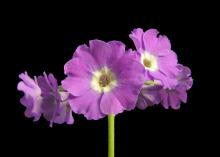 , Primula veris
, Primula veris 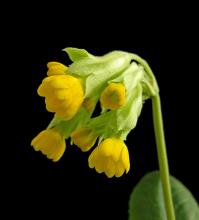 and Primula 'Freedom'
and Primula 'Freedom' 
Re: Image of the day
Todd,
Just bear in mind that we're late summer here, so it isn't exactly difficult to find things in flower. ;D
Re: Image of the day
Great images Todd! And dazzling us with innovative usage of inline image posting. If it is any consolation, we still have a 2-1/2' (75 cm) ice-hard layer of snow on the ground, frustrating when it reached nearly 60 F today.
Paul, I'm fascinated with Calostemma, first encountering this unusual genus on the pages of the Pacific Bulb Society. So I googled Calostemma to come up with a couple links for this message, and see that you are all over the web with Calostemma images :D Here's the PBS Calostemma page (you're on that one too!):
http://www.pacificbulbsociety.org/pbswiki/index.php/Calostemma
They vaguely remind me of Tulbaghia, with the united corona, and sort of Allium-esque too... I think I'm in love ;D I suspect however they would not be hardy here.
Re: Image of the day
Mark,
The bulbs sink to 30 to 45cm below ground, so that may offer some help in your area? Where they come from naturally is certainly not zone 5, that is for sure. Yes, I've posted pics of them all over the place...... always good to "advertise" an Aussie native bulb that people are unfamiliar with. ;D
Re: Image of the day
Here's a cold compress for the fevered brows of all those imagine that spring is nigh...
Winter... might as well embrace it!! ('Cause we know it's gonna be around for a whole lot longer! ;D ;D ;D)
Re: Image of the day
Beautiful images Lori ... an antidote to our continuous cool rain! :D
Re: Image of the day
All your nice flowering plants whether it be from studios or deep south make me sick of longing for spring :-[
Here we have neither snow nor rain but dry cold weather (well cold....not compared to the North of Norway which has -40 to -50C/-40 to -58F these days; Here it is -2C/28F).
The soil has frozen solid once more and the lakes are ice-covered.
The world is grey :(
Please continue showing colors!
Re: Image of the day
Todd,
You have perfectly illustrated why so many Brits grow plants under glass (but without heat of any kind).
Our continually wet, dark and cool winters don't provide snow cover, the rain begins in October and continues until March and the sun rarely shines during the same period. Our pots outside either crack with frost or flood, they get blown around by winds or enveloped in moss, mud and weeds and, more importantly perhaps, the rain can prevent inspection and distills that exuberant joy of gardening.
Under a pane of glass or in an unheated greenhouse we can shelter our plants (and ourselves) from the deluge and, hopefully, flower our plants up to two weeks earlier, so that we can compete (we should be so lucky) at the shows with our more privileged (higher temperatures, less rain, more sun) fellow gardeners in the south (of England, not Australia)!!! ;D
Lovely studio shots, Todd.
Re: Image of the day
Intense blue skies Lori! I know YOU will have winter for almost as long as I will.
Mark, send that 60 F my way...suppose to get 6" more snow on Sunday and mid-week is suppose to bring us the heaviest snowfall of the season :-[
I will be escaping that while in Calgary and Victoria! :D
Re: Image of the day
Todd,
He can send the 60'F day here as well..... it would be lovely. At present that seems to be about what most of our nights get down to. ;D It would be lovely to have such a comparatively cool day. ;)
Re: Image of the day
Wonderful pictures, Lori. Yes, it's a long wait til spring even though we are having a couple days of thaw at present. Still a lot of snow and as Mark says, with a rock hard surface. Finally managed to chop through the ice on path leading to door. It's taken a long time to do it. There always seemed to be yet another layer underneath. This is definitely catalog time. Lots of improbably gorgeous plant pictures to peruse.
Re: Image of the day
Even though brown is my favorite color, I don't think I could deal with the brown winters of the south (U.S.). Out of the northern part of the U.S., I live in one of the winter-sunniest, non-mountainous areas. In fact when I was a kid, I would sometimes use a pair of homemade snow goggles. (Honestly though, I may have used them more just because I thought they were "cool" looking. ;D)
Anyway, my point being that the periodic snows, drifting, melting, fogs, etc. that occur in winter here provide a constantly changing landscape. My first experience of a thunder snowstorm (not just thundersnow), about ten years ago, was quite invigorating! Some people disagree (usually the people who moved here from places not Minnesota), but winter is certainly not drab to me!
Although Todd gets WAY more snow than me, his normal spring growth is usually still earlier, as I have to wait for the deeply frozen ground to thaw. things like snowdrops popping through the snowmelt just doesn't happen here because plants don't wake up until long after the snow has receded.
That said, we had a very early heavy snow this winter, and the freeze depth of the soil is minimal. I am expecting another unusual spring this year. Last year, spring arrived three and a half weeks early!
Re: Image of the day
Rick,
Interesting to hear about your winters compared to the others over there! Of course it is way different winter climates here in Norway too but I don't think any similar to yours ;D
What's the difference between "thunder snowstorm" and "thundersnow"?? We experience snowstorms accompanied by thunder and lightening here but rarely.
Lori,
By the way, even if I am no fan of cold weather, snow and frozen soil at home, I am looking forward to our next visit to our mountain cabin ;) There we appreciate snow - at least in the winter season ;D Your pictures show why!
Re: Image of the day
Regarding thunder snowstorms, I probably should have said thunder blizzards. It is rare that we have thunder snow, when snow fall is rather gentle and light, but even more rare when thunder occurs during a full blown blizzard. I can remember it happening only once in my 51 year life.
Post message:
I was listening on the local public radio station how thundersnow is "formed", and it seems the frequency should be backwards from my experience: being rare, but more frequent in violent storms than gentle ones.
Re: Image of the day
Dave,
If you had a closeup just of the berry bits, it would look a bit like some sort of alien invasion!! ;D
Re: Image of the day
From a hike last summer, here are some colourful lichens at treeline. My best guess is that the brilliant yellow ones may be Cetraria sp. (C. pinastri??) and that the weird white tubercles behind it may be Cladonia sp. (C. bacillaris??)
Edit: Weird white tubercles appear to be Thamnolia subuliformis - common to arctic/alpine areas in the northern hemisphere.
Re: Image of the day
They must have looked like beautifully flowered cushion drabas from a distance, Lori ... magnificent!
Re: Image of the day
Wow Lori...I've never seen yellow lichens! Look good enough for growing in our rockeries!
Re: Image of the day
Very special color of that lichen, Lori!
I have never seen any that yellow. The nearest are Flavocetraria nivalis and Letharia vulpina. The first is rather common but pale yellow, and the latter is rare and growing on logs. It has been used to poison wolves.
http://www.google.no/images?um=1&hl=no&client=firefox-a&rls=org.mozilla%...
http://www.google.no/images?um=1&hl=no&client=firefox-a&rls=org.mozilla:...
Re: Image of the day
Hi, Trond. Both of the lichens you show occur here too. Fascinating stuff... I would certainly garden these too if they were willing.
Re: Image of the day
Hi, Trond. Both of the lichens you show occur here too. Fascinating stuff... I would certainly garden these too if they were willing.
Lori, have you ever tried? I think it is feasible. Lichens reproduce by many means, also fragmentation. My daughters have "grown" lichens (Cladonia species) by taking pieces and placing where they want them. They live for years at least if they get sunlight and water.
Could be interesting to try the yellow one here if you ever stumble upon it again ;)
Re: Image of the day
I'll have to give that a try!
Another cute little Erigeron humilis (one of my favorites) tucked into a hollow in the rock, with a gorgeous purple-black involucre, and white petals this time, rather than mauve.
Re: Image of the day
Amazing how persistent and resilient some plants can be!
Re: Image of the day
Nice Erigeron, Lori, I was looking at a species on Alplains list with black outers..
Todd's theme of persistent and resilient applies to this plant--neither photo nor species are exceptional, but I think there are some nice layers of meaning to this image:
At a time of year when spring is still distant and longed for here, the dandelion is a good symbol--its often one of our first flowers, tucked up against the south side of some building!
Then, this particular plant is a good reminder of the difference siting can make to a plant's appearance: this one is growing in the hard packed native clayey soil with gravel (many many years ago) packed in almost like concrete on our driveway, in full sun, and thus remains tiny and compact, with reddish leaves--if I remember correctly, the leaftip to leaftip span would be something like 4 inches/10cm.
I received a couple bits of root last fall of some exotic dandelions--a french kitchen garden cultivar, and T 'faroense' which, if it survives the winter and I can grow it, might look a little similar to this one--small, with red leaves....
Re: Image of the day
I am always happy when I find wild fleabane in the mountains here and some of the alpine dandelions are quite nice too!
What do you intend to do, Cohan, use the dandelion as a salad herb ;D
Re: Image of the day
Well, speaking of dandelions, Cohan...
I've spent a really ridiculous amount of time trying to convince myself that this is our native alpine dandelion, Taraxacum ceratophorum... I think it is. Is it??
This picture (and the rest of my peculiar little collection of alpine dandelions :rolleyes:) was taken at about 2500-2600m elevation, well above treeline, in an area where I cannot recall seeing any weeds whatsoever once past the roadside (which is pretty much the norm along the mountain trails except in areas frequented by horse parties... which we would avoid anyway). Teensy, tiny little plants...
Well, it's hardly spectacular and given that it seems this species has been demoted to a subspecies of the regular weedy ol' dandelion, maybe it doesn't matter anyway! ;D ;D (Although having said that, I did collect a few seeds and am growing them... :rolleyes:))
Re: Image of the day
Well, speaking of dandelions, Cohan...
I've spent a really ridiculous amount of time trying to convince myself that this is our native alpine dandelion, Taraxacum ceratophorum... I think it is. Is it??
This picture (and the rest of my peculiar little collection of alpine dandelions :rolleyes:) was taken at about 2500-2600m elevation, well above treeline, in an area where I cannot recall seeing any weeds whatsoever once past the roadside (which is pretty much the norm along the mountain trails except in areas frequented by horse parties... which we would avoid anyway). Teensy, tiny little plants...
[attachthumb=1] [attachthumb=2]Well, it's hardly spectacular and given that it seems this species has been demoted to a subspecies of the regular weedy ol' dandelion, maybe it doesn't matter anyway! ;D ;D (Although having said that, I did collect a few seeds and am growing them... :rolleyes:))
a
Very cool! Somewhere recently I read authors' conclusions that there were likely a number of species of Taraxacum in Alberta, but the work hadn't been completed to make it clear what they should be... but where did I read that? A quick glance at the 4 books I have to hand did not yield the source...
I'm most interested in some of the arctic species with white or creamy flowers (completely unsuccessful in finding any sources, I tried some of the academic sources involved in research with some of the species, but no joy), but I have also grown interested in any of the small species; I see T ceratophorum can be up to 25cm-- based on conditions, no doubt? How long have you been growing it, any sense of how small it will be?
Re: Image of the day
In Scandinavia they have described thousend of dandelion species - the reason for calling them species is that they are apomictic and you what you have is a swarm of clones! The characters differentiating the species/clones are often subtle.
A few, often in mountainous regions are quite different and easier to recognize.
Re: Image of the day
In Scandinavia they have described thousend of dandelion species - the reason for calling them species is that they are apomictic and you what you have is a swarm of clones! The characters differentiating the species/clones are often subtle.
A few, often in mountainous regions are quite different and easier to recognize.
This is also the case with some other Asteraceae, such as Antennaria, and apparently many unrelated Arctic plants, as well.. makes that usage of species a bit silly--surely no one is actually going to name all those species??
Re: Image of the day
A bright sunny picture to warm your hearts and tickle your fancy ...
Armeria alpina on the Sella Pass in the Dolomites.
Re: Image of the day
Gorgeous Cliff...a way to warm the heart when youn are looking out the window at -20 C!
Re: Image of the day
Beautiful, Cliff.
Re: Image of the day
Cohan, I only started the (supposed) Taraxacum ceratophorum this winter so I don't know how big they'll get... it's the old nature vs. nurture question.
This was a very pretty thing, though unfortunately none of them wintered over for me... Petrocoptis pyrenaica ssp. glaucifolia, a Caryophyllaceae from the Pyrenees:
Re: Image of the day
Cohan, at least one dedicated botanist has tried to name all the dandelions in Scandinavia. Tongues tell that he forgot what he had already done so every time he picked a dandelion he gave it a new name.... or maybe that it was the guy working with Hieracium that lost control ;)
Cliff, a nice thrift and a yellow Asteraceae too!
Re: Image of the day
Lori--if the dandelion grows too big, try in a spot like my packed clay and gravel driveway ;D
I'll be looking forward to updates!
Trond--dedicated scientist or crazy man ;) Actually, I might be able to see a reason to count and number the clones, but not to give them species names!
Re: Image of the day
Anne was talking about antlered rats in the the Groundhugging Shrubs, thread; We had a visit this morning form one-- too young to be antlered, but not too young to prune virtually every shrub and small tree on the property (the planted ones, that is, and no doubt some of the natives too)-
a young moose;
I didn't see it, I was still sleeping, but my friend got a few pics, and my mom saw it from her window--yelling at it to move before it could eat off some small Spiraeas and a small flowering plum;
Nanking cherries are much shorter now! and some of the apples I harshly pruned last year have had most of the new growth removed (these are only a few metres from my mom's house, and not much farther from ours!); as always, it headed for a planted Cornus sericea -the natives, which are smaller and all over in the bush here, are also almost universally pruned- and the Sorbus--which should be a good sized tree by now, but remains a multi stem large shrub/small tree--finally having got a bit of height in the middle where its not as easy to munch.. it also made a stop to seriously clip an arctic willow, and passed through my rock garden to be to take a few bites off a small willow I have there..
Luckily, they don't seem to be interested in the Tilia cordata, which I love for its shape;
Re: Image of the day
HI, I thought I'd add a couple pics of one of my favorite plants. The second photo shows a Hosta 'Great Expectations and a Polystichum braunii. I purchased the orchid and the fern 2 years ago from Don Avery at Cady's Fall Nursery in Morrisville, VT. A spectacular nursery full of well grown treasures and amazing display gardens. It's out in the boondocks but well worth the trip.
Re: Image of the day
Lori, did you mean that Peterocoptis is a perennial? Even if it is an annual or biennial I like it and think it could do well at my summerhouse!
Amy, I like Cypripedium very much! I have planted two different species here (very small plants a couple of years ago) but last year when they produced the first flowers slugs damaged the flower stems >:(
Unfortunately garden orchid is hard to find for sale in Norway and although a lot of nurseries in Europe have plants it is very difficult and expensive to import (due to Norway not being a member of EU).
Re: Image of the day
Nice moose, Cohan. I think they are very noble looking animals, and I like their long elegant legs... though that one still has the cuteness too of a relative youngster.
Beautiful orchids, Amy! Welcome! It's great to see you posting here.
Re. your comments about the nursery having terrific display gardens... what an effective strategy for plant sales, as well as to show, simply, an appreciation for the plants... not that I ever need that much encouragement to buy plants, but a good display garden is always a bonus! ;D )
Trond, I found one site that claims Petrocoptis pyrenaica ssp. glaucifolia is a perennial; it's hard to find much other than a few pictures, though. Native to Spain's Picos de Europa, it seems. I found a site that claimed it occurs in the Pyrenees also.
I was browsing my photos and found a shot of an absolutely amazing thing growing in Stephanie Ferguson's incredible garden... well, actually, anyone who has visited knows you can't turn around there without seeing a hundred absolutely amazing things! Stephanie is presenting at the Winter Study Weekend, along with Todd, and Vojtech Holubec and others.... dang, I've been kicking myself for not arranging to go!
Here, from Stephanie's rundlestone rock garden, is the gorgeous foliage of Bukiniczia cabulica, with the prickly appeal of Caragana jubata, above it:
Re: Image of the day
Re. your comments about the nursery having terrific display gardens... what an effective strategy for plant sales, as well as to show, simply, an appreciation for the plants... not that I ever need that much encouragement to buy plants, but a good display garden is always a bonus! )
Lori....It seems most nurseries here (in Vermont anyway) have extensive display gardens. I work in a small specialty nursery and we've got huge gardens for customers enjoyment and inspiration.
Re: Image of the day
Lori....It seems most nurseries here (in Vermont anyway) have extensive display gardens. I work in a small specialty nursery and we've got huge gardens for customers enjoyment and inspiration.
It's great to hear that most nurseries there would have display gardens, Amy. It's not at all the case here... possibly due to the fact that we are situated in "Hail Alley'. A significant number of damaging hail storms in any year seems to have driven the bigger places to have everything indoors in greenhouses or buildings, believe it or not. Rundle Wood, a small specialty nursery, is an exception, with an incredibly beautiful private garden, that also functions as the "display garden" for the sale of exquisite plants.
What is the specialty of your nursery?
Re: Image of the day
Lori, I think moose are pretty cool, too.. its amazing that something so big can be around (not in small numbers either, I think) and not much seen!
Those legs are long, too-- I was looking at tracks through the yard, this morning (probably this youngster in the picture had a companion, helping it to prune every bush in the place ;D) and it seems one of them came from the bush, where I have a piece of wire mesh fencing kind of propped up against the trees beside my veggie patch, its about 3- 4 feet tall, and the critter calmly stepped over it, walked toward the back of my mom's house and calmly stepped over another similar fence (built as a dog run, for a small dog) and went out between the houses, passing no more than a few feet from my mom's house--bold!
Is Stephanie Ferguson the gardener with the rosulate violets that were shown on Alpine-L?
What does this Caragana do--is it pendant? or..?
In my immediate area, most nurseries seem to grow on and sell plants started and bought in bulk from somewhere else--mostly B.C., it seems; not much for display gardens that I have seen....
Re: Image of the day
I never have time to post pix of my rock garden in May, so I think I will do so now in the end of February in anticipation of what I hope will be another good year (aren't all years good in rock gardening?). The pictures were all taken at the end of last May of my Quince rock gardens...
Re: Image of the day
Fantastic Panayoti, and I even spot a circular plant of Allium senescens glaucum in two of your shots. The pink delospermas in your photos inspire confidence that mine will overwinter. About a week ago, enough snow from the 3' snow pack receded where my troughs are located, and the delospermas caught some sun and looked okay. Since then all is encased in a new thick layer of slush and freezing rain that turned to concrete, now followed by another 8" of snow.
Re: Image of the day
Lori..the nursery where I work Rocky Dale Gardens specializes in dwark conifers and unusual perennials. The gardens are 20+ years old so the conifers are outgrowing their space and the owner is re-working the whole garden.
Panayoti...beautiful shots and so needed now. Like Mark said here we've still got feet of snow covering all and tomorrow more sleet & freezing rain! In the third photo there is one bright spot of red...is that a poppy of some sort?
Re: Image of the day
We could have a contest with PK's beautiful pics. Who can name the plants?
I think I see Hieracium villosum (or H. lanatum) (?)
Re: Image of the day
Beautiful gardens, Panayoti! I couldn't even imagine what's all in those photos, but I think I see Verbascum dumulosum?
Nice, Amy. I hope you get an employee's discount, but I imagine in any case that your own gardens are full of choice stuff from Rocky Dale!
Re: Image of the day
Panayoti, a wonderful rock garden! What kind of rock do you use? Is it a kind of granite? I can't even dream of creating anything like it!
Re: Image of the day
I never have time to post pix of my rock garden in May, so I think I will do so now in the end of February in anticipation of what I hope will be another good year (aren't all years good in rock gardening?). The pictures were all taken at the end of last May of my Quince rock gardens...
Wonderful plantings--I can only imagine the gems that must be in there ;D All the better to see them at this time of year when there is nothing much to see outside but snow! Snow again yesterday, today and tomorrow, though shouldn't be too much...
Re: Image of the day
Thanks for posting the pictures, Panayoti. What a beautiful garden! Much appreciated here in the northeast, where everything turned white before Christmas and remains that way.
Re: Image of the day
Is Stephanie Ferguson the gardener with the rosulate violets that were shown on Alpine-L?
What does this Caragana do--is it pendant? or..?
Yes, she's growing some rosulate violet species, and they look incredible - just as they do in the photos from the Andes that we see now and then! Plus, she grows pretty well every other plant that is considered incredibly desirable and impossible... Jankaea, Paraquilegia, numerous species of Castilleja, Astragalus coccineus, you name it!! :o :) And grows them all extremely well!!
Here's a better picture of Caragana jubata, taken just as it leafed out in early spring in Stephanie's garden, before the gorgeous, disproportionately-large flowers emerged... the habit is somewhat lax. (I really like this one, and was incredibly fortunate to have got a seedling as a gift last year!)
Here also is Callianthemum anemonoides... one of many spectacular specimens of it in her garden!
Re: Image of the day
She has a great looking garden, Lori! I love the stone itself, for starters ;D
I think a similar stone (not sure it ranges into the warmer colours, though, mostly dark grey) is available from somewhere near Nordegg, and quite commonly used around here in commercial landscaping, I haven't priced it at all though...
From what you say, presumably Stephanie is a very skilled gardener, but aside from that, do you think there is anything about her site that allows some of the presumably less hardy things to flourish? Or do you think its more a case of her choosing the right spots and right soils?
Re: Image of the day
..... and where in the World (Canada) does she garden?
Re: Image of the day
Here in Calgary, Trond.
Re: Image of the day
Another reason to visit Canada then!
Today was the first day this year I felt the spring in the air! Till now weather has been cold and dreary and the spring flowering plants have barely put up their heads.
The first snowdrops opened wide today and the first crocuses, snowflakes and hellebores follow soon.
Let us hope fore more mild days and nights!
Re: Image of the day
Another reason to visit Canada then!
Today was the first day this year I felt the spring in the air! Till now weather has been cold and dreary and the spring flowering plants have barely put up their heads.
The first snowdrops opened wide today and the first crocuses, snowflakes and hellebores follow soon.
Let us hope fore more mild days and nights!
Congrats on the belated spring! I can't resist whenever you mention snowflakes-- I have to say I have lots of those!
We shovelled the last two days, and again today at least some (only a couple to a few inches each time, but we don't want to let it pile up and pack down...)
Re: Image of the day
Congrats on the belated spring! I can't resist whenever you mention snowflakes-- I have to say I have lots of those!
We shovelled the last two days, and again today at least some (only a couple to a few inches each time, but we don't want to let it pile up and pack down...)
Thanks, Cohan! Can you pick your (spring) snowflakes and decorate the sittingtable (without placing it in the fridge)?
Re: Image of the day
Lol--Nope! But I can, and do, pick the snowflakes and use it to water my houseplants (after it melts and reaches room temperature!) ;D
Re: Image of the day
Lucky you Trond!! I'm still shoveling snow as it slides off the roof scaring me & cats to death!! Although I must say there is a definite something in the air that makes it feel as though spring just might be sneaking up on us here.
And Cohan, is there any benifit to using melted snow for watering your houseplants? It would be good to have a use for it all besides working up sweats while shoveling! ;)
Re: Image of the day
Lucky you Trond!! I'm still shoveling snow as it slides off the roof scaring me & cats to death!! Although I must say there is a definite something in the air that makes it feel as though spring just might be sneaking up on us here.
And Cohan, is there any benifit to using melted snow for watering your houseplants? It would be good to have a use for it all besides working up sweats while shoveling! ;)
Amy-- most tapwater is not good for plants, towns and most well water generally have very hard water which is said to not be appreciated by most plants: there has been a controversial movement in cactus and succulent circles to acidify tap water (through adding vinegar or more sophisticated additives) with reportedly excellent results..
My well water is more complicated--presumably having some of those hard water minerals, but also having sulphur, which if I remember correctly, is too acid, in any case, plants do not do well watered for any length of time with this water, and it would be costly using brita filters for all my indoor watering ;D so it's rainwater in the few months we have rain, and melted snow the rest, and the times between (spring and fall can be tricky depending on weather) I have to resort to the brita!
Re: Image of the day
I am glad I don't need to bother about the water! Here, as almost in all Norway, open lakewater is used as communal water reservoirs. This kind of water do contain very small amounts of Ca and Mg if any as the bedrock usually is acidic. As a result the water is very soft.
I used a well before I got communal water and the problem was not the hardness but the amount of iron. We couldn't wash cloths as it always got a brownish hue and rusty spots. But I think the plants liked it!
Re: Image of the day
Amy-- most tapwater is not good for plants, towns and most well water generally have very hard water which is said to not be appreciated by most plants: there has been a controversial movement in cactus and succulent circles to acidify tap water (through adding vinegar or more sophisticated additives) with reportedly excellent results..
My well water is more complicated--presumably having some of those hard water minerals, but also having sulphur, which if I remember correctly, is too acid, in any case, plants do not do well watered for any length of time with this water, and it would be costly using brita filters for all my indoor watering ;D so it's rainwater in the few months we have rain, and melted snow the rest, and the times between (spring and fall can be tricky depending on weather) I have to resort to the brita!
Cohan,
Have you thought about setting up some sort of sand or reed filtration bed to naturally filter your water? Might be cheaper in the long run than the brita, and if you choose the right sort of bog plants for the reed bed you could add something beautiful to the garden as well? The water it filters could then be used to spring and autumn watering of the rest of your garden?
Just a thought anyway. :-\
Re: Image of the day
It's pretty hard to beat rainwater... it's soft, neutral and free! We collect it off the roof of the house and garage in a system of troughs, 500 gallons in total, to use for the greenhouse watering and the waterlily/tropical fish ponds in there, and for general watering outdoors. Fortunately, though, we have no need to melt snow! ;D
Cohan, have you ever looked into "shocking" your well, that is, periodic cleaning with a bleach solution to kill the sulfur-reducing bacteria which tend to grow on the sandpoint or the screen? (I have never lived in a place that has its own well, but having worked on quite a few water wells (for industrial usage of nonpotable water), annual bleaching of wells is good/standard practice in the hydrogeology world). Anyway, just a thought that could be looked into, if it's of interest.
Re: Image of the day
One for today... near-vertical bedding on Mt. Lipsett in Kananaskis. The plants are in their subdued fall tones in this photo.
Re: Image of the day
Paul, good idea! Though the brita is mostly for drinking/cooking water--our water is not unsafe, and my mom uses it as is, but since we are not used to it (I used it when I was growing up from 9-18), we use the brita.. I don't often use it for plants, only if snow has run out and there has not been any rain, which can happen in spring, since we usually do not gain rain until later in May, but I try to stockpile snow towards the end--its not as though I need hundreds of gallons for houseplants :) Outside it is fine to use the tapwater for watering, as it gets leached out by rain--anyway, I avoid watering as much as possible outdoors--I would certainly hope not to often water any permanent in-ground plantings! Veggies and pots are another matter, and I do use rainwater for pots outside as much as possible, but that's just summer--spring and fall are freezing times, not watering times ;D
Lori, that's interesting, (sounds expensive/technical=expensive) haven't heard of that, but this well has had sulphur from the time it was drilled in the mid-70's, so I don't think its an issue of build-up..
Trond--apparently (so I have read in discussions of acidifying water, I have no personal knowledge in this field) in North America at least, municipalities make the water harder, whatever the original source of the water, for the sake of not corroding pipes etc....
Re: Image of the day
Well then...here I go out to collect snow to water seedlings & houseplants! thanks for the good advice... :D
Re: Image of the day
Just a correction of a slip of the mind:
Municipalities make the water higher in pH, to reduce corrosion in pipes. They don't make the water harder. In fact many around me employ a system that removes iron (and magnesium, I think).
Re: Image of the day
Lori, that's interesting, (sounds expensive/technical=expensive) haven't heard of that, but this well has had sulphur from the time it was drilled in the mid-70's, so I don't think its an issue of build-up..
No, not expensive or technical... it's standard practice, as I mentioned, for water wells, potable or otherwise. Here is some info for home wells:
http://www1.agric.gov.ab.ca/$department/deptdocs.nsf/all/wwg411
If it hasn't been done in 40 years, well, it just might be timely... ;D (And the reason I mention it is because an accumulation of sulphur-reducing bacteria in the well is the usual cause for H2S-smelling water... and the bacteria start accumulating immediately after the well has been drilled.)
(NB. Hardness comes from calcium and magnesium.)
Re: Image of the day
Lori, that's interesting, (sounds expensive/technical=expensive) haven't heard of that, but this well has had sulphur from the time it was drilled in the mid-70's, so I don't think its an issue of build-up..
No, not expensive or technical... it's standard practice, as I mentioned, for water wells, potable or otherwise. Here is some info for home wells:
http://www1.agric.gov.ab.ca/$department/deptdocs.nsf/all/wwg411If it hasn't been done in 40 years, well, it just might be timely... ;D
(NB. Hardness comes from calcium and magnesium.)
tks, Lori, I'll take a look.. of course, I wasn't here for 25 of those 38 years, so anything might have been done in that time! Just never heard of it ;D And the sulphur was in this well from day 1, as opposed to 1/2 mile down the road at the main farm --where I grew up prior to moving here, and my grandparents and their children lived since the '40s, where there was never any sulphur in the water; When we first moved here, we used to carry drinking water over from there, along with milk, and had veg gardens there for a long time (still not much good here for veg gardens--a few hard won small beds compared to field sized spaces we had there...lol)
Re: Image of the day
A plant for today... Lewisia longipetala, in bud and in bloom:
Really nice plant in a great genus, and lots of less grown cool genera/species in this family, too...
Re: Image of the day
Lori, your Lewisia longipetala blooms after the foliage recedes? I'm pretty stupid when it comes to Lewisia. I didn't know that any lewisia did that.
Very cute!
Re: Image of the day
Well, being pretty stupid about Lewisia myself, and really unobservant to boot, it was more like it was threatening to bloom itself to death that year (2009)... although it did come back again in 2010.
Here's what it looked like towards the end of bloom the previous year (June 20, 2008)... still with green leaves, so who knows?
Re: Image of the day
Lori, a desirable little Lewisia, with or without leaves!
Re: Image of the day
I'm getting down to the dregs of the photos of my miserable plantings... and spring is nowhere in sight yet here... so let's see some of your images, folks!
Aethionema lepidioides:
Re: Image of the day
That's hardly a dregful photo, Lori! Love it!
Salix chaenomeloides is beginning a nice show of catkins with 2 feet of snow still on the ground. A few hours in warm water and they are in perfect form. Featured at my friend's wedding today...
Re: Image of the day
Salix chaenomeloides is beginning a nice show of catkins with 2 feet of snow still on the ground. A few hours in warm water and they are in perfect form. Featured at my friend's wedding today...
Don't tease us Rick, show us photos (of the Salix that is, not necessarily the wedding ;D).
Re: Image of the day
Lori,
Definitely not a dreg!! Definitely not!!
Re: Image of the day
Lori, the English word dreg is actually a Norse word "dregg" and still in use today - a very useful and necessary item onboard (= anchor) ;)
Re: Image of the day
Well spring is only a fantasy here too, but I'll post a few saxifrage pictures I took at the WWSW in Victoria last weekend. I make no guarantees about the correctness of the names.
Re: Image of the day
Gee, it's nice to think that spring is a reality somewhere, Todd! ;D Great to see those photos. It is also an acute reminder that I don't have any of that sort of Saxifrage. Were those plants on display or for sale?
Lori, the English word dreg is actually a Norse word "dregg" and still in use today - a very useful and necessary item onboard (= anchor) ;)
Very interesting, Trond, and it's funny that it essentially fits with the English usage of the word... something drug up from the bottom! ;D I suspect, strictly speaking, that the English word probably relates to sediment at the bottom of a vessel of some sort (such as in a bottle of red wine, for example) but the applicability is eerily similar.
Re: Image of the day
Campanula Maie Blyth --originated in Maie's garden in the township of Timaru ,New Zealand.
I have a couple of plants --one in a trough and this one in a pot --both do well in a sunny spot planted in free draining mix.
Cheers Dave.
Re: Image of the day
Hello Dave!
Nice dwarf Campanula. How are things down there? Still earthquakes?
My daughter and her class are heading for New Zealand in two weeks for a month's stay. I believe they are to visit Christchurch too if that is feasible.
Re: Image of the day
Hello Hoy
Although at this end of the South Island things are fairly quiet ,i understand Christchurch is still receiving aftershocks and in the North Island ,Wellington ,(the capital city of NZ), there has been a quake in the last day or so which registered over 4.
Visiting Christchurch is feasible i guess --however the roads in some parts of the city are a mess, travel is slow and the central area remains cordoned off.
Dave.
Re: Image of the day
That is one attractive campanula!
Lori, the saxes were on display. There was not much offerings by vendors....I was hoping Roger barlow would be there but alas, he wasn't. I picked up a couple of Hepatica nobilis, Beesia deltophylla, Epimedium washenense, Ypsilandra tibetica, Salix repens 'Boyd's pendulous', Salix breviserata, Podophyllum veitchii X pleianthum and Adiantum venustum.
Re: Image of the day
Todd, even if you couldn't buy the saxes I think that you got some nice plants!
I am waiting for my saxes to flower but it is still some weeks to, anyway I have no saxes like those :-[
Re: Image of the day
Here is a link to quite an amazing phenomenon: http://www.ubcbotanicalgarden.org/potd/2011/02/grimmia_ovalis_tentative_...
Has anyone ever seen this anywhere?
Re: Image of the day
Wow! Nope, I have never seen this.. Summons all sorts of fantasy images--As if those plants are doing something dramatic when no one is looking, and they are just sitting still while humans are around ;D
Re: Image of the day
;D ;D
Re: Image of the day
Creeping moss! What next? But I know why it creeps - much easier to feed on the algae or whatever it is that grows there :o :o
Re: Image of the day
Here is a link to quite an amazing phenomenon: http://www.ubcbotanicalgarden.org/potd/2011/02/grimmia_ovalis_tentative_...
Has anyone ever seen this anywhere?
Fascinating! For people visiting the link, be sure and read through the posted comments below the article, some educated alternate explanations of what might be going on.
Re: Image of the day
I think I've seen that creeping moss in Newfoundland! ...those trying to find some shelter from all our wind! ;D
Meanwhile, my Cyclamen pseudibericum is blooming quite nicely in my basement window.
Re: Image of the day
Todd,
That is a breathtaking picture of the Cyclamen. You can just about reach out and touch it. :o
Re: Image of the day
Just back from a hortgeeking adventure to Pine Knot Farm, JC Raulston Arboretum & Plant Delight Nursery during the open house and what a fantastic breath of spring it was! I also came away with a cart full of treasures!
AmyO
Brunswick, GA (temporarily)
Re: Image of the day
Just back from a hortgeeking adventure to Pine Knot Farm, JC Raulston Arboretum & Plant Delight Nursery during the open house and what a fantastic breath of spring it was! I also came away with a cart full of treasures!
AmyO
Brunswick, GA (temporarily)
Oh my oh my! :o :o :o What a splendid photo display, starting with such a gorgeous silvery Cyclamen coum, and Edgeworthia, an elegant shrub I have always wanted to grow. The photo progression from silver to gold and back to silver is most pleasing and refreshing. Lucky you on a spring plant tour :D
We had two days where it reached 50 F just to tease us, and I saw my first snowdrops in one south-facing sunny spot where the snow receded, but tonight we plummet back into the deep freeze, and with 12-18" icepack still engulfing most the ground, spring is still a ways off here.
Todd: great Cyclamen shot, so dramatic.
Re: Image of the day
I got away from Vermont just in the nick of time! My husband sent a pic of the storm and he said we were getting 2 feet! All I can say is WHEW!! :o ;D
Re: Image of the day
Gorgeous campanula, Dave - those open-faced types made it here a couple of years ago, though not that variety... beautiful!
Terrific shot, Todd!
"Hortgeeking" - I'll have to remember that! ;D
Looks like you did verrrryy well there, Amy!
Re: Image of the day
Great photos, Amy!
And I thought I had a fairly nice form of Trillium sessile - until I saw that T. underwoodii! Wow!
Re: Image of the day
Amy, what Epimedium plants did you buy? If those are "eppies" from Plant Delights, I know they carry a very good selection, including some of their own hybrids.
Re: Image of the day
My wallet had been very slim had I visited those places! You have found some tidbits, Amy ;D
Re: Image of the day
Oh yes it was an expensive trip but a dream trip I've been planning for a very long time!
Mark, the Epimediums are....'Flamingo Dancer' & x youngianum 'Tamabotan'. They had a really extensive selection and it was so hard to choose!
Rick, The Trillium underwoodii are amazing! I had to really restrain myself from buying more, which would have meant less of the other goodies!
I'm planning a repeat trip next spring as I won't fly down here anymore...too stressful and aggravating!
AmyO
Vermont, zone 4-5
Re: Image of the day
Ahh, thoughts of summer...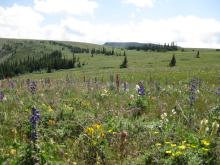
And little marvels in bloom (Townsendia parryi, I think)...
And exhilarating views that lead one on and on...
Re: Image of the day
"SIGH" :-*
Re: Image of the day
Ahh, thoughts of summer...
And little marvels in bloom (Townsendia parryi, I think)...
And exhilarating views that lead one on and on...
The real marvel is that the snow will melt one day! (I think..)
Re: Image of the day
Here is a contrast to Lori's nice little marvel!
We went for a holiday at our cabin, looking forward to some nice skiing:
Our cabin is located in the upper tree belt, 950m
We couldn't open the front door, the key broke and the door was stuck. Had to use the backdoor.
We soon discovered why: Sewage problems! Frozen sewer down the line. Not our stuff, we haven't been there for months!
Three days digging (not soil!) and washing.
We went home crossing the mountains. Not that much snow, have seen more at this time of the year. We met wind and snowdrift - not much to see of the road!
It is always kiters at the plateau of Hardangervidda
Down from the mountain we have to go through tunnels and down the steep valley of Måbødalen.
Re: Image of the day
That is a marvel, Trond! Just not a good one.....
Actually, its interesting to me that even at the 'cabin' you have community plumbing! Out here, its every property for itself, no public water or sewage until you go into a town...
Judging by the road, it looks quite warm in the mountains, when its cold here, there is no wetness on the road...
Re: Image of the day
Trond, the snow around your cabin is about the same amount that is around here at the moment. We managed two mild days earlier in the week (9C) but now its back cold, damp and raw (-5 C).
Re: Image of the day
I guess there is an advantage to not having indoor plumbing at our cabin in northern Minnesota...
Re: Image of the day
Don't forget folks, we do have a "Weather 2011" topic ;)
http://nargs.org/smf/index.php?topic=565.0
Re: Image of the day
That is a marvel, Trond! Just not a good one.....
Actually, its interesting to me that even at the 'cabin' you have community plumbing! Out here, its every property for itself, no public water or sewage until you go into a town...Judging by the road, it looks quite warm in the mountains, when its cold here, there is no wetness on the road...
Well Cohan, the plumbing is a necessity! 25 years ago everybody let the sewage run into the ground or had old-style outhouses. The water supplies were fouled etc.
Our cabin is modest; two years ago the mean "cabin" in Norway passed the mean house in living standard! A lot of people use a lot of money (but not so much time) on their "cabins".
The wet road is on the west coast - mild weather is coming up the valley from the sea. The eastern part is much colder, almost as cold as your place, down to -35C ;D
Mark, I apologize and am blushing :-\
Re: Image of the day
Trond, some sort of sewage treatment is required here--we have a sewage lagoon--quite far from the house, and downhill, but I doubt anyone installs those anymore, probably septic tanks are the norm (though I don't actually know that much about my neighbours' sewage!) but I'm quite sure development codes require treatment, its just an individual responsibility.. of course there is no way pipes for water or sewage could be run across country between properties, the distances would be unimaginable!
Hopefully we have seen our last -35C for this year, but you never know! Next week will be well above freezing...(daytime only)
Re: Image of the day
Trond, some sort of sewage treatment is required here--we have a sewage lagoon--quite far from the house, and downhill, but I doubt anyone installs those anymore, probably septic tanks are the norm (though I don't actually know that much about my neighbours' sewage!) but I'm quite sure development codes require treatment, its just an individual responsibility.. of course there is no way pipes for water or sewage could be run across country between properties, the distances would be unimaginable!
Yes, we had codes here too but people often ignored it. The distances is smaller here - at least were we have our cabin. It is on the grounds of earlier mountain farmland (where they had their livestock in the summer, milking and making cheese, butter etc - it is called "sætring" in Norw.). The cabins lie close to each other - often in "family groups". Septic tanks are commonly used. In fact, we have at home! Our house is too lowlying to be connected to the main pipe.
Re: Image of the day
A bit early in the season, this morning we got an inch of snow, but the weather brightens now!
This climber, Lonicera periclymenum, is a weed here and makes thickets impossible to penetrate! It flowers sparingly all summer and has a pleasent scent in night.
I have forgotten the name of this bulb, but think it is Scilla litardierei. May-June flowering.
This is a common plant in the hills here, Polygala serpyllifolia. It also grows on the road verges.
Re: Image of the day
That Lonicera is not a problem in Newfoundland...I even have one in my garden. The Scilla ID looks correct...I have that one too. And that Polygala...oohhhh I like it!
Re: Image of the day
Nice flowers, Trond-- I like the Polygala too! I found P senega around here last year, very nice, but not showy like this one..
Re: Image of the day
This is a common plant in the hills here, Polygala serpyllifolia. It also grows on the road verges.
Trond, what an adorable little Polygala, I like it. I was not aware of this European species, so thanks for the introduction. The foliage looks almost like it would be evergreen, is that the case? As always when I find new things on the forum, I go a'googling, and I share a few simple links. The flickr gallery image shows a sweet little plant.
Polygala serpyllifolia, Heath Milkwort
http://www.plant-identification.co.uk/skye/polygalaceae/polygala-serpyll...
flickr photo:
http://www.flickr.com/photos/31788134@N04/3821414124/
...and another:
http://www.pbase.com/mikelush/image/29381340
Re: Image of the day
This is a common plant in the hills here, Polygala serpyllifolia. It also grows on the road verges.
Trond, what an adorable little Polygala, I like it. I was not aware of this European species, so thanks for the introduction. The foliage looks almost like it would be evergreen, is that the case? As always when I find new things on the forum, I go a'googling, and I share a few simple links. The flickr gallery image shows a sweet little plant.
Polygala serpyllifolia, Heath Milkwort
Mark, it is actually a small evergreen shrub. It is very common here at the west coast and south coast but rarer eastwards.
I have never tried it in the garden or tried sowing it but it should make a nice rock garden plant.
Re: Image of the day
Well despite 2-3 feet of snow still on the ground and a forecasted 6" more tomorrow (urggghh....and this following 3 days of 5 C and rapid snow melt), the witch-hazels are blooming....in another month the first crocus could be open!
Re: Image of the day
Very nice, Todd! Which one is that, 'Jelena'?
Re: Image of the day
That is pretty, Todd ... and a lovely photograph.
Re: Image of the day
Well despite 2-3 feet of snow still on the ground and a forecasted 6" more tomorrow (urggghh....and this following 3 days of 5 C and rapid snow melt), the witch-hazels are blooming....in another month the first crocus could be open!
Really pretty! Not sure if any grow here, I sowed some last year, wild Ontario seed, no germination, but I kept the pots....
Re: Image of the day
Yes Trond it's Jelena
Just got another big dump of snow yesterday...20 cm. Snow is now drifted over my back fence again! This is the winter that never ends.
Re: Image of the day
Yes, the winter without end :rolleyes:... we understand!
The earliest recorded bloom for anything in my yard is March 20th* (Bulbocodium vernum), but this has been a rather cold winter, so we'll see...
But jumping ahead to the end of April, here's Androsace mairei:
http://www.efloras.org/florataxon.aspx?flora_id=2&taxon_id=200016931
*Correction: March 16th for emerging buds; March 19th for flowers last year!
Re: Image of the day
Very pretty Lori, I've not heard of that species before. The link to the FOC description says "umbels 5- or 6-flowered"; your plants seem more floriferous; perhaps more floriferous under better garden conditions.
Lori, do Galanthus bloom for you any earlier than March 20th, or does the Bulbocodium bloom before it?
Re: Image of the day
Bulbocodium vernum is always my earliest (I can't say what happens in other people's yards), but Galanthus can be a close second (first photographic record of bloom on March 25th) though they are usually later. The comparison is not really fair, as my only Galanthus are planted in an area that stays frozen until the sun gets somewhat higher in the sky, whereas the Bulbocodium are on a southwest-facing slope. I stuck some more Galanthus out in the front yard last fall, so I may have a better comparison this spring.
Re: Image of the day
I have tried Androsace mairei two times but it doesn't like it here. I'll try more!
Today we have had nice weather. However, it is not warm but 8-9C.
A few pictures from this afternoon
Spring snowflake (Leucojum vernum) is among the first to flower and need sun to fully open the flowers. Also snowdrops (Galanthus sp) and some croci (Crocus tomasinianus) are early.
Hellebores are always early. Usually this one (Helleborus niger) flowers at Xmas time. The peonies have just started!
Re: Image of the day
Very nice Trond, looks like spring is definitely on its way for you!
Re: Image of the day
Looking great, Trond! Hellebores are something I really want to try here..
No spring yet, though we have had a few days of +5 to 7C.. today only +1(still nice after -20 last week) and possible snow 5 days of the next 7..
I was very excited to see a small patch of bare ground in front of the house ;D
Re: Image of the day
I took some photos a few days ago-- not much to see on the ground yet--still almost entirely snow covered, but I managed to find some texture and colour on tree tree trunks and the occasional fallen log above snow level...
Full album on Picasa,
https://picasaweb.google.com/cactuscactus/March132011ForestTextures#
and I'll put a few more on my Alberta thread..
Re: Image of the day
A lot of ground to be seen now and even some bloom, Eranthis hyemalis and an unknown crocus - planted years ago and has spread beautifully. Nice to know that spring will come.
Re: Image of the day
Cohan, you are hungry for the spring? The orange lichen, is it Xanthoria parietina? We call it "messinglav" ="brass lichen" ;D
Anne, I like all those winter aconites! Here they disappear as soon as I plant some.
Re: Image of the day
Anne, great to see those early flowers :) Your antlered rats don't gobble up the first green things to show?
I sowed a few pots of Eranthis last year, so I am hoping for some sprouts...
Trond-my spring hunger is still kind of abstract, since we are not at the point yet where I am 100% convinced that it will ever come! The bare patch of ground I mentioned above is gone again, buried under several cm of snow overnight....
I don't know the name of the lichens and mosses, unfortunately;
I recently got one book ('Plants of the Western forest') that deals with them a little more, but it will take some serious field time to make any progress, and I'm sure the treatment in this book is still far from complete...
I took a quick look, and they show a couple of Xanthorias, though neither photo looked quite right, it'll take more study.. Luckily, some of the lichens seem to be specific to various substrates, so that may help...
Re: Image of the day
The antlered rats seem to be taking a small break after devouring gentians and daphnes.
Re: Image of the day
:(
Have you tried the predator urine ? I've seen it sold, haven't used it...yet...
Re: Image of the day
Even if we had a little setback and snow last night Chrysosplenium macrophyllum blooms now. Nice weather this evening.
Re: Image of the day
That's a cool plant Trond! Nice that it flowers so early too.
Re: Image of the day
Nice one, Trond, It doesn't waste any time, does it?
Re: Image of the day
Not familiar with that species....but early blooms are always appreciated. Still 3 feet of snow in my back yard :( The snow just doesn't want to melt this year.
Re: Image of the day
A true 'Image (or four) of the Day'. Four shots captured at the East Lancashire Alpine Garden Society Show held today (19th March) at Whitworth, near Rochdale, Lancashire. U.K.
1) The hall just prior to judging and before the crowds of visitors were admitted.
2) A general view of one of the four main show benches.
3) A stunning Pulsatilla grandis 'Budapest' that just missed out on the award for Best in Show but gained a well-deserved Certificate of Merit for Geoff Rollinson.
4) The worthy winner of the Farrer Medal (for Best in Show); Derek Pickard with his aged Dionysia bryoides.
Re: Image of the day
Everything is in peak form. Er.....that was a silly statement: of course they are!
About how many people would you say view these public displays?
And Cliff, how old would you guess that Dionysia is?
Re: Image of the day
Looks like a fun day, Cliff!
Re: Image of the day
Everything is in peak form. Er.....that was a silly statement: of course they are!
About how many people would you say view these public displays?
And Cliff, how old would you guess that Dionysia is?
Hi Rick,
I believe the dionysia was about eighteen years old - visitor numbers are difficult to quantify as all AGS members get free admission, but I think we had nearly 150 paying customers from the general public. Other shows attract more and many attract a lot less ... much depends on location, the weather and costly publicity. We attracted 62 top exhibitors on a day when there were also major national shows in Kent and in Scotland.
Re: Image of the day
We have no shows like that at all here in Norway. Had been very interesting to attend such a happening once!
That's a cool plant Trond! Nice that it flowers so early too.
Nice one, Trond, It doesn't waste any time, does it?
Thanks, folks.
It is an interesting plant both due to it's early flowering but also due to the leaves that stay green all winter and never are harmed by bad weather.
Re: Image of the day
A feature of our shows in the U.K. are the miniature garden classes that attract so much interest on our show benches.
The gardens are posted here, but as larger images (when clicked), so that interested members can better appreciate the craft and artistry employed to create them. John Dower from Frodsham is one of the nation's leading exponents of this delightful form of gardening and has proved an inspiration for many of these mini-gardeners and John's prize winning garden at the East Lancashire Show held yesterday will, without doubt, inspire others now via the world wide web.
John Dower and Peter Hood discussing the finer points of mini-gardening.
Four gardens in the Open Section (John's First Prize winning garden is labelled Garden three)
One garden in the intermediate Section
Re: Image of the day
Another class (this time exclusive to East Lancashire) that always excites interest and captures the imagination of the public and exhibitors alike is:- 'One pan containing three rock plants for colour effect (in flower or foliage mixed)'.
Some wonderful entries yesterday and here are some of the finest examples:-
Special class and entries for same.
The First Prize winner was exhibited by Diane Clement from Wolverhampton and is the final image of the sequence.
Re: Image of the day
The quality of plants from these shows is always stunning, to say the least! Do the miniature gardens tend to be assembled for the show, or are they long-term plantings? (I have the impression of the former... ?)
I love the Chrysosplenium too, Trond!
Re: Image of the day
Those mini gardens are incredible!
I am not a fan of alpine-house forced plants...way too perfect for my liking, but I do appreciate the work that goes into such culture. I would especially appreciate them about now as I am longing to see some colour!
Guess I'll see colour in a couple of weeks at the International meeting!
Re: Image of the day
I recently got one book ('Plants of the Western forest') that deals with them a little more, but it will take some serious field time to make any progress, and I'm sure the treatment in this book is still far from complete...
I think I have that one too - Plants of the Western Boreal Forest and Aspen Parkland (Johnson et al)? Nice book, if it's the one I'm thinking of, and it's really excellent for it to include a section on mosses and lichens. Wish I'd had such a reference decades ago!
There's another one that I think you would enjoy - Mosses, Lichens and Ferns of Northwest North America (Vitt, Marsh, Bovey), also published by Lone Pine. It's nice that these Lone Pine books have wide distribution around here... they show up in stands in lots of stores (not just in book stores).
Re: Image of the day
Yep, that's the book, does have some good stuff in it--though I hate seeing some of the near misses: nice plants that just don't quite make it over here as part of their natural range...lol
The lichens still seem a bit daunting -- I just feel like I might get the right genus, but really there could be another 6 species that look more or less the same! Mind you, that's how I feel about Carex, Salix..........
I'll be trying to work on mosses this year too.....
Interesting to see the differences in opinion about some names--they choose to stick to Habenaria, for example, where some others go with Platanthera.. hard to know which way to go with taxa one is not intimately familiar with! I have opinions about some cactus genera lumping/splitting, but no idea about bog orchids!
Re: Image of the day
I picked up a Hepatica nobilis at the WWSW and it still has a few blooms. My attempt at spring (still a LONG ways off! Just got 40 cm of snow in the last 3 days!...I literally have the most snow for this season in my garden at the moment)
Re: Image of the day
Todd, I can't say I do envy you all the snow! Here the first liverworts are in bloom! I found them today ;D
Re: Image of the day
I don't think it is any exageration that I live in the snowiest region in the world for my latitude. Our springs are always questionable but this year is taking the prize in being the worst.
Re: Image of the day
I don't think it is any exageration that I live in the snowiest region in the world for my latitude. Our springs are always questionable but this year is taking the prize in being the worst.
Todd, you have our sympathy but look onthe bright side... soon you will be travelling to the UK to enjoy our Spring weather and a meeting with hundreds of other rock gardeners..... that has to be better than all your snow!
M
( She said... hoping that the UK Spring weather doesn't turn nasty and remind Todd too much of home!! ;D ;D)
Re: Image of the day
You have my sympathy as well, Todd, but tonight e got some sleet and now everything is wet and nasty. I had planned tidying up the garden after the winter but now . . . .
I would love to join you all, Maggi, but unfortunately I am engaged all that week :(
Re: Image of the day
Our normal should be 5 C...we cannot reach 0 C. Suppose to get yet another 6" of snow this weekend. We are only 9" away from a all-time record snow on the ground for this date....and to think the snowdrops were almost out here in mid-January!
In the greenhouse, Geranium 'Pink Spice' is opening. I tried it twice outdoor but it does not seem winter hardy here.
Re: Image of the day
I had to look up Geranium 'Pink Spice'... sure looked like it had some G. sessiliflorum in it, and according to the patent info, it is apparently a cross between Geranium traversii var. elegans 'Cockayne' and Geranium sessiliflorum 'Cavanilles':
http://www.freepatentsonline.com/PP12172.html
I assume the lack of hardiness comes from G. traversii, based on both Helen's and my experience:
http://nargs.org/smf/index.php?topic=463.msg6246#msg6246
Re: Image of the day
G. sessiliflorum is bone hardy here too....which is why I thought Pink Spice might be a go..I was unfamiliar with G. traversii which is obviously somewhat tender.

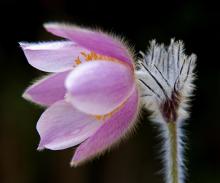

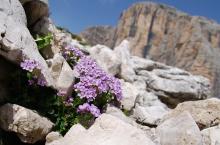


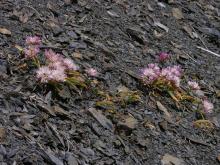

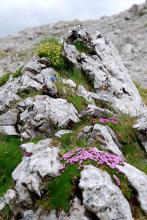


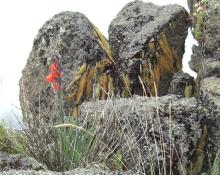


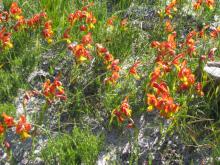
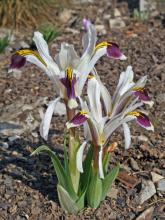


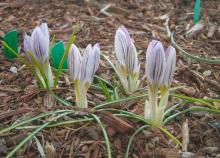
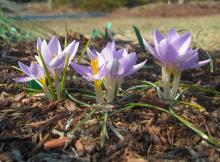
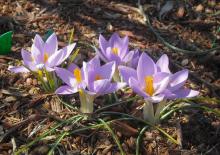


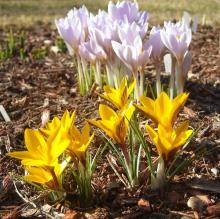


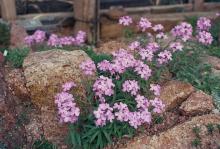
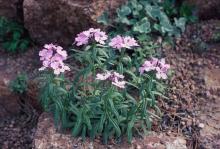





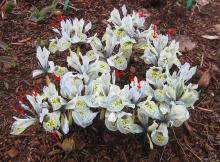


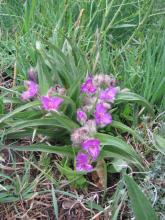
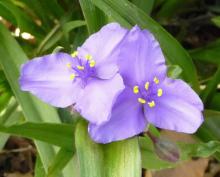




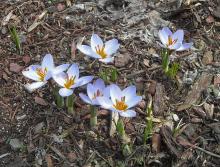
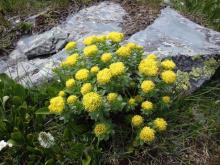
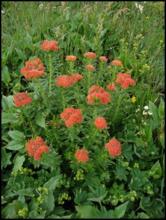
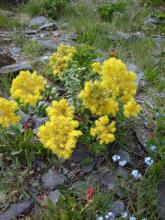



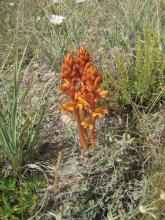
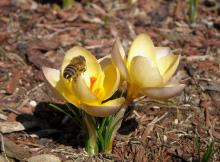
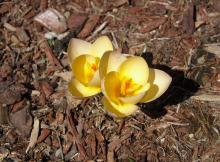
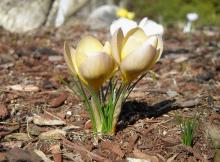
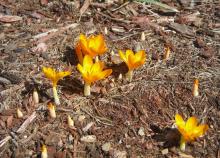
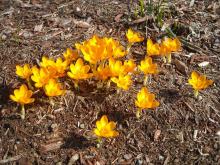



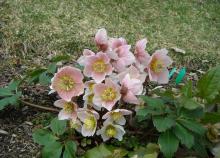
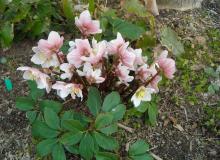

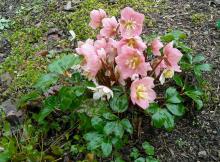

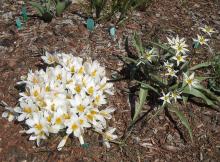

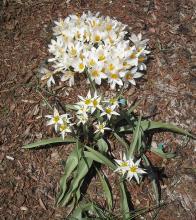
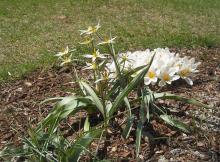
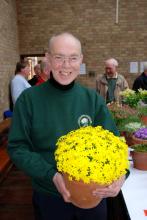
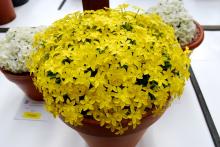
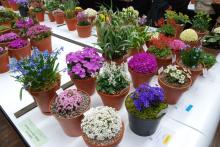
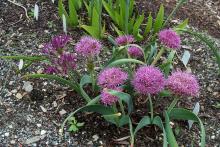




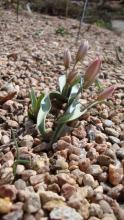





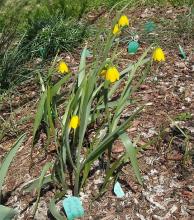



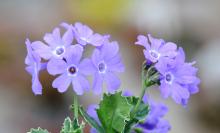

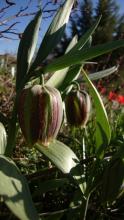




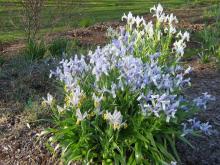

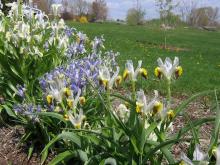

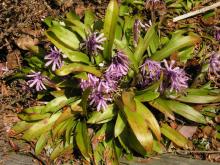


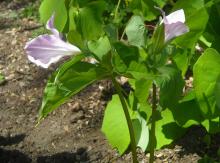
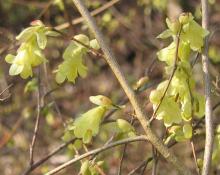
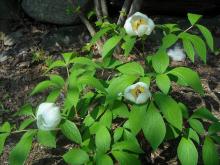
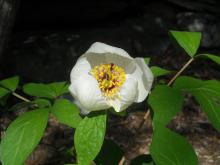

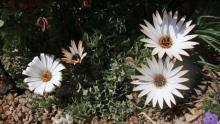





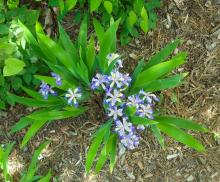





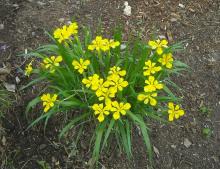







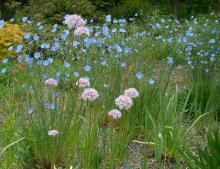





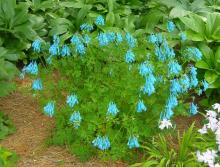
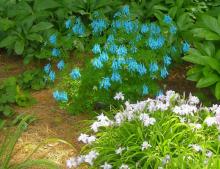




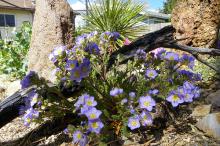




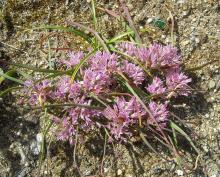
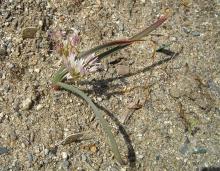

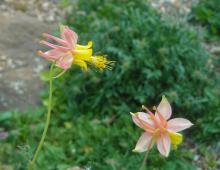
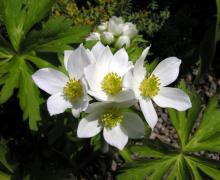

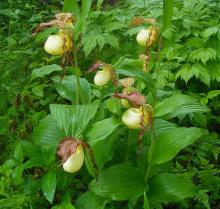




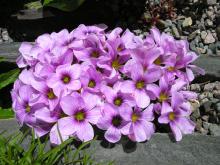



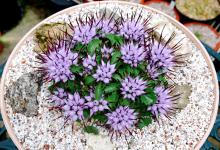


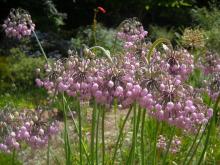
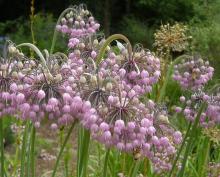


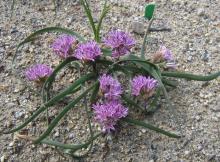

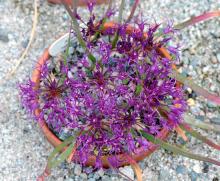






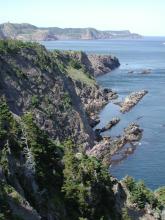




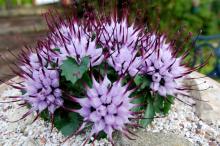
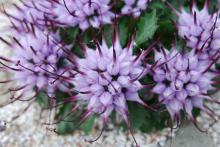
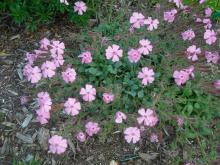



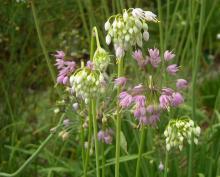





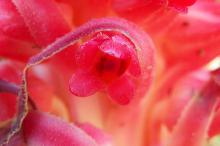
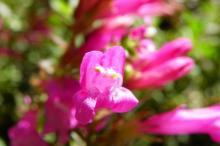
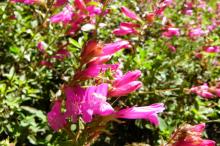







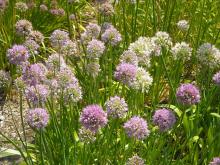
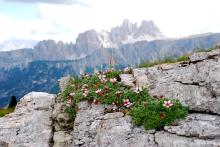

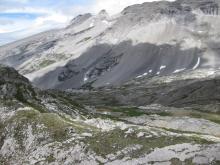
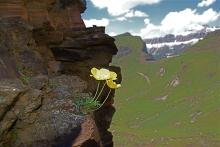




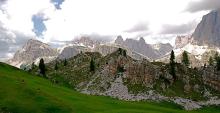
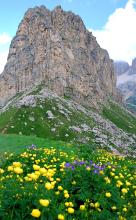
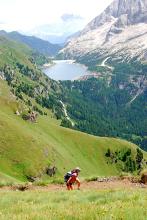
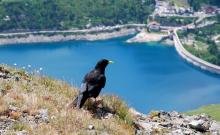
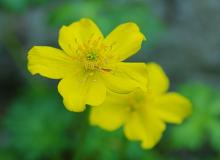


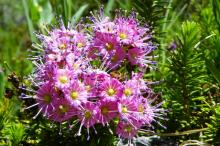


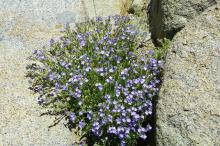
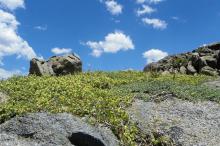


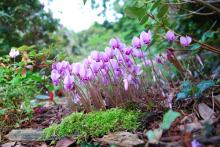



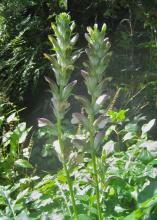

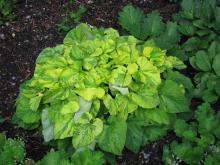

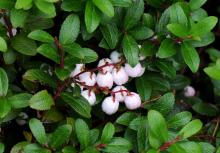
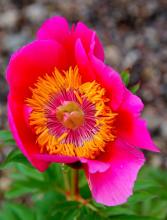

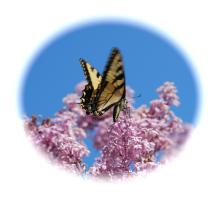
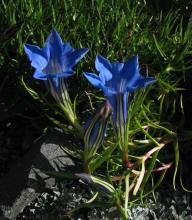
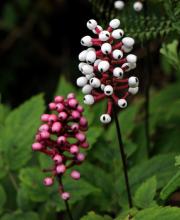
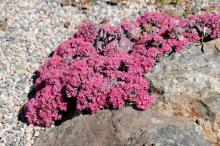








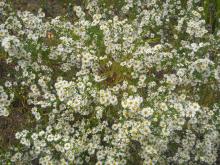

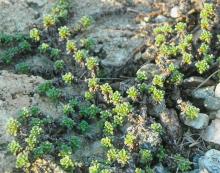
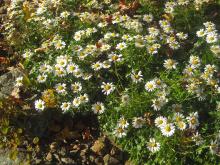
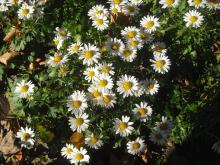
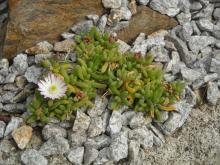






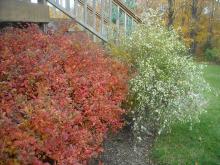
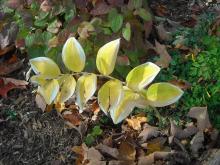



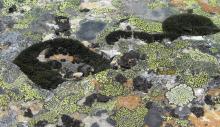



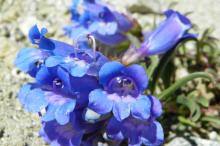

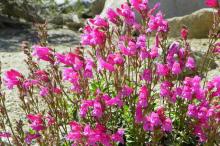

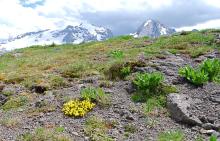
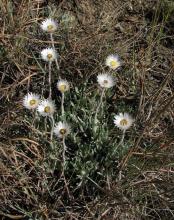
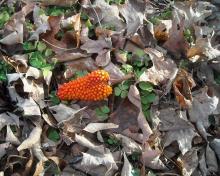

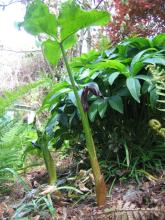
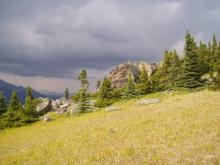


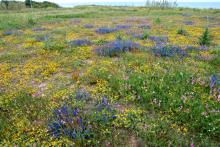

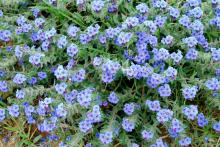
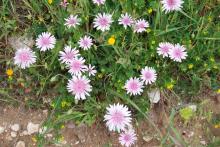

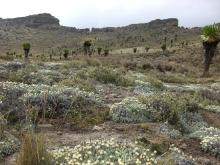







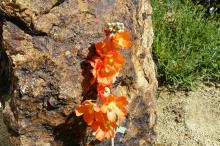
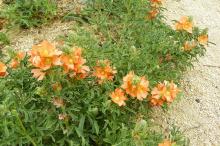


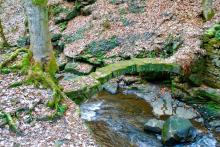


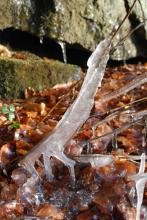
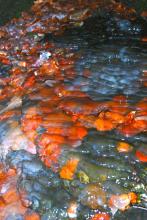
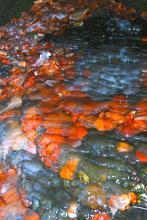


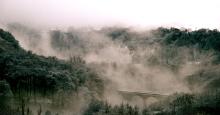

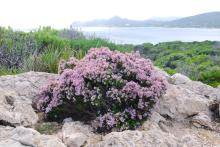
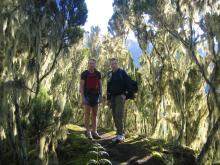
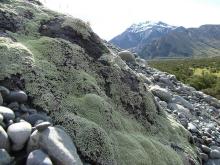
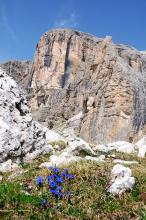




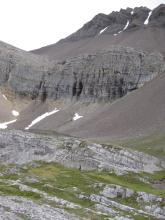



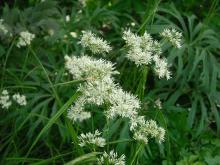
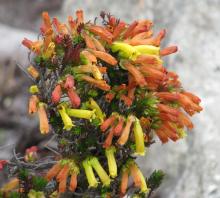

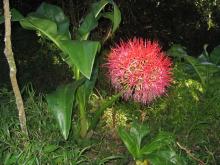


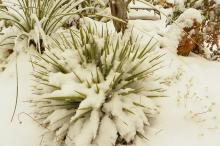
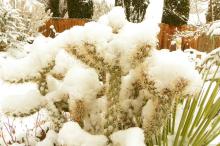

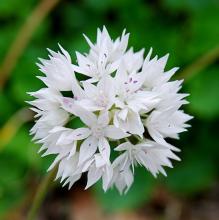
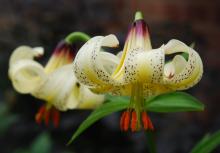
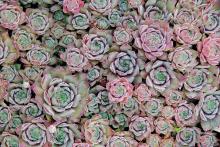


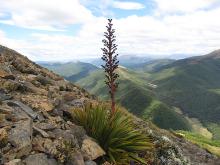
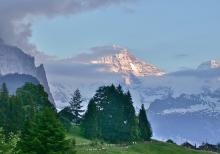
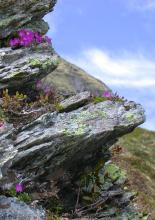


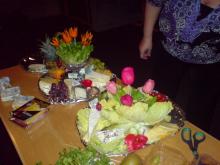
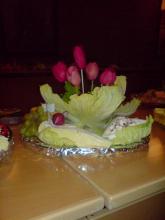







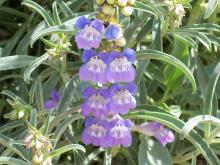

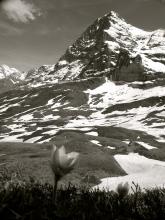


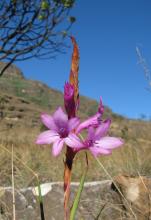

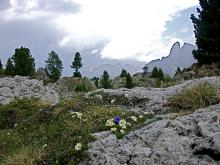
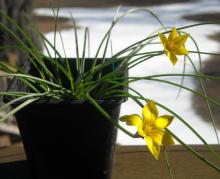
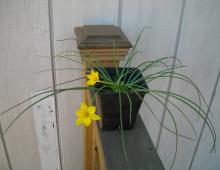
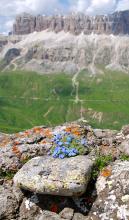
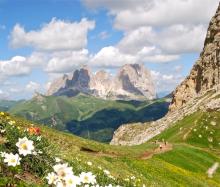
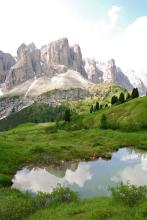



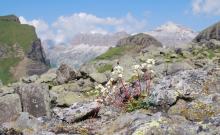





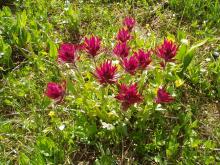


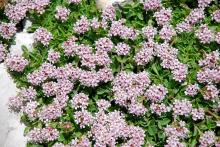
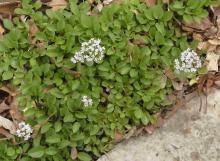
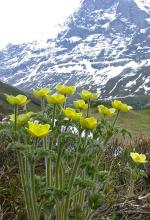


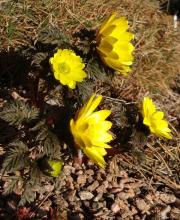

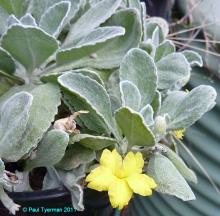
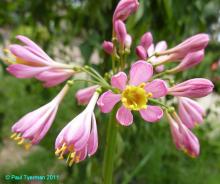

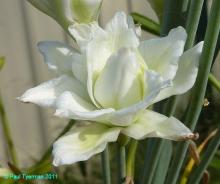
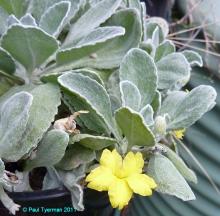

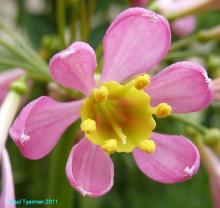
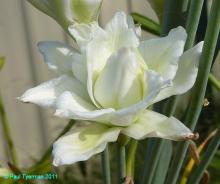

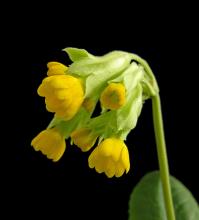

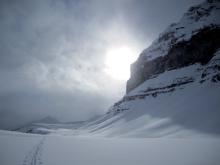
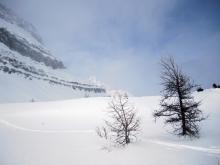

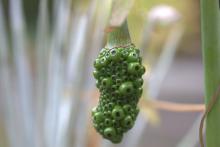
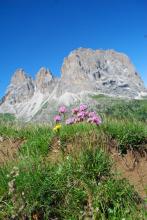




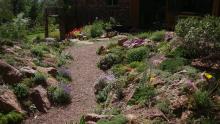




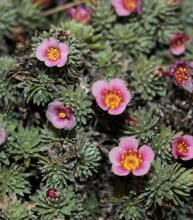
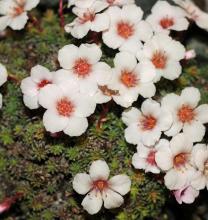





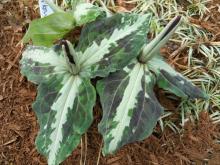



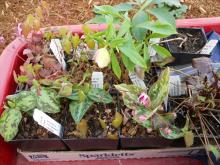

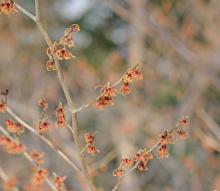
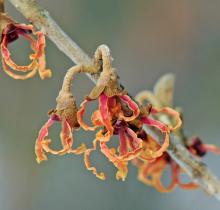





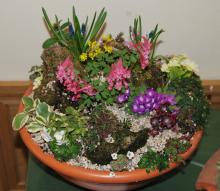

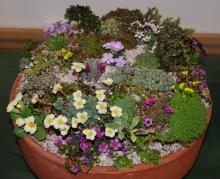
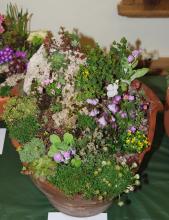




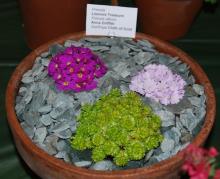


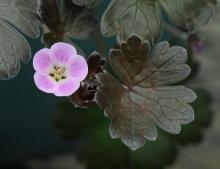
That's a great idea, Cliff! (and a most wonderful photo.) I grow a few Pulsatilla species, but not vernalis. I just received seed of it this year. Have you (or anyone) found anything different as to its germination requirements in comparison to other Pulsatillas?